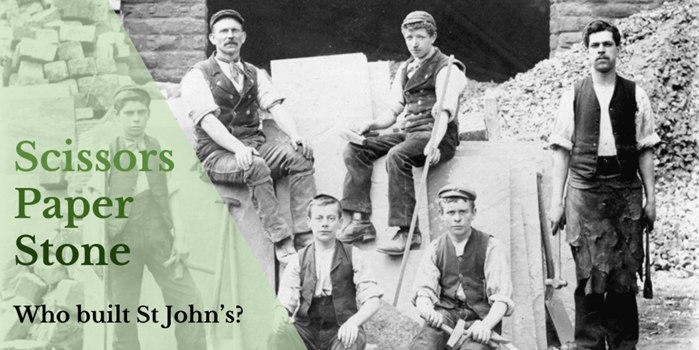
BLOG - Scissors Paper Stone (SPS)
Blog 27: The Mansions of Ranmoor
A virtual walk to discover who lived in some of the latgest properties in Ranmoor
23/10/2025
Download the PDF
Choosing which mansions to include in a virtual walk is challenging in the Ranmoor setting because there are so many of the large properties in the area. My choices were made in the end on a kinship theme, with other large houses included because we would have ‘walked past’ them. Many of these family dwellings were later converted into nurses’ homes or halls of residence for the University of Sheffield. They have each had a number of owners so I have highlighted just a few for each of the properties.
The map below shows the route we’ll be taking.
Map: maps.nls.uk
The starting point was Tapton Hall, a mansion that replaced the earlier Tapton Grove that had been built on the site in 1788 by Joseph Badger. This early mansion had also been occupied in the early 19th century by William Shore and his wife Mary, who were the grandparents of Florence Nightingale. The later property was designed by Flockton, Lee & Abbott and built for Edward Vickers in 1854. It was later owned and occupied by the Wilson family (of snuff mill fame) from 1867 – 1958 when it was subsequently purchased by the Freemasons.
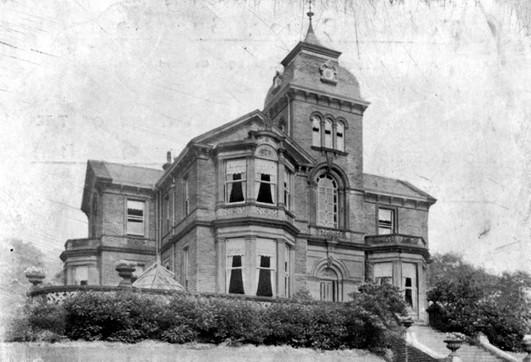 Tapton Court
Tapton Court
Tapton Court, an Italianate mansion was built in 1868 for John Henry Andrew who sold the property to Henry Steel in 1879. Steel is a fascinating character – a self-made man who made his money on the race courses of England and became a friend of Edward Prince of Wales, subsequently Edward VII, and of course the founder of Steel, Peech and Tozer, a successful steelmaking business. The house was purchased in 1933 by the J. G. Graves Charitable Trust and became a Nurses’ home until the closure of the Royal Hospital in 1978. It was then a Hall of Residence for the students of the University of Sheffield. A fire in 2010 damaged the building and it remained in a derelict condition until it was purchased and redeveloped in 2020. It has now been converted into 37 new homes.
Walking down the hill we come across Tapton Cliffe – on the corner of Shore Lane and Fulwood Road. This was built in 1864 for John Yeomans Cowlishaw, nephew of John Newton Mappin the brewer, who had moved into Birchlands, just along the road, by 1861. Yeomans was a very talented man, trained as a pearl cutter by Mappin, and his specialism was fruit knives. He also shared his uncle’s passion for art. A later resident of the house, Frank Atkin of Atkin Brothers (Silversmiths) Ltd sold the property for half its market value to the University of Sheffield to be used as a Hall of Residence for female students. It has recently been converted back into a single dwelling.
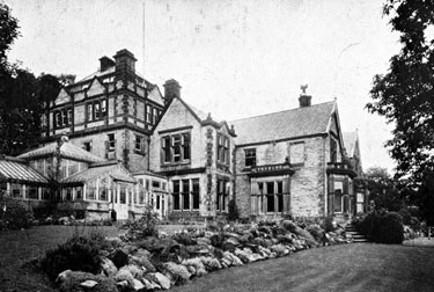 Tapton Cliffe
Tapton Cliffe
Tapton Edge, on the opposite side of the road from Tapton Cliffe, was built for Edward Firth, the younger brother of Mark. It was designed by Flockton & Abbott in 1864. Its grounds were designed by Robert Marnock (he designed the gardens of many of the Ranmoor mansions). After Firth’s death the house was purchased by William Tozer, partner of Henry Steel, who was involved in the manufacturing side of the business. Tapton Edge was then converted into a nurses’ home for the Royal Hospital in Division Street until 1972 and subsequently into a privately run home for elderly people. It is currently awaiting redevelopment.
Oakbrook is probably the second most famous of the Ranmoor mansions, after Endcliffe Hall. It was designed by William Flockton & Son and built for Mark Firth, of Thomas Firth & Sons. The property was extended in 1874-5, in time for the visit from the Prince and Princess of Wales to Sheffield – they stayed with the Firths at Oakbrook. Firth was a great philanthropist and benefactor for the people of Sheffield. He was a staunch Methodist, funding the building of the Methodist New Connexion Chapel (designed by Flockton) in Broomhill He was also a firm believer in the value of education, serving as the first vice-chairman of the Sheffield School Board in 1870, and by 1879 he had provided more than £25,000 towards the creation of what became Firth College in Leopold Street. It would be interesting to know what his views would have been about his house being used as a Roman Catholic school!
One of the advantages of doing a virtual walk is that the distance between the properties does not matter. The next house on the walk is Riverdale, which is some distance from Oakbrook. This house was built for Charles Henry Firth, the youngest brother of Mark and Edward. The 1898 sales brochure stated that the property had been “erected regardless of cost” and Pevsner describes the house as “sumptuous Gothic”. Firth and his second wife Marianne (née King) were Anglicans, and great benefactors to St John’s church. In 1881 Firth became managing director of Thomas Firth & Sons after the death of his eldest brother Mark. The house was then bought by J. G. Graves, who by 1903 employed more than 2000 people in his mail order business. The property has now been converted into apartments.
Tapton Grange is the only mansion on the “walk” that no longer exists. It was built on a three acre site for James William Harrison, who remained unmarried. The grounds were designed by Marnock. Harrison was in partnership with his brother Henry and friend William Howson who took over Thomas Sansom & Sons and rebranded it to Harrison Brothers & Howson. Henry Harrison moved to America; Howson was the Traveller and James Harrison remained in Sheffield. During his lifetime he was a great benefactor to local hospitals and schools and provided the land on which St John’s Ranmoor was built. Later owners include the National Union Teachers’ Benevolent Fund which used the house to provide a home for teachers’ orphans. It was demolished in around 1970 and the site was split into two. The northern part provided the land for the Ballard Hall of residence for the then Sheffield Polytechnic; the southern part was developed as Oakbrook View, which included a hostel for the council’s Social Services Dept. Both of these developments were demolished some time ago and the land has now been redeveloped for private residences.
 Tapton Grange
Tapton Grange
Tapton Park Road was created in 1863 by the trustees of the Boys’ Charity school. Moordale was built on land at the junction of Tapton Park Road and Fulwood Road, and purchased by James Nicholson. The house was probably designed by Hill & Swann. Nicholson worked with his brothers William and John in John Nicholson & Sons, cutlery manufacturers in Mowbray Street. The firm had been established by their father. James Nicholson moved to 7 Broomfield Road in around 1873 after the death of his first wife, Harriet. After being converted into offices for various companies the property became the Fulwood Inn in 1999, now known as The Florentine.
The property named Tapton Park was built in a two acre site on the north side of Tapton Park Road. It was owned by William Howson, business partner of James Harrison who lived on the south side of the road. Howson devoted himself to the business until his death in 1884. His son George also worked for Harrison Brothers and Howson but was more active outside the company, becoming Master Cutler in 1893. The property remained in family hands until 1936 when it became the head office of General Refractories. It is now known as Tapton Park House and is private residences.
Our final mansion on the walk is Thornbury, built in 1865 for Frederick Thorpe Mappin, the eldest son of Joseph Mappin and his wife Mary (née Thorpe). After the death of his father Frederick took over the family business (Joseph Mappin & Son) and looked after his three younger brothers (Edward, Joseph Charles and John Newton (the younger)). Frederick had married Mary Crossley Wilson in 1845, daughter of John Wilson a cutler, who lived at Oakholme. When John Newton (the younger) became a partner in the family firm in 1857 disputes arose and the firm was dissolved. Frederick became the senior partner in Thomas Turton & Sons; Edward & Joseph formed the partnership Mappin Brothers and John Newton moved to London, met and married Ellen Elizabeth Webb in 1860 and went into partnership with her brother George Webb jun. and they traded as Mappin & Webb in a partnership that flourished.
Frederick & Mary’s middle son Wilson Mappin married Emily Kingsford Wilson in 1876, daughter of George Wilson of Tapton Hall. Frederick Mappin continued to progress both locally and nationally. He became a town magistrate in 1870, Town Trustee from 1871 and became Mayor in 1877. He was elected to parliament in 1880, representing East Retford and later was Liberal MP for the Hallamshire Division of the West Riding of Yorkshire from 1885-1905 after his original parliamentary seat was abolished. He became a Pro-Chancellor for the new University of Sheffield in 1905 and the Faculty of Engineering is now housed in the Sir Frederick Mappin Building, in Mappin Street, renamed in his honour. He died in 1910 and Thornbury was then occupied by Wilson & Emily Mappin. Wilson died in 1925; Emily died in 1940. After her death the house became an annexe for the Children’s Hospital until in 1991 when it reopened as a private hospital.
So, we have now come full circle. All the properties started as mansions for the steel magnates of the mid-19th century and all but one still exist, albeit rarely in the same format as a single residence:
• Tapton Hall – Masonic Lodge
• Tapton Court - residential apartments
• Tapton Cliffe - being developed into a single residential property
• Tapton Edge -awaiting development
• Oakbrook – Notre Dame School
• Riverdale – private apartments, with other apartments in the grounds
• Tapton Grange – demolished and the land developed for housing
• Moordale – The Florentine
• Tapton Park – residential
• Thornbury -private hospital
This is of course just one walk of many possible strolls around the suburb of Ranmoor which is rich in such properties.
Judith Pitchforth
20 October 2025
Blog 26: A Walk Down Ranmoor Market
Part Two: Ranmoor’s Shops, People and Public Houses
01/10/2025
Download the PDF
This week’s blog is the second instalment of our two-part commentary that accompanied our summer walking tours ‘A Walk Down Ranmoor Market’. This part focusses on Ranmoor’s shops, people and public houses.
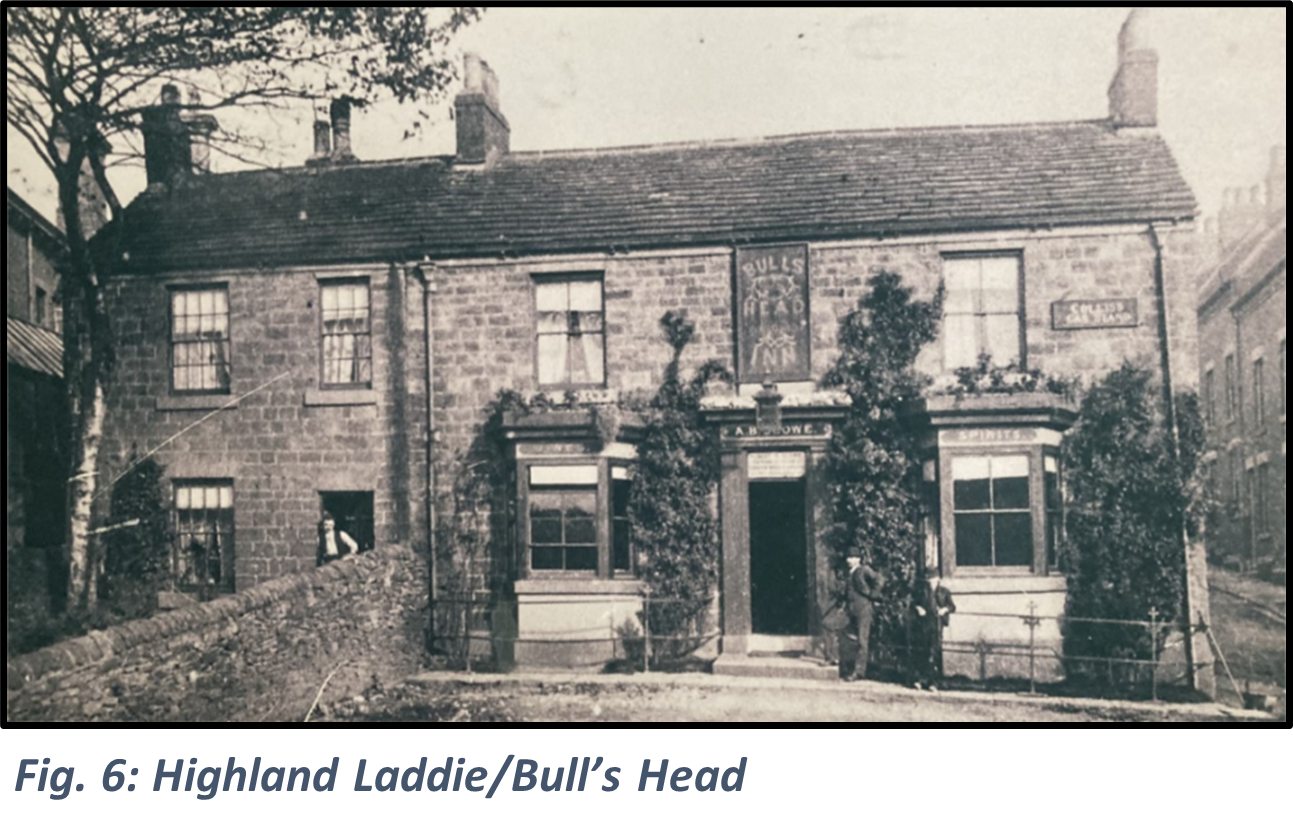
This image, probably from around the late 1890s, shows us the Bull’s Head occupied two of what must have been originally a short terrace of three cottages. This reflects the pub’s origins as a private house. Records show that around the mid-nineteenth century, pen and pocketknife manufacturer Jonathan Swann lived here with his family and that they added to their income by selling beer. However, it seems that the next occupants, took the business on as an established public house. This was Charles Slowe (1866 - 1880s) and his family. Charles had married his wife Catherine at St John’s, and their daughter would go on do so too. It was also Charles who changed the name of the establishment to the Bulls’ Head.
Returning to the photograph, it may be possible to make out A.B. SLOWE above the door. This was Albert Benjamin Slowe, who took on the proprietorship of the pub from his father in 1885. Albert advertised his establishment as ‘a First-class Old-Established Country Inn, situated … amidst the most charming scenery that Sheffield possesses ...[with] Cabs, Billiards, and Cricket Ground attached’.
The western third of the building remained as a cottage until around 1900 and we can see that there’s a wall dividing the front garden from the pub’s front yard and a man is leaning in his doorway. He’s mirrored by the two people outside the pub – one with a bowler and moustache posing with one foot on the doorstep while the other looks like a youngster, standing with his thumbs in his waistcoat pockets. Marr Terrace is just visible on the right.
There’s a sign for COLLIS’ CAB STAND next to the window on the right of the pub and figures 7 and 8 illustrate how the Bull’s Head served as a transport hub between the 1850s and early 1900s.
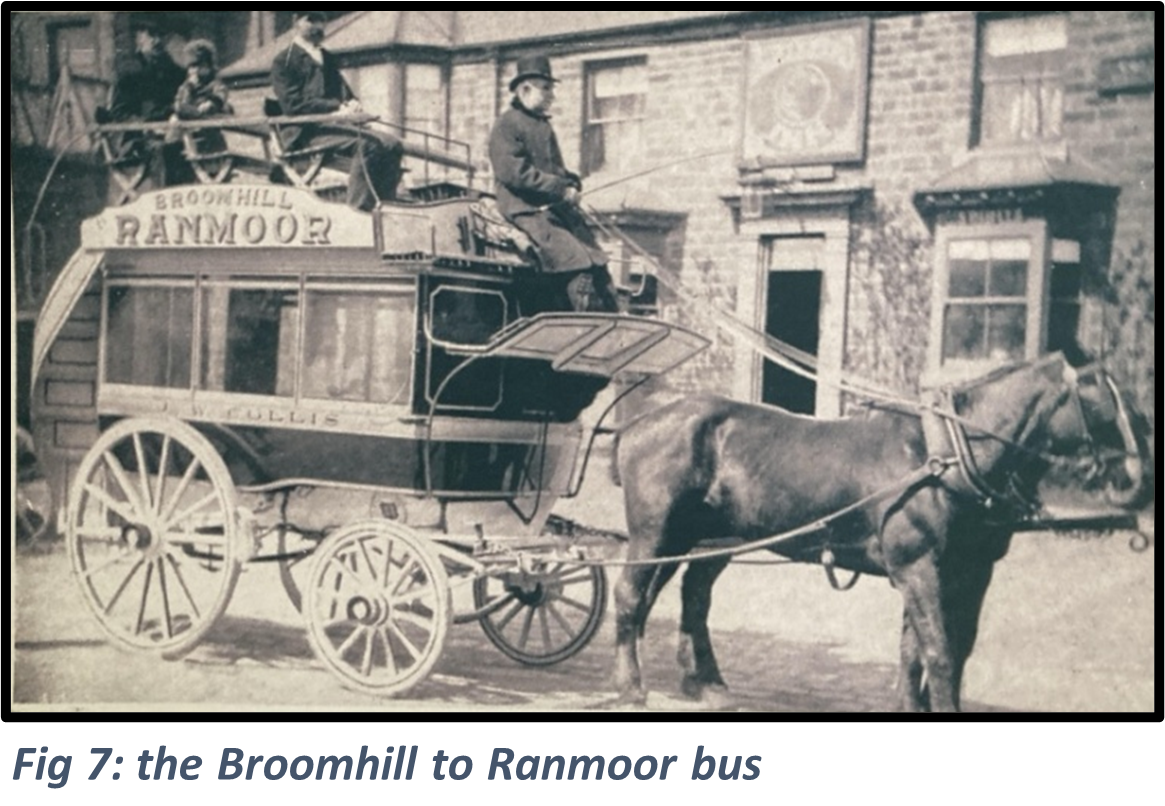
This service ran between the Bull’s Head at Ranmoor Market and the York Hotel in Broomhill – a journey of about a mile. Look closely and you will see on top a little boy standing clutching the rail. His name was Joseph Cyril Lockwood and he later recognised himself in this picture when it was included in a book published in the 1940s.
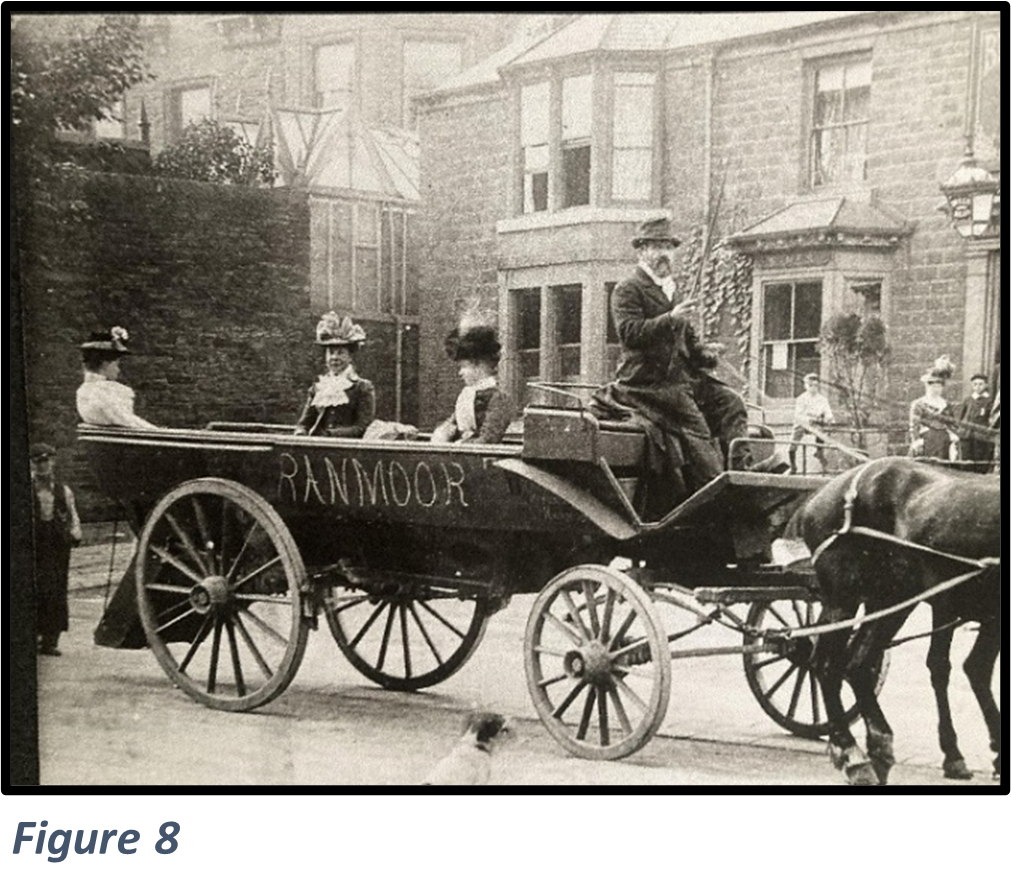
Figure 8 shows the driver posing, (perhaps a little begrudgingly), with his whip raised. The stance of the horse’s rear legs suggest it is resting; maybe the horse and driver had been in that position for some time while the photographer was setting up his shot. The ladies in the carriage look as if they’re dressed up for the occasion, as do the onlookers standing by the pub entrance. A boy is standing to the rear their carriage, looking as if he’s enjoying the scene, as does the little dog in the centre foreground. Perhaps this picture was taken at the start of a special holiday outing.
The photograph in figure 9 was probably taken around the same time, (perhaps the same day), as figures 4 and 5 with the same tramlines and overhead cable supports visible and the same bare wintery branches from overhanging trees. Nearest to the camera is a row of three shops which provide fine examples of Victorian shopfront design. Their beautiful window displays are crammed with enticing goods. These buildings retain their traditional features to this day and are best viewed from across the road. From this distance, you can appreciate how the carved stone pilasters with their floral details provide a balanced frame for the shopfronts.
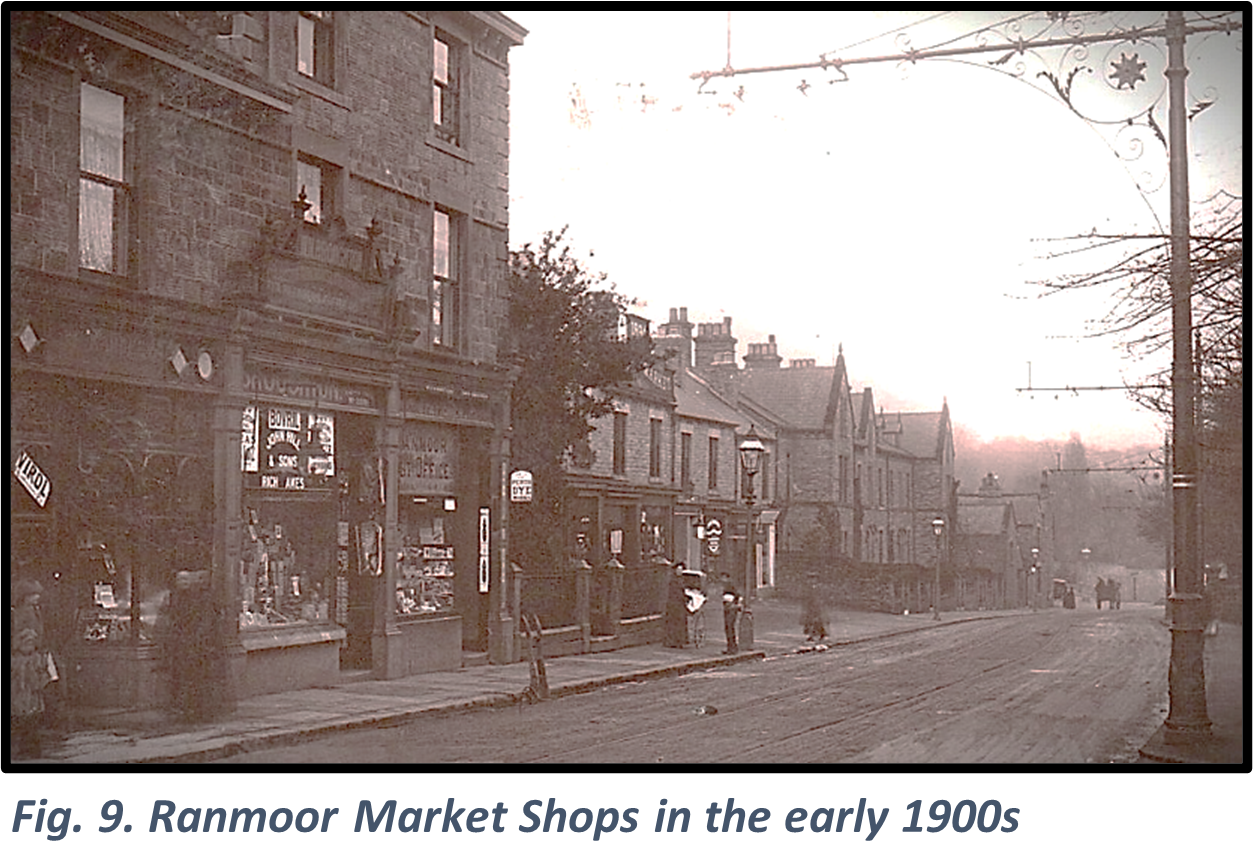
On the left edge of the photo is Eardley’s Chemist, perhaps the most elegant of the three. An advert for VIROL stands out. Virol was developed by the makers of Bovril in 1899 and was a popular food supplement during the early 20th century, promoted with the slogan ‘Children Thrive on Virol’. On the fascia above the chemist’s window there are three pale shapes - two diamonds and a circle. Still visible today, these shapes contain the date 1879 and what may be images of apothecaries.
In the middle is Broughton’s Grocers: ‘Provision Merchants and Italian Warehousemen’. ‘BOVRIL’ and ‘PICK AXES’ are advertised and a wooden hand truck is propped up against the kerb.
The final shop of the trio, (furthest away from us in the picture), is the Post Office. There is a sign for DYE attached at right angles to the end column. Prior to this, it had been one of the outlets for Ranmoor’s Wildgoose brothers who were the original owners of these shops and who sold meat, fish, game and poultry. This end unit became a Post Office and stationers in the early 1890s.
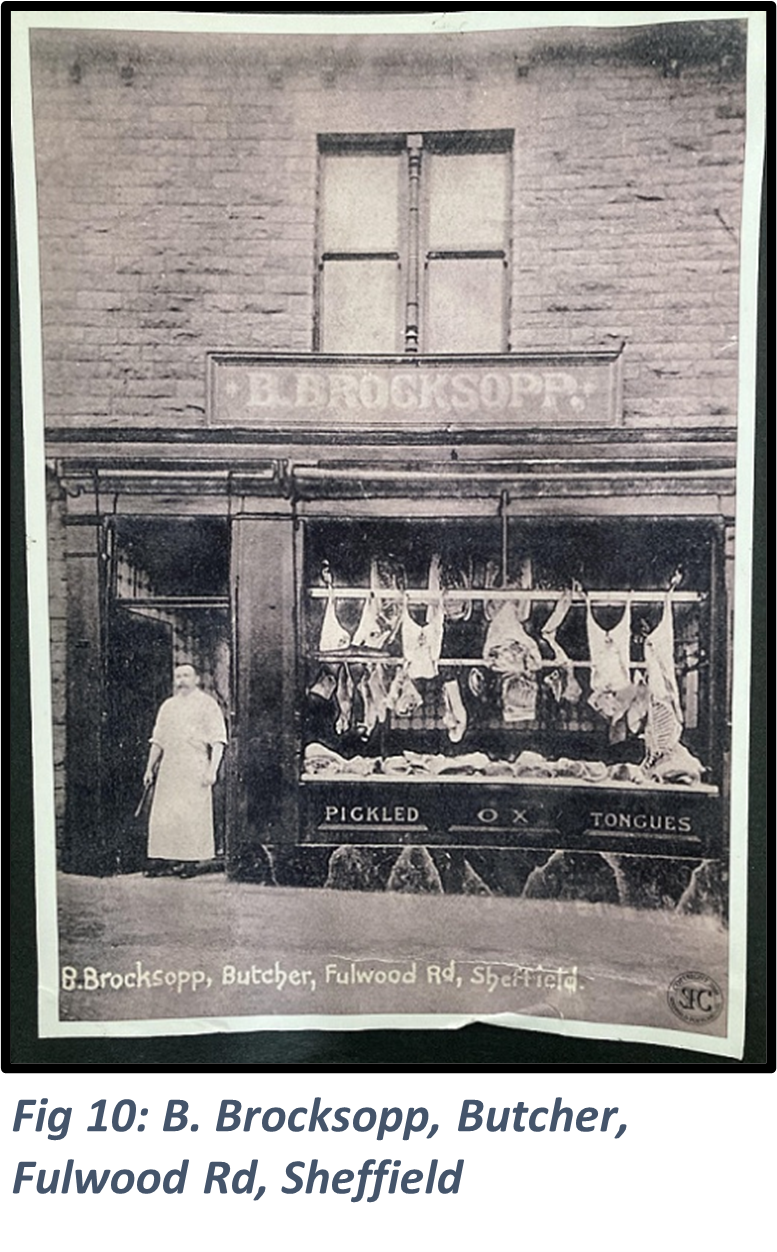
We saw Brocksopp’s butchers earlier in figure 5. This time we see Arthur Benjamin Brocksopp (1867-c.1945) standing in the doorway. Benjamin Brocksopp and his family, (which included his wife Susannah and six children), lived here above their shop from 1895-1936. Brocksopp was from a family of butchers based in Broomhill who moved west to set up business in the new Ranmoor Market. Brocksopp’s was the first in a long line of butchers trading from number 370 Fulwood Road, continuing with Chris Beech, whose name now stands above the shop window. The steel runners for hanging the meat carcasses seen in the photo are still in situ. The Brocksopp family grave is in Fulwood Churchyard.
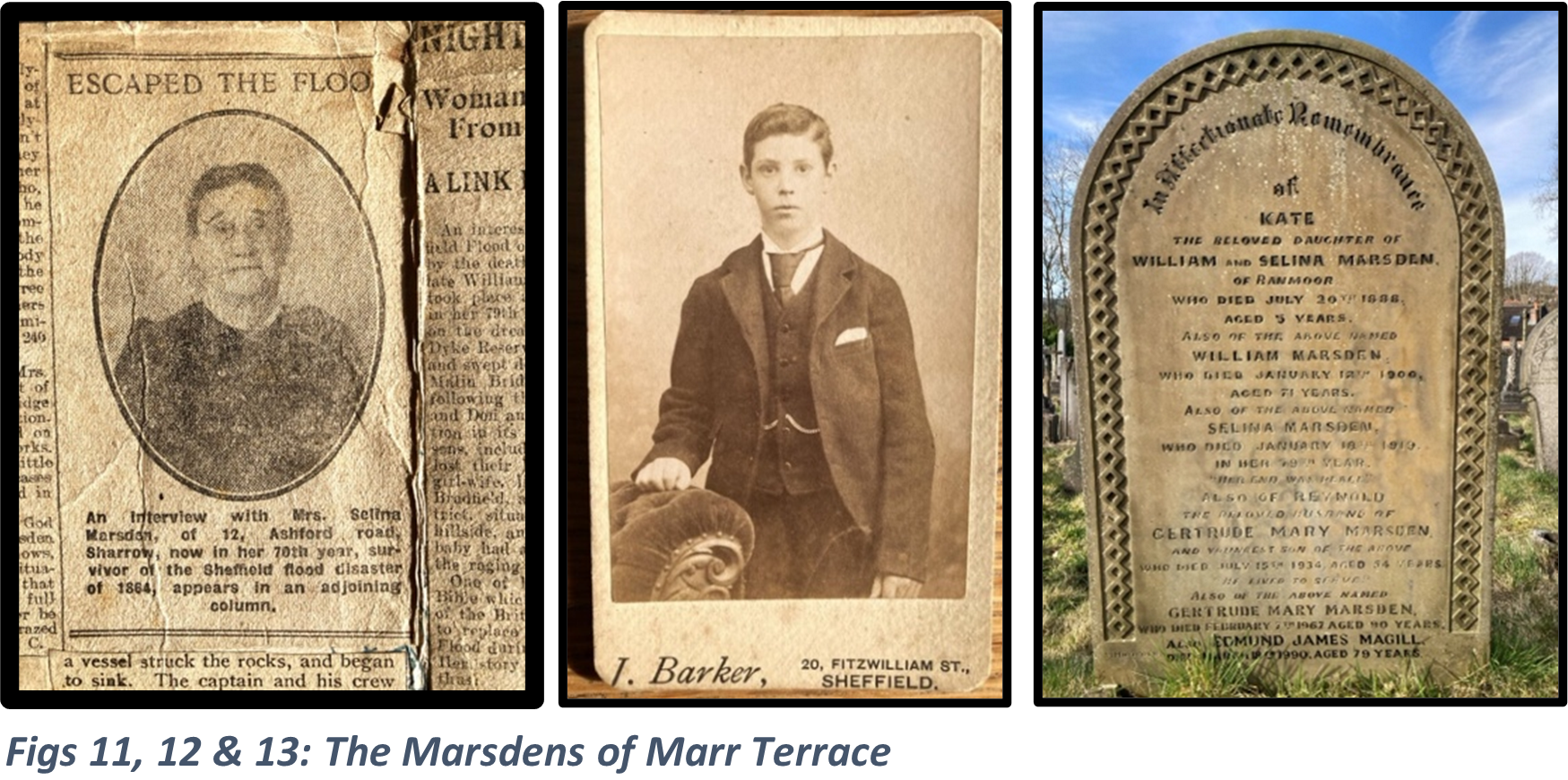
These images relate to the Marsden family of Marr Terrace. The Marsdens are a family with roots and branches across the old Upper Hallam area. Several Marsden families lived on the sloping terraced street which was originally called ‘Market Place’. Selina and William Marsden raised their family of nine children right at the top of Market Place at number 41 between 1880s and the 1900s. William was a stone mason, perhaps employed in the construction of St. John’s Church, and all five of his sons would go on to follow their father’s trade. In 1864 Selina (aged 23), William (aged 37) and their two-year-old son John were living on the edge of Dale Dyke Dam when it burst. The newspaper article on the left is from an interview with Selina, (aged 70 in the photograph), where she recounts their terrifying and brave escape from the flood waters some fifty years previously. Their youngest son Reynald (1879 – 1934) is pictured as he begins his adult life aged 14, when he was living at Marr Terrace. To the right of Reynald is a picture of the family gravestone in Fulwood Churchyard. The inscription at the top remembers Selina and William’s youngest child, Kate, who died aged just five.
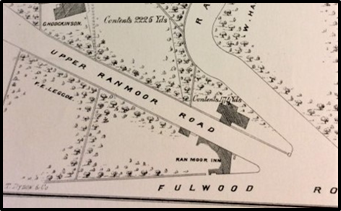
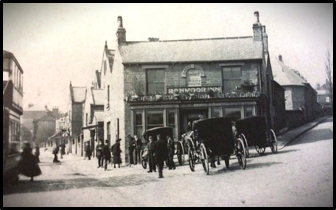
Fig 14: map 1875 Fig 15: Early 1900s showing two forms of transport
The Ranmoor Inn: the final stop
Our tour of Ranmoor Market concluded with a look at the Ranmoor Inn. Facing east towards town and welcoming travellers passing along the road to Fulwood, the story of the Ranmoor Inn mirrors that of its west end-counterpart, the Bull’s Head. It started as a ‘beerhouse’ in the 1850s, principally run by Sarah Worrall whose husband James was a bootmaker. After the death of Sarah and James in the 1860s, their son George took over, transforming their private house into a public house, licensed to sell alcohol and looking like the building we see today.
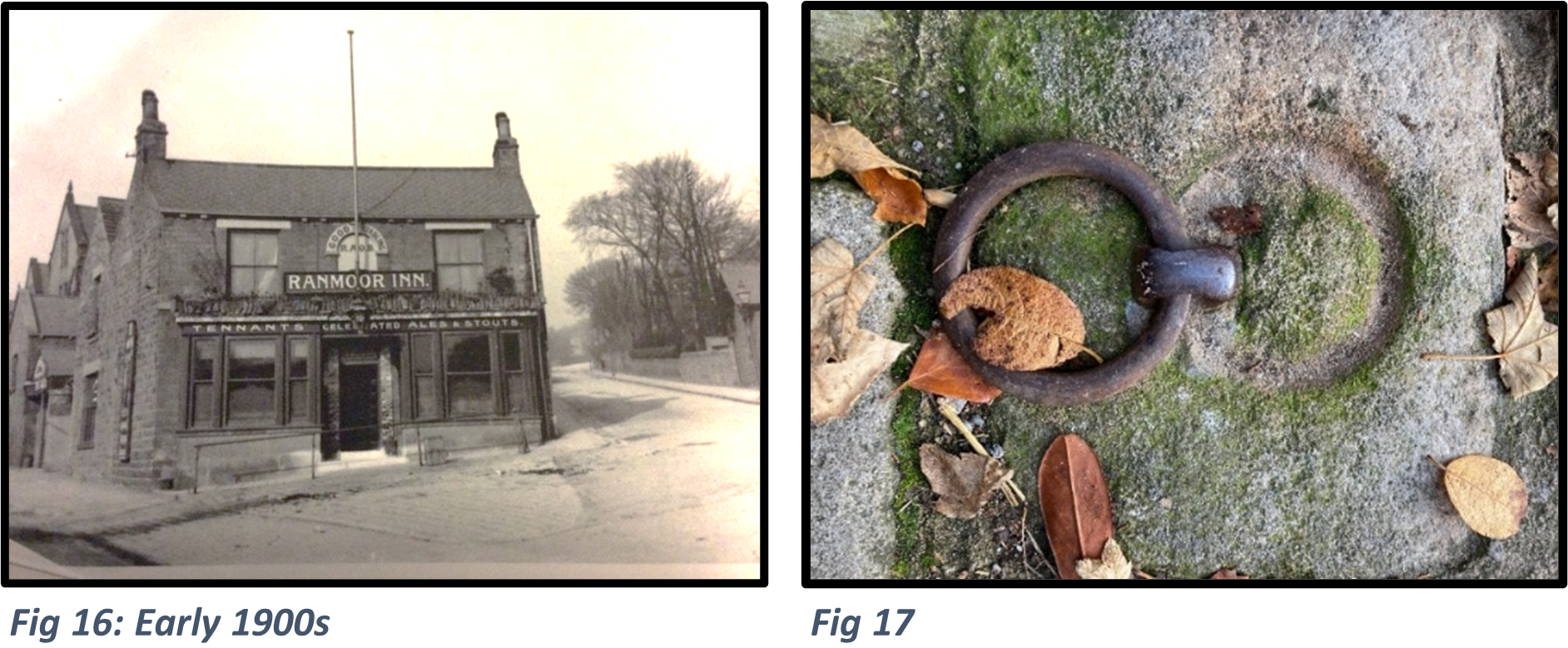
This sale plan shows how the pub stood almost alone on its spur of land in 1875. There is the distinctive shape of a church across the road - Ranmoor St. John’s was built on this site four years later.
The image above suggests the hustle and bustle around the inn in the early 1900s and captures a time of transition in transport. To the left, a woman is stepping onto a tram while the centre of the photograph is dominated by horse-drawn cabs waiting for fares.
Our look at Ranmoor Market concludes with a quieter scene from the early 1900s. The Ranmoor Inn has a flagpole, while the arched sign reads GOOD STABLING and RAOB. The letters stand for Royal Antediluvian Order of Buffaloes which was a philanthropic organisation for men and their families.
Set into the floor outside the pub, this old iron ring was used to lower beer casks into the cellar.
Conclusion
The guided walk on which this piece is based invited us to ‘meet’ past residents of Ranmoor Market. As well as looking back to historical records for information, I also sought the perspectives of the present Ranmoor shops community which included current residents, traders and their living descendants. Their contributions brought life and warmth to the project and highlighted the threads connecting the past to the present. I am very grateful for their help with my research.
Jane Bartholomew
21 September 2025
Bibliography
Doe, V. (1976). Some Developments in Middle Class Housing in Sheffield 1830-1875. Pollard, S. & Holmes, C. (eds.) 1976. Essays in the Economic and Social History of South Yorkshire. South Yorkshire County Council. 174-186.
National Library of Scotland: https://maps.nls.uk/
The Ranmoor Society: https://ranmoorsociety.uk/
Reid, C. (1976). Middle Class Values and Working Class Culture in Nineteenth Century Sheffield – The Pursuit of Respectability. S. Pollard and C. Holmes (eds.) 1976. Essays in the Economic and Social History of South Yorkshire 1976. South Yorkshire County Council. 275-295.
Warr, P. (2009). The Growth of Ranmoor, Hangingwater and Nether Green. Northend.
Blog 25: A Walk Down Ranmoor Market
17th September 2025
Download the PDF
Introduction
‘Ranmoor Shops’ is a familiar geographical reference point for many of us who live locally but if we were to say we were going to ‘Ranmoor Market’, we might be met with blank expressions. Yet this was the name given to Ranmoor’s collection of shops over the later Victorian period. As someone with an interest in local history, I was curious to find out more about this short stretch of Fulwood Road: who lived and worked here during this later Victorian and early Edwardian period? Through my research, a picture the community emerged, providing an insight into Ranmoor society during a period when this rural and somewhat remote part of Upper Hallam was becoming an upmarket suburb.
It became apparent that Ranmoor Market would be an ideal focus for guided walks as part of the Scissors Paper Stone Community History Project. The following is a two-part commentary on the images used in a booklet to accompany these walks and presents a selection of the material that was covered.
Part One: background and overview of Ranmoor Market
The following three maps give an indication of how the area developed through the Victorian and Edwardian periods.
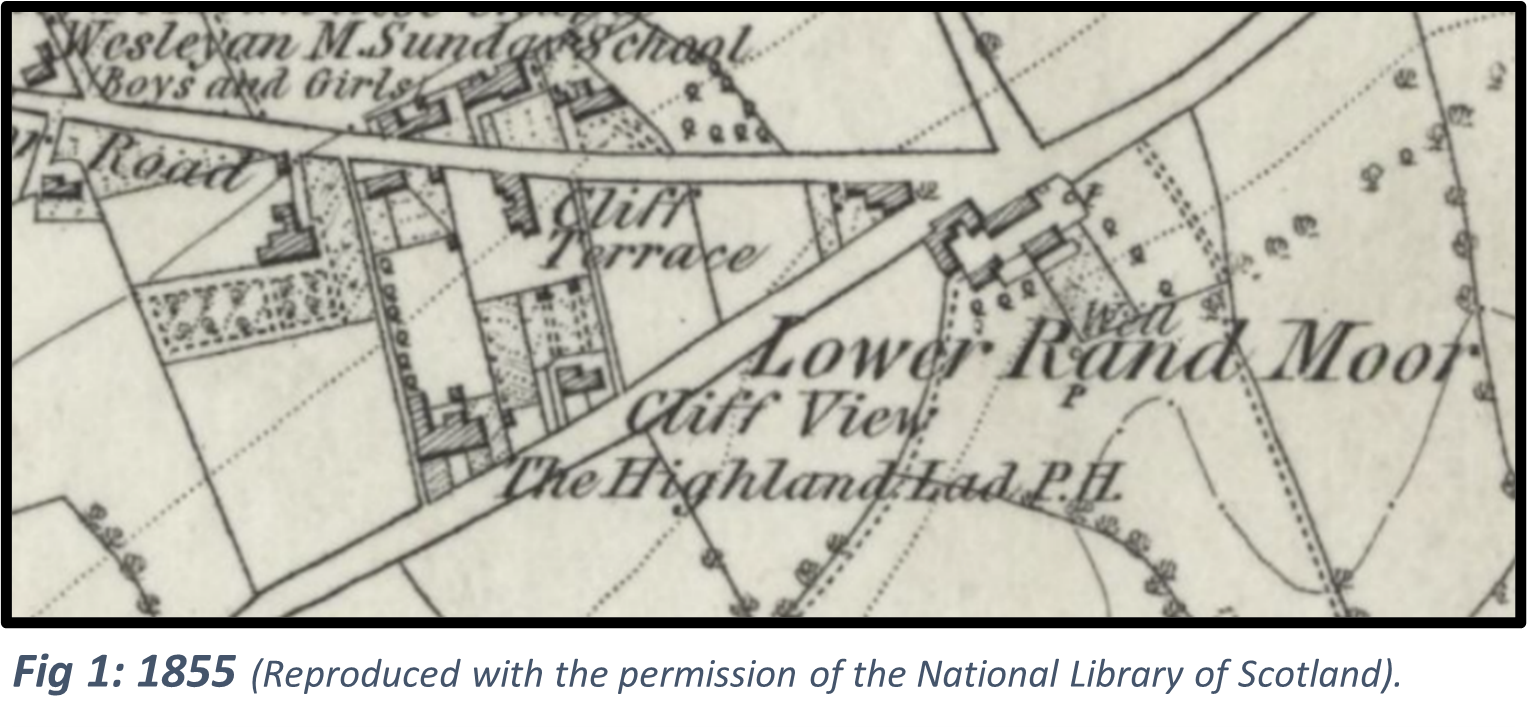
This map tells us that we are looking at Lower Rand Moor. ‘Rand’ is derived from an Old English word meaning ‘brink, bank’ or ‘edge’ so the place name may reflect the once open landscape which included some sort of edge or cliff. Just above the word ‘Rand’ you will see what are probably farm buildings, a well, fields and orchards. These belonged to Joseph Ibbotson, who also rented a grinding wheel on what is now known as Ibbotson’s Dam in Bingham Park. The building across the road which nestles into the point of a triangle of land will soon become known as the Ranmoor Inn. However, it’s not recorded as a public house on this map. Looking to the left of this, you will see the words Cliff View and Cliff Terrace. Judging by local place names, the ‘cliff’ was clearly a significant feature of the landscape in Victorian Ranmoor. Cliff View, (now the West 10 Wine Bar), was the house and grocer’s shop belonging to local farmer Isaac Deakin (1789-1859). Cliff Terrace was to be renamed Deakins Walk in the early twentieth century, (losing its apostrophe somewhere along the way), to recognise Deakin’s significance to the area. Not only was Deakin a pillar of the community but he was also very likely Ranmoor’s first shopkeeper, setting up his business here in the 1840s.
Left of Cliff View it reads The Highland Lad P.H., indicating that this former ‘beerhouse’ has already become established as a pub. It will soon be known as The Bull’s Head. Moving clockwise to the top left of the map, you will see the words Wesleyan M. Sunday School Boys and Girls. This would have been the local school for many of the children living in the Ranmoor Market area.
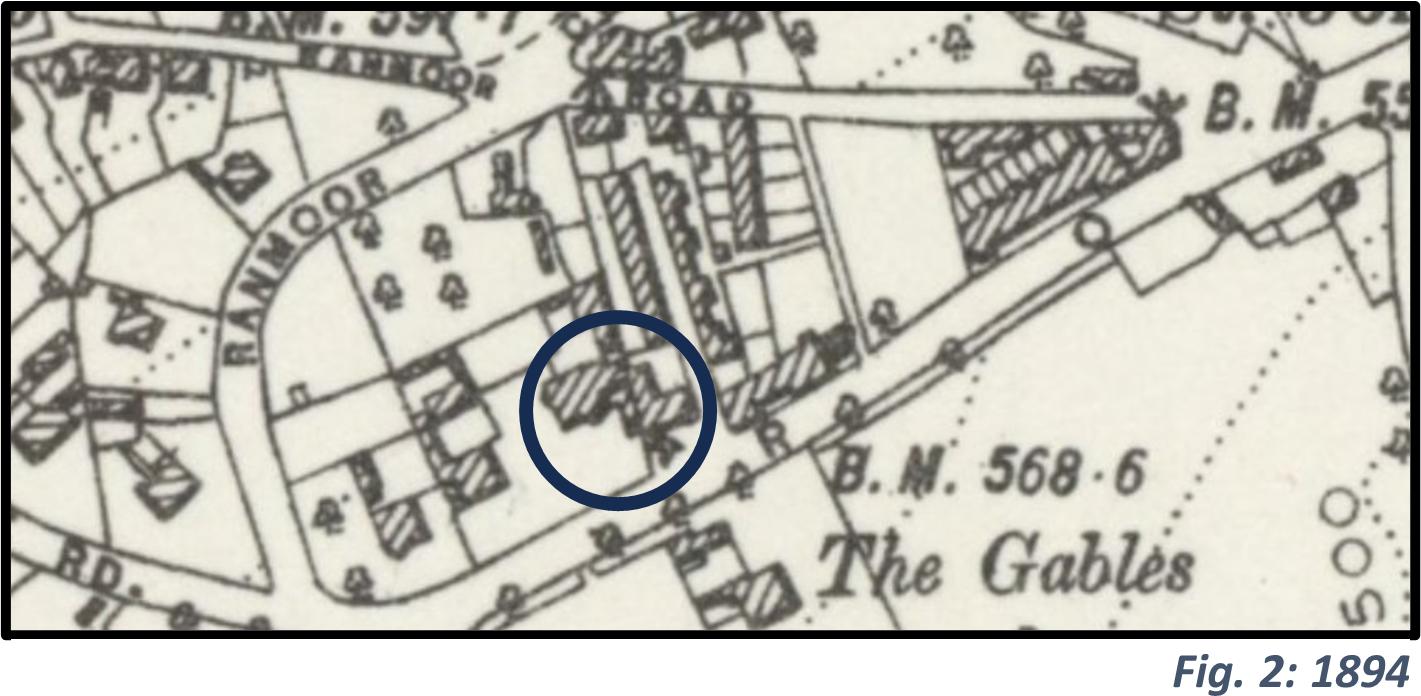
This map reflects the impact of Sheffield’s industrial revolution on this little rural area. During the second half of the nineteenth century, owners of Sheffield’s businesses and factories were drawn towards areas such as Ranmoor to escape the pollution and crowding of the town. Perhaps the most notable pioneers of this westerly migration were Sir John Brown of Endcliffe Hall and Mark Firth of Oak Brook. They were followed by other wealthy families who lived in the villa-residences built during the later Victorian and early Edwardian periods. An example is Rockmount which can be seen to the immediate left of the Bull’s Head (both circled), towards the bottom middle of the map. In addition, existing buildings such as the Ranmoor Inn, (in its triangle over to the right), have been developed and roads have appeared. In particular, the straight block of Marr Terrace is now visible above and to the right of the Bull’s Head, running between Fulwood and Ranmoor Roads. This narrow street of red-brick terraces was built in the 1870s partly with the intention of appealing to people who might be employed as domestic servants in the area. Census returns tell us that a significant proportion of gardeners, grooms and coachmen lived on Marr Terrace during the late nineteenth century.
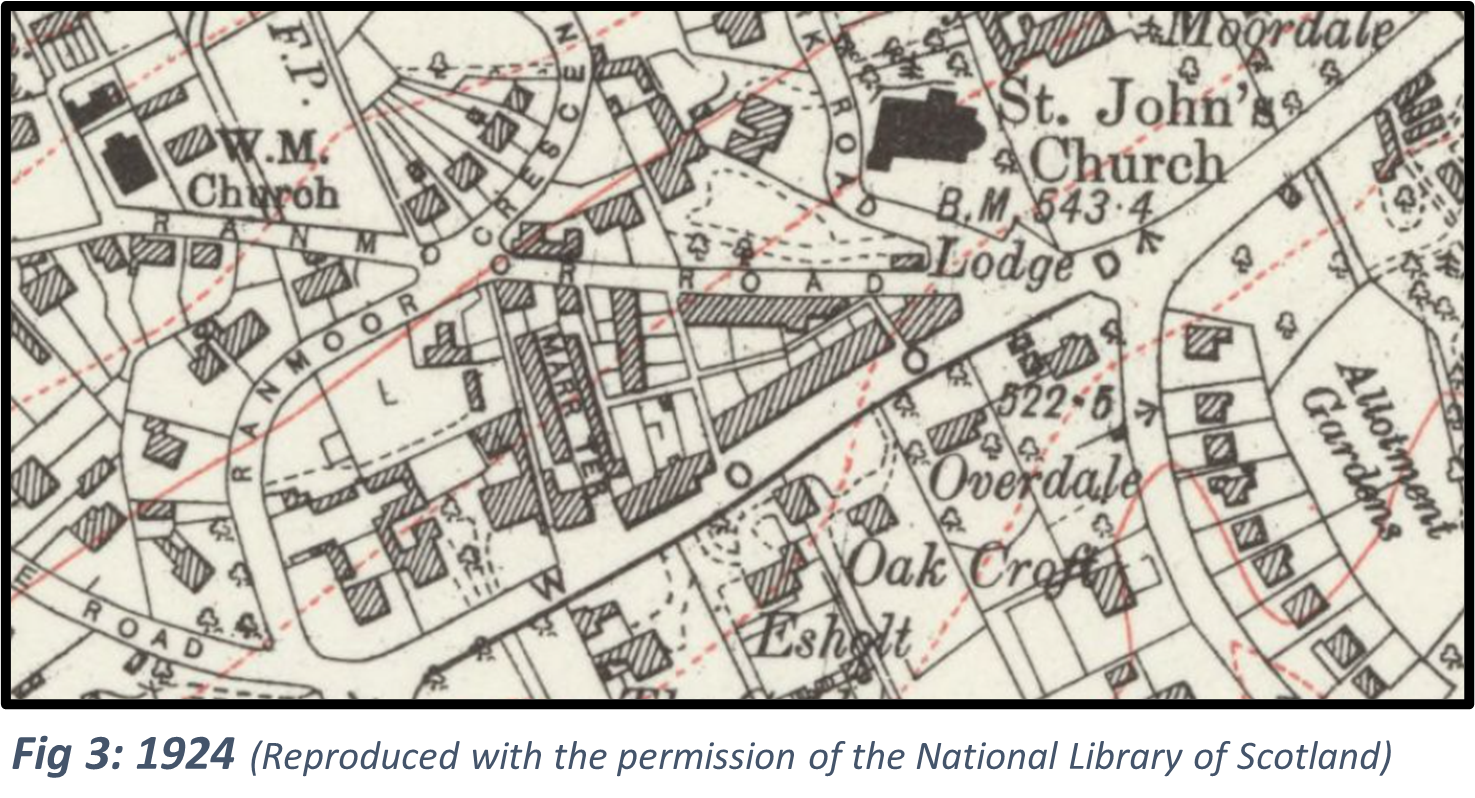
This shows us that by the early twentieth century, the area had grown to closely resemble what it looks like today. The trio of Overdale, Oak Croft and Esholt are now visible. These are examples of ‘that architectural curiosity – the Victorian villa- residence’ and domestic servants were employed in all three throughout our focus period. Another impressive house from this era, Moordale, is just discernible in the top right of the map. St John’s Church, out of the area of the previous map, has a strong presence and the former Sunday School for Boys and Girls is referred to simply as W. M. Church. Most local children would now be attending the Ranmoor Council School, (now Nether Green Junior School), which opened in the early 1900s. Marr Terrace is marked on this map with the letters MARR TER.

Fig. 4: The west end of Ranmoor Market
Ranmoor Market at street level
The tram tracks and ornamented posts for overhead cables tell us that the following photographs must have been taken at some point after 1901when tram routes reached Ranmoor. However, both images show how horse-drawn transport was still the norm, as was the use of shop awnings.
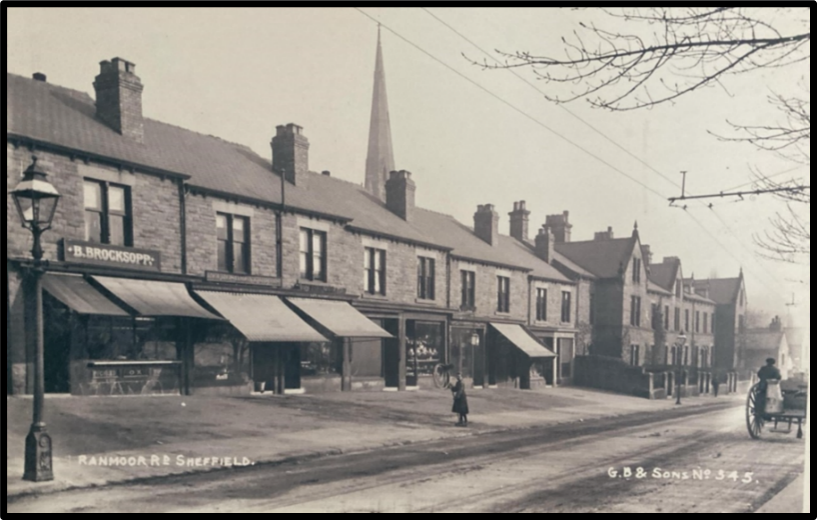
Fig. 5: The east end of Ranmoor Market
The edge of the Bull’s Head and entrance to Marr Terrace can be seen to the left of this photograph, followed by the first phase of shops which were built from around the 1850s to the 1880s. The spire of Ranmoor St. John’s can be made out behind the chimneys.
This image shows the set of shops running towards the Ranmoor Inn with the spire of St. John’s standing tall in the background. These were built towards the end of the nineteenth century. ‘B. BROCKSOPP’ stands out in pale lettering above the display window with ‘PICKLED OX TONGUES’ advertised below. This is Benjamin Brocksopp’s butcher’s shop from which he traded over the period 1895 to 1936. Just below the centre of the picture, a woman can be seen sweeping the pavement – presumably she worked at one of the shops. A man in a cap is driving a cart east down Fulwood Road. It seems to be carrying a milk churn, probably supplied by one of the many farms in the area. Lining the road between the Market shops and the Ranmoor Inn is the symmetrical residential row of Ranmoor Terrace, (built in the 1870s), with its pinnacles topping the apex of each gable end.
These scenes look strikingly familiar: very little has changed in terms of the streetscape and there is even continuity through the businesses which trade to this day.
After this overview of the Ranmoor Market area, Part 2 will go on to focus on some of its people, shops and pubs.
Jane Bartholomew
14 September 2025
Edwards, A. M. (1981). The design of suburbia: a critical study in environmental history. Pembridge Press.
Blog 24: A Simple Will
2nd September 2025
Download here
On Saturday 13 September, for the Heritage Open Days festival, Sue Roe, Mary Grover and I are giving a talk, ‘The Wills of Ranmoor Residents: Who Gave What to Whom’, based on our research into the lives and legacies of the parishioners who rented pews in 1890. If you want to come along (and we would love to see you), you’ll find the details below.
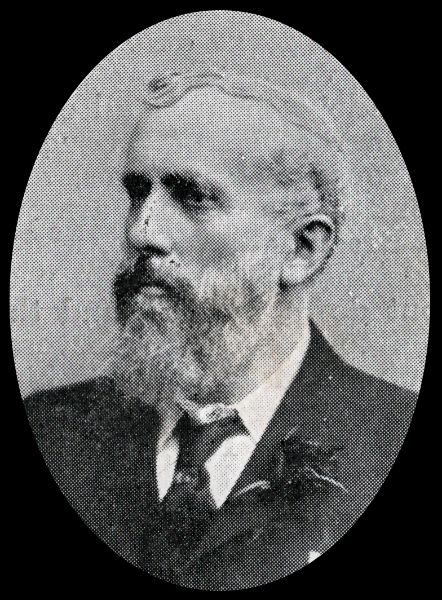
Sir John Bingham (from Picture Sheffield. Ref: y14723).
By way of a taster, we are sharing the will of Sir John Bingham of West Lea (which you may know better as St John’s Parish Centre). This is one of the shortest and simplest wills we have but, as you’ll see, we can learn a lot from it, about both the society of Bingham’s time and about wills.
John Bingham was one of Ranmoor’s great industrialists – and a fine example of Victorian self-improvement. Born the son of a grocer in 1838, he became the managing partner of Walker & Hall, the silversmithing business which pioneered electro-plating. He employed thousands of Sheffielders in its works between Eyre and Howard Streets in the city centre and also around the world. Many, if not most, homes in the UK have had Walker & Hall tea and coffee services and cutlery at some time or another. Bingham was Master Cutler twice, in 1881 and 1884, and he was created a baronet in 1884. He is described as a forceful character, Protestant, Conservative, a magistrate and a volunteer delighted to be Honorary Colonel of the West Yorkshire Engineers. The Sheffield Independent (19 March 1915) remarked in his obituary:
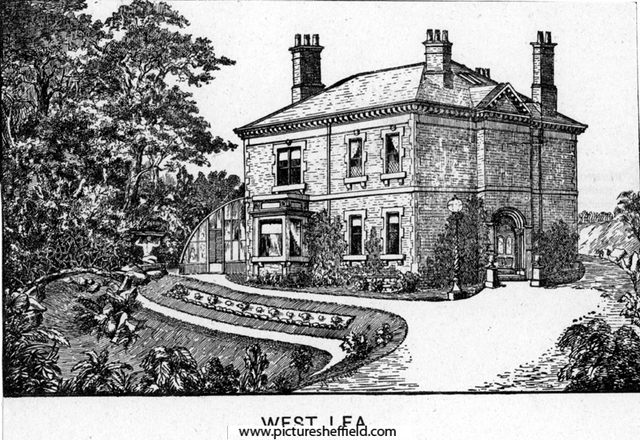
West Lea around 1885 (Picture Sheffield. Ref: s05856).
He was so strong in his convictions that it was only natural that he provoked vigorous opposition. No matter what the subject might be when once he saw the goal he went straight to it, and ever afterwards it was one of the incomprehensible things of life to him why others did not go too.
‘Not altogether a popular man … He strove for causes, not for favour’ and ‘pig-headed’, said the Sheffield Telegraph (19 March 1915) more bluntly but still admiringly. Bingham died suddenly in London in 1915 and was given a grand funeral, escorted the two miles from West Lea to All Saints Ecclesall by thousands of Walker & Hall workers and soldiers. (If you’re wondering why he wasn’t buried at St John’s, it has no room for a graveyard.)
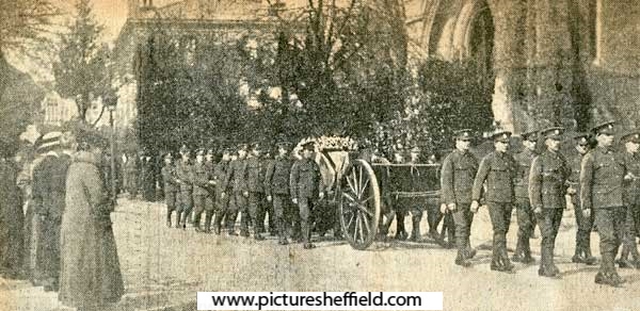
Sir John Bingham’s funeral leaving West Lea and St John’s on 20 March 1915. Notice the gun carriage. (Picture Sheffield. Ref: y05642.)]
Here is Bingham’s will – all 90 words of it:
THIS IS THE LAST WILL of me JOHN EDWARD BINGHAM of Sheffield Baronet I appoint my wife and my son to be EXECUTORS hereof I give to my son all my capital in the business of Walker & Hall and all profits & income accrued & accruing therefrom not already at the time of my decease paid over to me I give to my wife for her life all the residue of my property & subject thereto I give the said residue to my son DATED this 13th May 1910 - JOHN E BINGHAM Signed by the testator in out presence and by us in his the word "therefrom" having first been interlined after the word accrued HEBER WARD GE BRAUM
ON the 7th day of July 1915 Probate of this will was granted to Dame Maria Bingham and Sir Albert Edward Bingham the executors
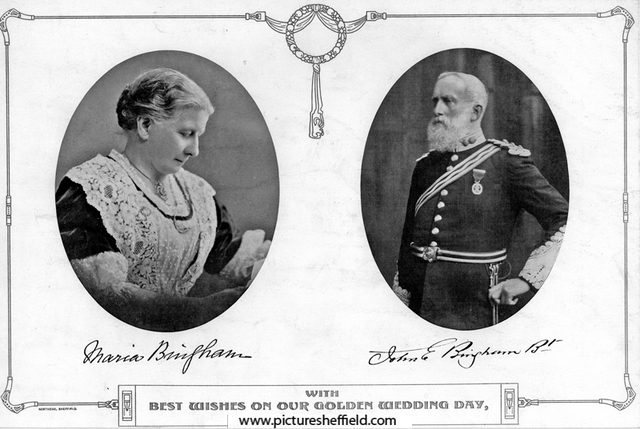
Sir John and Lady Bingham on their Golden Wedding in 1913. Notice Sir John in his military uniform. (Picture Sheffield. Ref: s08977).]
The probate document tells us that the estate was valued at £342,000, over £20 million today, making Bingham one of the richest men in Ranmoor (and therefore all Sheffield). The Nottingham Journal (12 July 1915) commented on his will that he ‘disposed’ of his property ‘at £3,800 per word’.
A will is a good starting point for research. We learn the full names of the family: John Edward, Maria, and Albert Edward. Bingham is a baronet, the lowest rank of the nobility, and his son inherits the title, hence ‘Sir Albert’. The baronetcy would of course have died out if the Binghams had had only a daughter. Official records reveal that Edward is a Bingham family name. Maria is described as ‘Dame’, but she would usually have been known as Lady Bingham.
The will is straightforward. Bingham leaves his business interests to his son and his other property, including West Lea and its contents, to his wife for her lifetime and then to his son. Albert was already a director of Walker & Hall, and it’s a rare Victorian who leaves business interests to a woman, or rather who expects a woman to play a role in business. Widows and daughters inherit shares and then live on the income.
It is notable that Bingham does not leave any bequests to family, friends, servants, institutions or charities. He appears to have been generous in his lifetime, supporting hospitals, his volunteer soldiers and St John’s, to which he made generous annual donations. In 1911 he and his wife gave Bingham Park to the people of the city. He was also, like many Ranmoor men, a Freemason and presumably involved in their charitable activities.
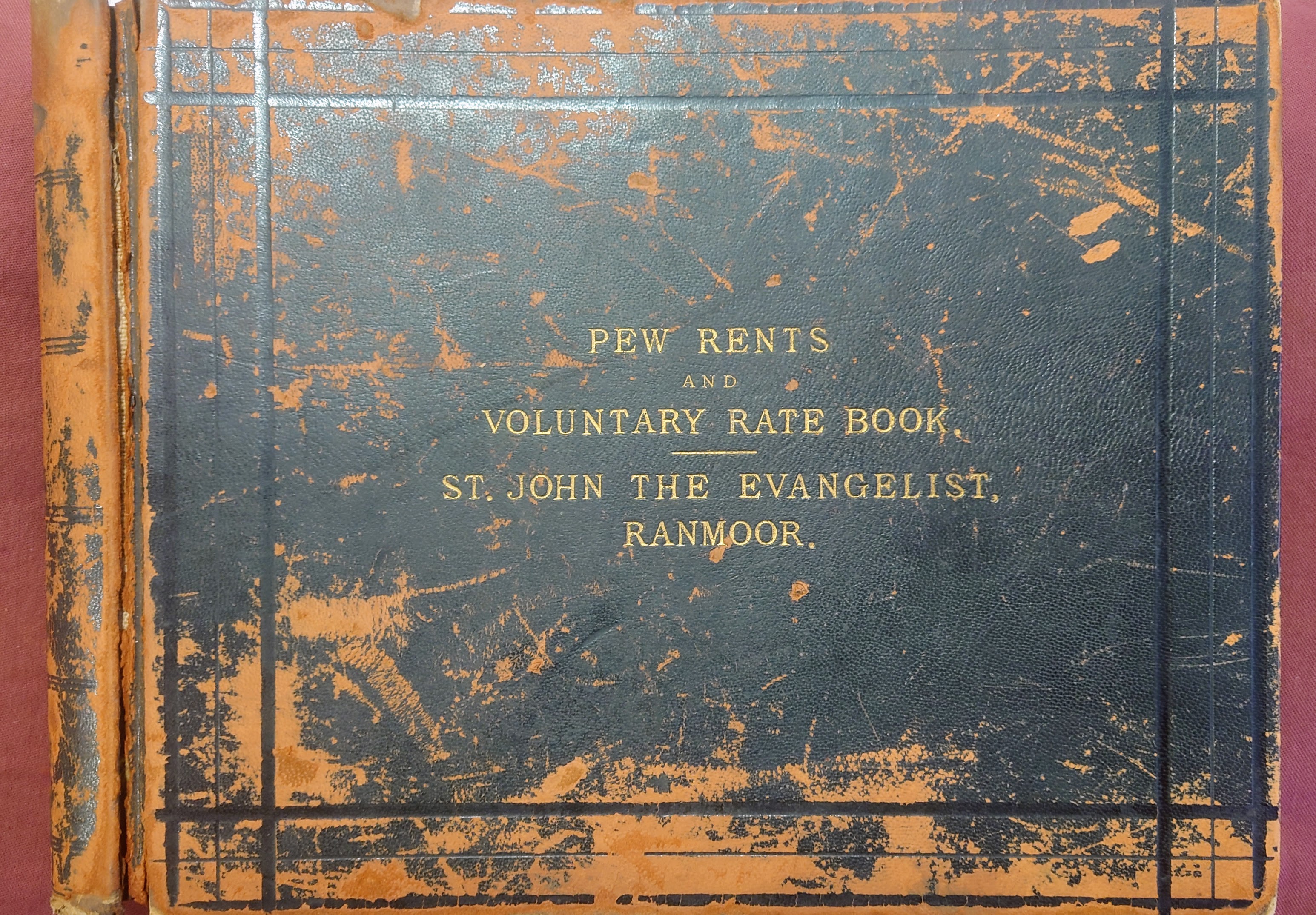
Register of Pew Rents from Sheffield Libraries and Archives.]
This is, by the standards of our Ranmoor collection, a modern will. It’s typed rather than handwritten (which makes life a lot easier for a researcher). Bingham names his wife as an executor at a time when this was still relatively unusual.
The will is dated 1910, five years before Bingham died. We don’t know if he was feeling ill or was just being prudent when he made it. Judging by the witnesses, Heber Ward and G E Braum, it may have been signed at or through his business, rather than the more usual firm of solicitors. Heber Ward was a manager at Walker & Hall, but I can to my frustration find no trace of G E Braum. Perhaps he was just visiting from abroad, as there are very few Braums, and no G E Braum, in British official records or in commercial directories. Of course, ‘G E Braum’ might be a typo (there is another, if you read the will carefully, and you’ll also see that a missing word was added at the last minute). But surely a witness would notice an error in his own name.
That there doesn’t seem to be the hand of a lawyer anywhere is interesting. Whoever drafted the will was aware of the common practice of avoiding ambiguity by avoiding punctuation. There’s not a comma or full stop in the piece. The apparent lack of a lawyer doesn’t of course make the will any less valid - although it may account for its being so short.
Short or long, typed or handwritten, simple or complex, dealing out fortunes or a few pounds, wills are a fascinating way to unlock the history of St John’s and the people who worshipped from its pews.
We will be talking about the Victorian wills of Ranmoor at St John’s Church (Ranmoor Park Road) at 4pm on Saturday 13 September. The talk is free and there’s no need to book. There will be refreshments on sale, and the church is open from 2pm for you to explore.
Val Hewson
1 September 2025
Sources: Wills are available from the Government’s digital wills service. Newspapers are accessed via the British Newspaper Archive and official records via Ancestry.
Blog 23 A Special Occasion at St John’s
22nd July 2025
Download as a PDF
In which a prince, a philanthropist, 40 constables and a large dog go to church…
In October 1879 Royalty came to St John’s. Prince Leopold (1853-1884), Queen Victoria’s youngest son, was in Sheffield to open Firth College, a forerunner of the University of Sheffield. The Prince stayed at Oakbrook with the industrialist Mark Firth, who was, as its name suggests, the moving force behind the new college. The visit was reported in the press extensively and with due Victorian deference.
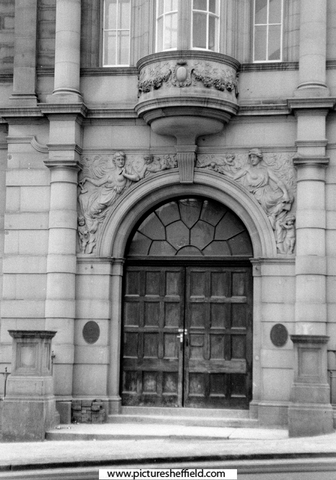
Firth College on the corner of West Street and Leopold Street.
Copyright © Sheffield City Council. All rights reserved. Ref: Picture Sheffield - c03111.
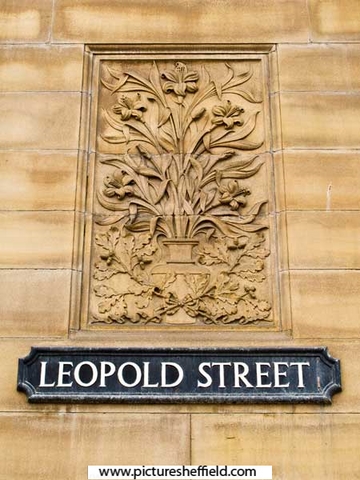
The street sign on the former Sheffield School Board offices.
Copyright © Sheffield City Council. All rights reserved. Ref: Picture Sheffield - c04364.
Leopold is not much remembered today. Leopold Street, in Sheffield’s centre, was named for him but most people probably have no idea of this. He was the only one of Victoria’s children to suffer from haemophilia (she was a carrier, as were two of her daughters) and he died at the early age of 30 after an accident. He was known in his lifetime as an intellectual and had studied at Christ Church, Oxford. Maybe this was why he was invited to open the new college, which was to offer university-level teaching in the town. The Sheffield Telegraph referred to Leopold as ‘England’s Royal Scholar’ and the Huddersfield Chronicle opined:
… the nation has reason to be proud that one of the Royal scions has stepped aside from the engrossing and fascinating pursuits of politics and war, wherein kingly wisdom and valour have scope for exercise, into the quiet walks of literature and science. Prince Leopold studies, observes, and meditates. The love of learning and the cultured taste which distinguished the late Prince Consort have descended to his youngest son, and we have no doubt that if Prince Leopold be endowed with health and strength he will become one of the greatest ornaments of all that is noblest and most exalting in the national life … (Wednesday 22 October 1879)
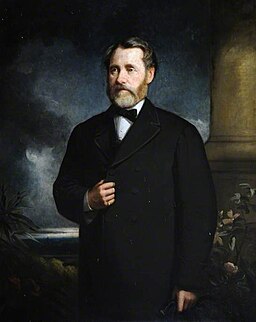
Portrait of Mark Firth by Thomas Jones Barker. Public domain. 1874.
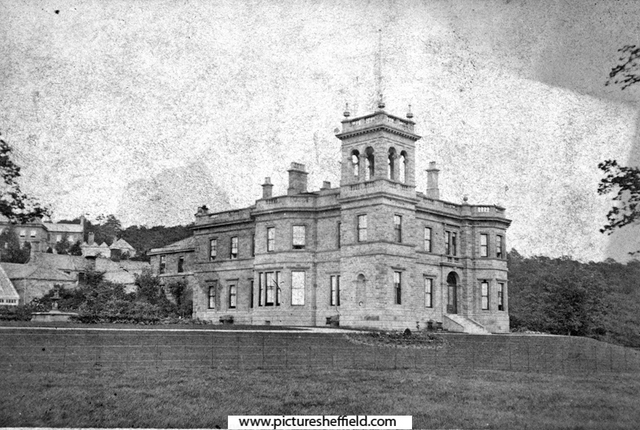
Oakbrook House, the home of Mark Firth.
Courtesy of Picture Sheffield. Ref: s05492.
There were large crowds when the Prince arrived in Sheffield. He was met at Victoria Station by his host, Mark Firth, along with the Mayor, the Master Cutler and a crowd of railway officials, aldermen and councillors, generally important citizens and various wives, daughters and sisters, all dressed in their best. The station had been specially decorated, with flowers, flags and a red carpet. Ordinary Sheffielders crowded the streets, as the Prince was driven through the town, up to Broomhill and along to Ranmoor, with an escort of police and the Yeomanry Cavalry.
When it came to church on Sunday, St John’s was the natural choice: close to Oakbrook, it was Ranmoor’s own, tall and impressive. Getting there was circumscribed by as much ceremonial as everything else in Leopold’s visit (and probably in his life). Although the weather was not good, ‘rain and wind prevailing during the morning’, many people - thousands, according to the London Evening Standard and Manchester Courier (both Monday 20 October 1879) - gathered to see the spectacle.
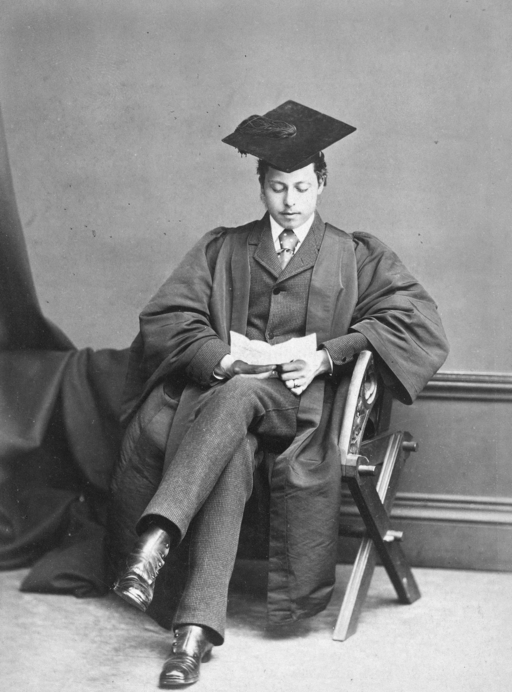
‘England’s Royal Scholar’ as an Oxford student. By Hills & Saunders (photographer).
Public domain. Circa 1872
The crowds, however, were most orderly, and appeared to be abundantly satisfied with the sight of the Prince, as he passed to and from the church. His Royal Highness could hardly have anticipated that at such a distance from the centre of the town there would be so many spectators, for he appeared both surprised and pleased; and though, of course, there was no cheering, he frequently raised his hat in acknowledgment of their silent greeting.’ (Sheffield Independent, Monday 20 October 1879)
The police were well prepared.
Inspector Toulson, with one sub-inspector, four sergeants, and 40 constables, was on duty, and distributed the men on the Ranmoor road from Oakbrook to the gates, and they also lined the passage leading from the road to the church. The Chief-constable, Mr. Jackson, was in attendance, seeing that the arrangements were carried out properly.
Many of the people who had met the Prince’s train the day before attended the service, including the Mayor and Mayoress, Mr and Mrs Edward Tozer; the Master Cutler, Joseph Burdekin Jackson; local MP Anthony Mundella; John Newton Mappin, ‘who generously erected the [church] at his own expense’ and his nephews, John Yeomans Cowlishaw and Frederick Thorpe Mappin.
St John’s had been consecrated seven months earlier, in April 1879, and must have looked splendid that morning, even in the gloomy weather. The Illustrated Police News (Friday 25 October 1879) called it ‘a very elegant edifice’. The grounds had been laid out by the designer Robert Marnock, who was responsible for Sheffield’s Botanical Gardens and many of the local estates. The interior decoration was not finished, with the walls and reredos temporarily painted and the large windows with plain, not stained, glass. But in place were the peal of eight bells, the organ, the font of Ancaster stone and marble and the pulpit of wood and bronze, with a crimson velvet carpet leading to it.
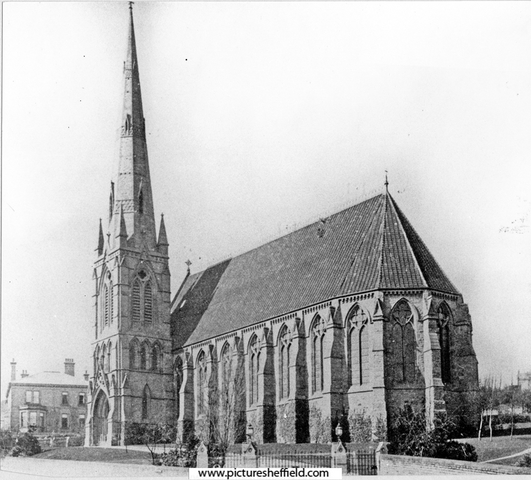
St John’s as Prince Leopold would have seen it.
Courtesy of Picture Sheffield. Ref: s02612.
The Telegraph reported that: ‘A few minutes past eleven a murmur of excitement passed through the crowd in the lower road, and immediately afterwards Mr. Mark Firth’s carriage, fully opened, entered at the lower gates, and drove rapidly up to the church.’ At this point Royal dignity was affronted when: ‘The inevitable dog, in the form of a large retriever, of course made his appearance, and ran in front of the carriages a short distance, but then took a turn to the left and bounded over the wall.’ Order restored, Mr Cowlishaw, who was a churchwarden, met the carriages and, carrying his ‘wand of office’, conducted the Royal party to Mark Firth’s pew.
The Telegraph called the sermon, preached by the vicar, the Rev Dr Chalmer, ‘an able and eloquent address’ and, in the fashion of the day, both it and the Sheffield Independent reported it almost verbatim. The text was from Ezekiel xviii: ‘Yet ye say, The way of the Lord is not equal. Hear now, O house of Israel: Is not my way equal? Are not your ways unequal?’
After the blessing, the congregation remained in their seats until the Prince and his party processed out, returning by carriage to Oakbrook. ‘At half-past one o'clock His Royal Highness, accompanied by his suite and Mr. and Mrs. Firth, drove up Manchester road to Mr. Firth’s shooting box on Moscar Moors…’. They returned about six o’clock and a ‘private dinner party was afterwards held, at which one or two friends were present.’ As it was Sunday, there had perhaps been no shooting but rather a good lunch and a walk in the fresh air across the moors.
Leopold’s visit to Ranmoor was remembered by Caroline, the wife of Mark Firth. In her will, signed in May 1893, two years before she died, she left to her second son, Mark, ‘the pendant presented to me by His Royal Highness the late Prince Leopold’.
Val Hewson
21 July 2025
NB Unless otherwise indicated, the quotations in this blog are from the Sheffield Telegraph of Monday 20 October 1879.
Blog 22 Unseen:
Lives behind the scenes
16th June 2025
Download PDF
‘Unseen’ is an odd title for an art exhibition. Art is something we see, something we look at. But there is more to it. Beyond – through - seeing there is thinking and feeling. Through art we empathise with the experience of others.
Art makes what is unseen seen.
This exhibition is part of the second year of the Scissors Paper Stone project set up to explore the history of St John's and its community. This year, the focus is on the people who lived in the parish towards the end of the 19th century, when both St John’s and Ranmoor itself were still new. What do we see when we look back? We see first the rich and powerful of Sheffield – mainly white men, of course, at that period. We know a lot about them, these men who built Ranmoor’s great houses, who ran Sheffield’s industries and indeed Sheffield itself. Their names are preserved to this day in our streets, parks and art galleries. But important though they were, these people were the minority. Behind them we glimpse the many people who underpinned the lives of Ranmoor’s wealthy few. They are shadowy figures, about whom we know very little. We catch sight of them only occasionally, in an old photo, a legacy in a will or a census return.
And this is what our 'Unseen' exhibition wants to explore. The exhibition turns the focus from the wealthy residents of Ranmoor, who monopolise the history books and archives, to the unseen people who made Ranmoor possible.
• The domestic servants - maids, cooks, nannies, laundresses, gardeners, grooms and coachmen who ran the comfortable homes of the wealthy. Lucy Lethbridge in her book Servants (Bloomsbury, 2013) says that:
‘In 1900 domestic service was the single largest occupation in Edwardian Britain: of the four million women in the British workforce, a million and a half worked as servants, a majority of them as single-handed maids in small households.’
• The workers in the steel mills, factories and breweries who generated the wealth for the lavish villas all across Ranmoor.
• The miners who dug the coal to power the factories and heat the houses.
• The farmers who grew the crops and produced the food.
• And those who transported materials and goods on the railways, roads and canals.
Victorian society would not have thrived without the hard labour of these unseen people.
And there are yet more unseen whose lives are reflected in the exhibition. People in the colonies who would have used Sheffield’s steel to grow and process the sugar, the cotton and the tobacco or to mine the valuable raw materials that helped make the British Empire so rich.
Our artists – all 19 of them – have responded in very different ways to these issues, including through artforms and crafts that unseen people used to express themselves and their creativity - embroidery, patchwork and rag rugs. These creative arts were not considered ‘proper’ art and were often dismissed as ‘just women's work’. (In some circles, they still are.) Yet they required as much skill and artistic judgement as an oil painting or watercolour.
Complementing the artworks there is ‘Kitchen Unseen’: a display of the vintage recipe books that might have been found in Ranmoor’s Victorian and Edwardian houses, great and small.
By reflecting on the lives of the unseen Victorians, we hope that the artworks will make visitors to the exhibition think about the unseen people of today. The people on the edges of our society, people who are old, sick or have a disability, who are poor or unemployed or homeless. Cleaners and carers. Those trapped in modern slavery or working in terrible sweatshops and the like across the world, to provide us with cheap goods and such a high standard of living. Their voices go unheard, their needs unmet, their lives unseen.
Art helps us see more clearly, and reflect differently, on the present as well as the past. Come and see the 'Unseen'.
Margaret Bennett
12 June 2025
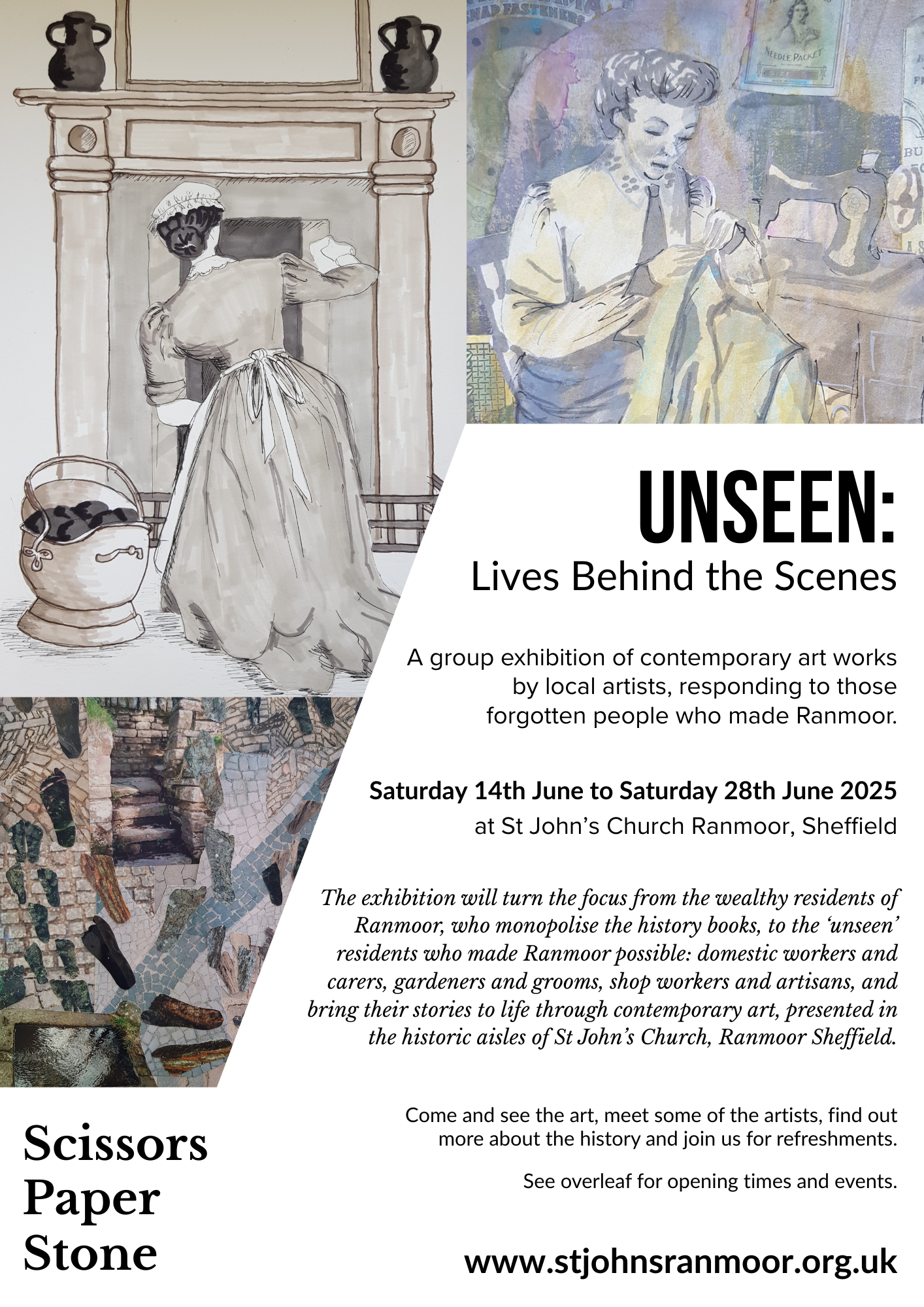
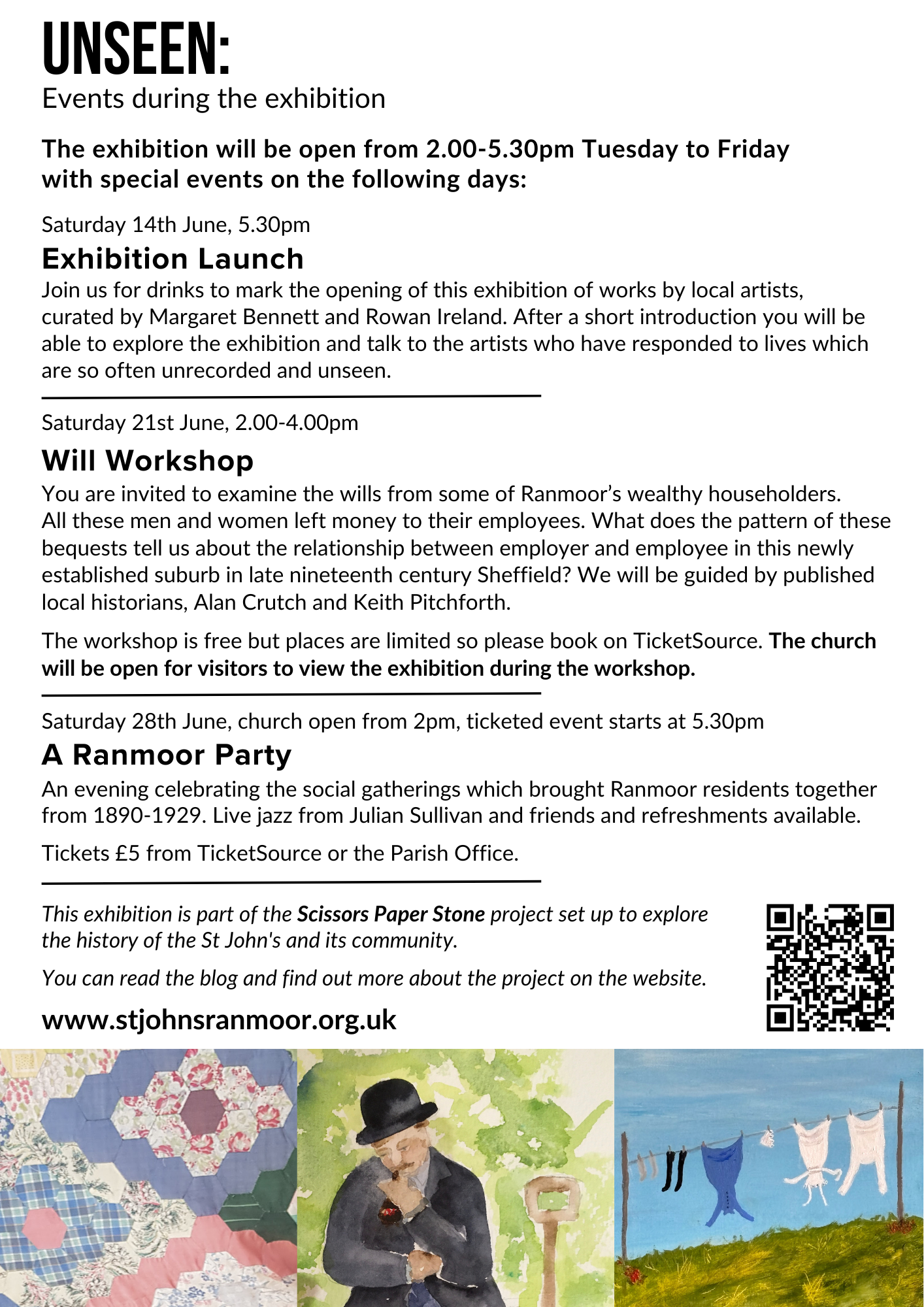
Blog 22a
A Pie and a Pint with the Residents of Ranmoor market c.1880-1919
With Jane Bartholomew
Download PDF
Blog 21: ‘A 5,000-hr. labour of love’: The kneelers of St John’s
7th May 2025
Download PDF
As many of you will have noticed you can now sit down in a pew with only one kneeler at your feet. Over the years our precious kneelers have piled up around us, most no longer used. In order to make it easier for us to keep the church clean, we have placed the more elaborate kneelers in the nave of the church and put the plainer ones in the side aisles. Many with an affection for a particular kneeler have taken it home, donations having been put towards the spire fund.
Who made these kneelers? Who learnt the art of when to use a ‘Florentine stitch’ or an ‘Hungarian Diamond’? And what inspired the creation of over 300 tapestries, each one unique? Many of these tapestries are initialled, so occasionally we can identify the embroiderers who created them, but all too often they are unclaimed and their makers unidentified.
As the Scissors Paper Stone community project unfolded this year, we realised that not only do the numbered pews we fill connect us with men and women whose rental payments are in our map of 1890, but the kneelers at our feet connect us with the parishioners who made them.
Though kneelers have been made in Britain from the seventeenth century onwards, parish production didn’t get going in earnest till after the Second World War. Visit Wadham College in Oxford to discover the first politically sensitive kneelers, stitched in honour of the Stuart dynasty and commissioned in the early seventeenth century by Stuart sympathiser, Dorothy Wadham. Thanks to the accession of the Hanoverians a hundred years later, the Stuart coat of arms made these kneelers politically suspect. Because they were tucked away in an archive these sumptuous works have survived in almost their original glory.
For the last fifty or so years, our kneelers have been used by thousands and are witness to the craftsmanship rather than the political beliefs of their makers. Though some of them have worn at the seams, most still look crisp and clean, thanks to the efforts of our cleaning teams over the decades. The wealth of imagery is extraordinary. Who made this predatory whale and the balletic Jonah? And this commanding eagle, the symbol of St John the Evangelist? (Perhaps with a worm in its mouth?)
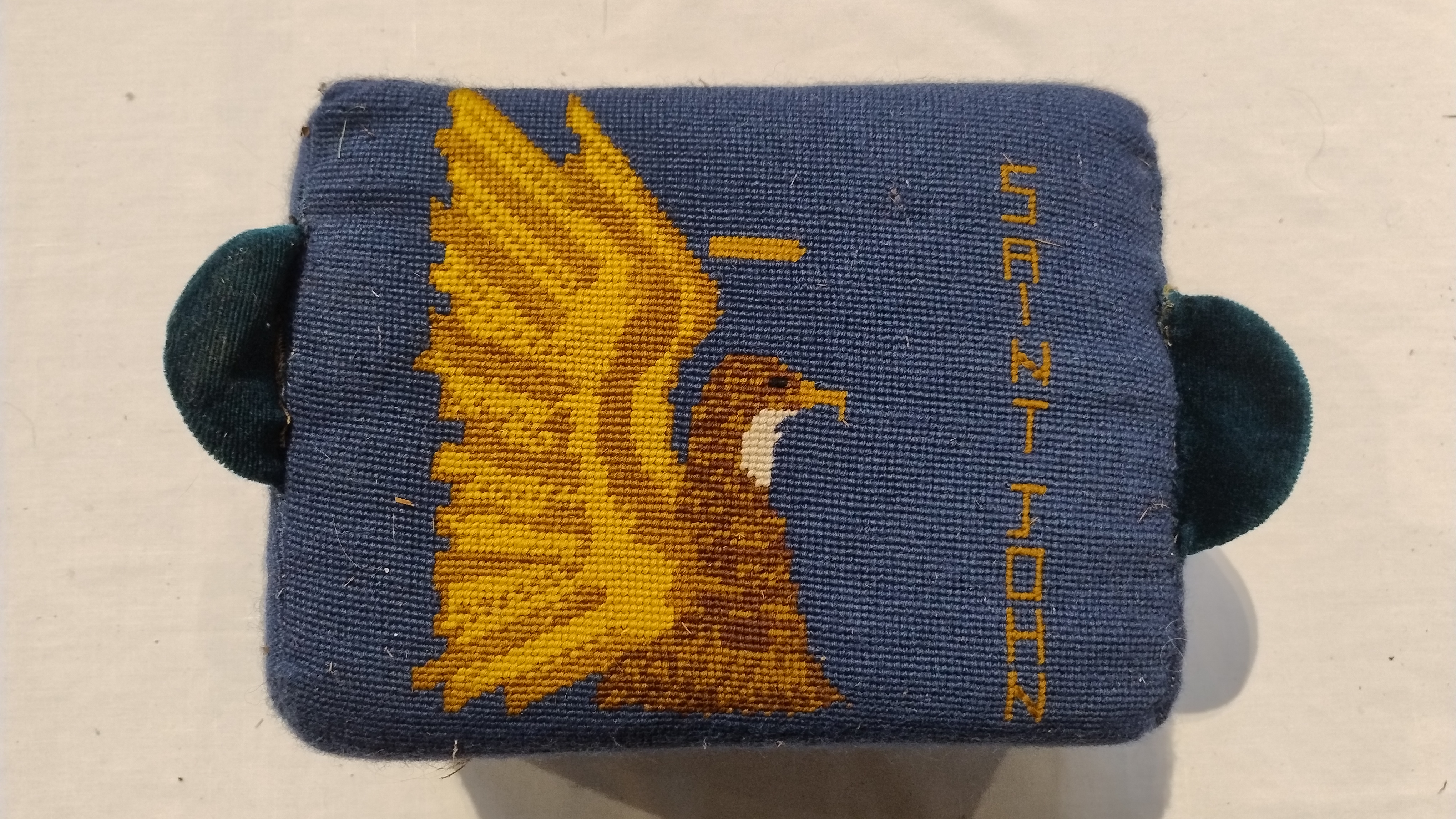
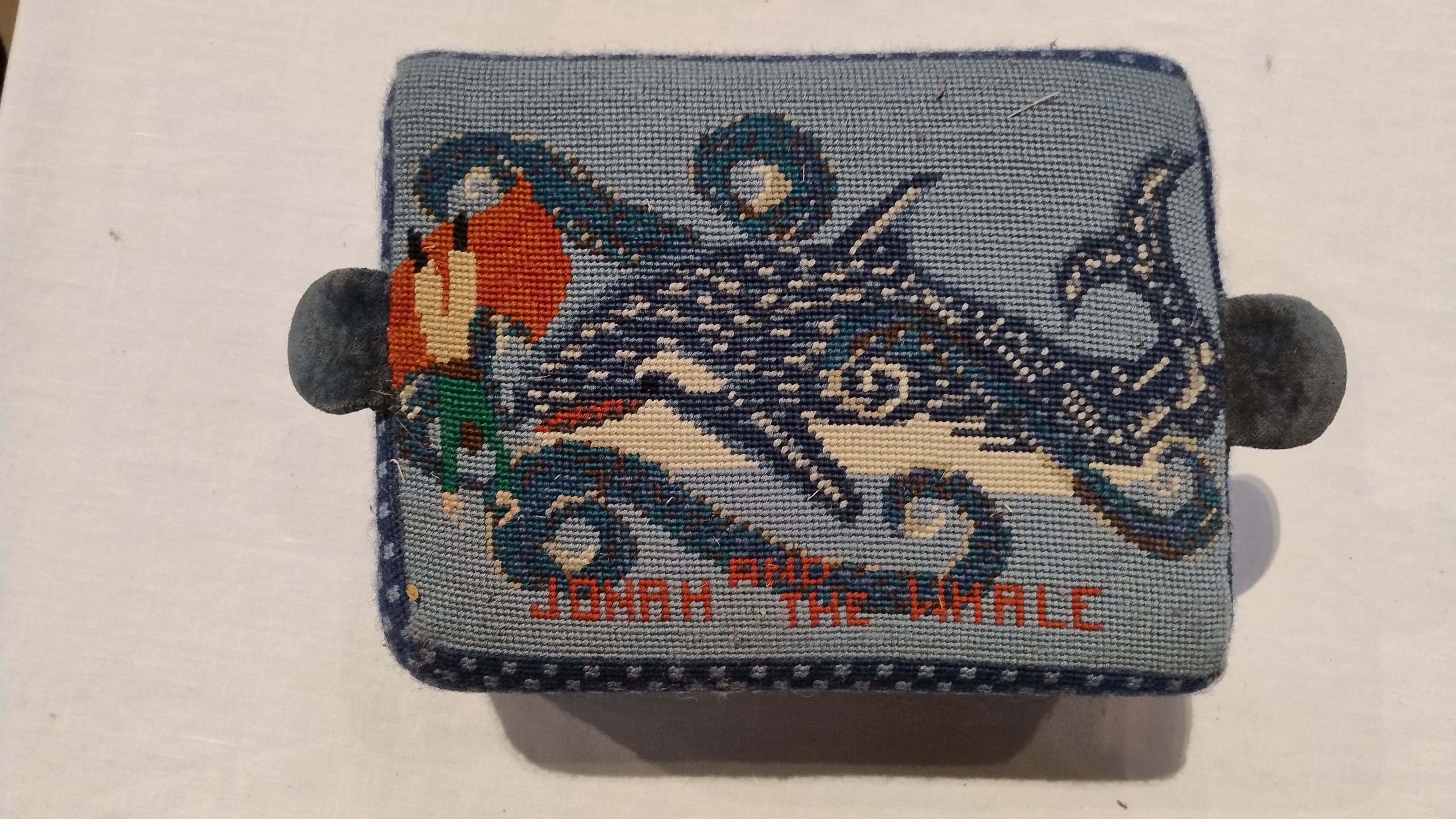
Pauline Heath and Rowan Ireland have photographed a huge number of our kneelers which we will send to the Kneeler Archive, set up because nationally kneelers are going out of use.
Explore: https://archive.parishkneelers.co.uk/
The theme of this year’s Scissors Paper Stone exhibition is ‘Unseen’. Local artists are responding to the lives of the people who maintained the life-styles of St John’s pew-renters in the nineteenth century. The parishioners of St John’s who created our kneelers are almost as unseen as these nineteenth century domestic workers. Sadly, we have no record of their names and the kneelers they made.
We do know that there were two particularly productive groups of kneeler-makers: one in the 1970s led by Pam Booker and Sadie Lockwood and the other in the early 2000s led by Eileen Stirling.
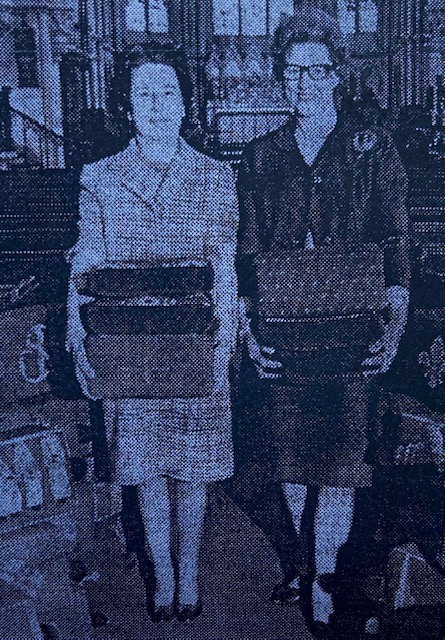
David Booker has shared with me information and photographs that help us get a sense of the first kneeler project. The report about the project in July 1974’s Sheffield Telegraph, was entitled ‘A 5,000-hr. Labour of Love’. It opens with the proud declaration that ‘Sore knees are a thing of the past at St John’s Church, Ranmoor, Sheffield.’
The photograph shows on the left David’s mother, Pam, who organised the creation of 100 kneelers and on the right Mrs Sadie Lockwood of Caxton Road Ranmoor ‘who designed the motifs’. I have been unable to learn much about Sadie but we have another monument to her craft and design skills in the church. To the right of the vestry door is her magnificent tapestry commemorating the burning of our first church in 1888. She was clearly a highly skilled embroiderer or ‘broderer’.
Pam Booker was not only a skilled needle-woman, she also had the great gift of enabling people to work together. She built up a team of people partly because of her own sociability. Pam had, since the death of her husband, brought up her two sons on her own. Her husband had survived four years in a German Prisoner of War Camp during the Second World War but he died of Hodgkins disease in 1955. Supported by her brother and sisters, Pam lived in Fulwood and was a devoted mother of David and Keith. She was a member of St John’s, welcoming people into her home for all kinds of social gathering. The making of kneelers brought many women together.
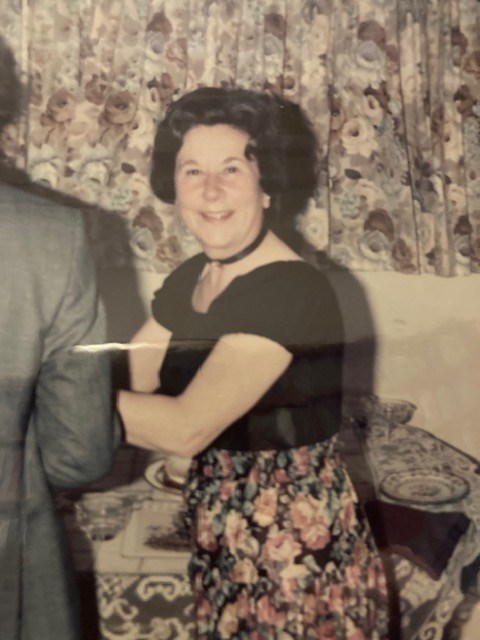
The second wave of kneelers flooded our pews at the beginning of this century, when Alison Wragg, our assistant priest, was given a kneeler kit by her dear friends Doreen and Ted Bales. Alice Underwood was a member of Eileen Stirling’s team. Alice remembers,
I did a scene of a bird on blossom, if I remember right - using a picture in one of my embroidery books (The Country Diary Book of Crafts). I think this was crab apple blossom.
The images were generated in all sorts of different ways. Some were personal and some from a booklet called Church Hassocks by Designers Forum. ‘Broderers’ were encouraged to put their initials on the side. Most worked from home rather than in groups.
The famous Winchester Cathedral embroidery project 1931-1938, celebrated in Tracy Chevalier’s novel A Single Thread, was apparently a highly organised but social affair. Unsatisfactory work was to be unpicked and colours used were carefully monitored. The inspiration for this project was the gifted Louisa Pesel, from Bradford. She served as the director of the Royal Hellenic School of Needlework and Lace in Athens, Greece, from 1903 to 1907. Her career was brought to a halt by the need to care for her elderly parents in Bradford. When they died she was able to resume her nurture of the nation’s embroiderers. Her imagination and practical skills were an inspiration to all those who worked with her, many of whose lives, like hers, were to a certain extent circumscribed by domestic duties.
Elizabeth Bingham has collected images of kneelers across the country. Her book, Kneelers: The Unsung Folk art of England and Wales (2023) will eventually find its way into the St John’s Library. It is full of tranquil images of what she calls ‘The Pleasures of Peacetime’: footballers, fishermen, steam trains and my favourite, a slip road on to the A14 to be found in All Saints Sproughton. Do explore the history of this craft which has been part of the tapestry of our spiritual lives for so long.
Mary Grover
5 May 2025
Blog 20: Pew Renting: the last shall be first and the first last
22nd April 2025
Download PDF
Many of you will never have heard of pew renting because quite rightly it is a thing of the past. But until after the Second World War it was often used to raise money to pay for the priest and the church fabric. In medieval times such a system was not necessary because church costs were covered by the tithing of the whole parish. Every resident, devout or not was required to pay a tenth of their worth, whether in goods or money. This was often resented but as a system it sort of worked until the Church of England lost its monopoly on Christian observance. In the seventeenth century onwards, Quakers, Methodists and Catholics rightly objected to supporting a creed they did not believe in. So it seemed fair enough to ask those who actually came to church to pay for its upkeep and staff. Anglican and some dissenting congregations adopted the pew renting model.
But if you look at the pew renting map you will discover the flaw in this new system. How, in heaven’s name, did the vicar, the Reverend JG Williams, described as a ‘genial’ man preach on Christ’s words recorded by Matthew, that ‘the first shall be last and the last shall be first’ when in front of him were four of the richest steel manufacturers in the city and in the furthest corners of the church, their servants? I don’t know how long St John’s used the pew renting system but most churches had abandoned it by the beginning of the twentieth century. Thank goodness for that but, I am afraid I have to be grateful that thanks to this hierarchical and profoundly unchristian practice we have in front of us just the kind of document that we needed to identify those residents of Ranmoor who, like the stone masons, left few traces of their lives. For though this map has, at its centre, the names of the wealthy, it graphically illustrates the diversity of the congregation and the fact that the majority of the men and women in front of Reverend Williams were not as rich as our early benefactors, Henry Steel, Frederick Thorpe Mappin or Robert Colver.
On the attached map you will find the names of all those who rented a pew in St John’s in 1890. The number in brackets indicates the number of ‘sittings’ they paid for. You’ll notice too, that some of our more illustrious predecessors rented two lots of sittings – one for the family and the second for their servants. The north aisle lies largely unrented – this, the colder side of the church, would have been the seating for those who hadn’t rented a pew.
Below are the brief profiles of two of our most prolific pew renters, Robert Colver (pews 42 and 20) and Samuel Earnshaw Howell (pews 35 and 7).
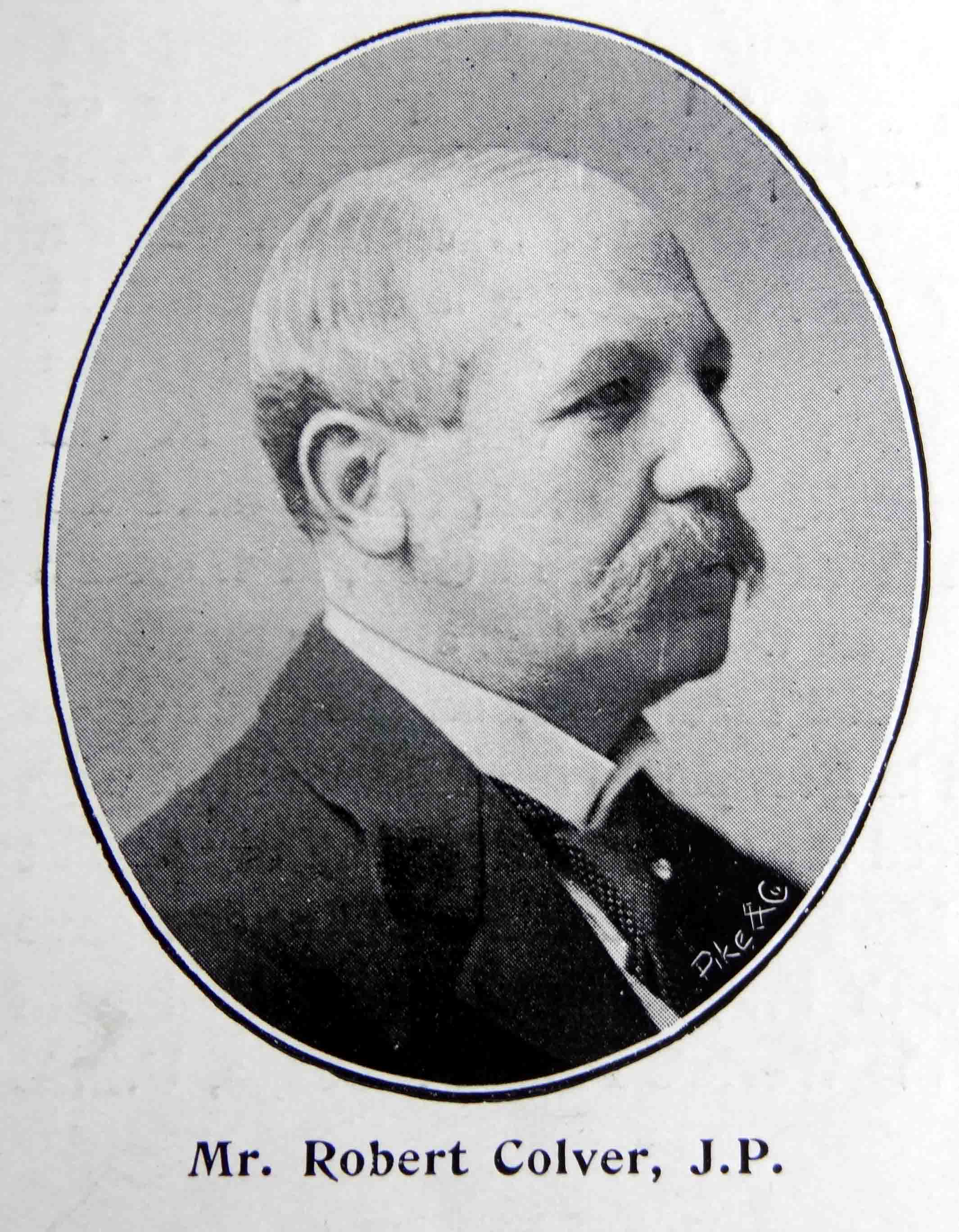
Robert Colver (1842-1916)
Robert’s father was a builder and contractor and he was educated at Milk St Academy. He chose not to join the family business: he became a farmer & land valuer through his connections to his mother’s farming family. He acquired his own farm in Ecclesfield at the age of 21. However, in 1873 he changed direction and went into partnership with Joseph Jonas, steel manufacturer, who had started the Continental Works in Sheffield. The company expanded and eventually manufactured all kinds of steel, from watch springs to heavy projectiles and high class tool steel. He was church warden at St Johns and took an active interest in the rebuilding of the church. He was much involved in the life of the city: a member of the Chamber of Commerce, a J.P. from 1910, a Freemason, committee member of the Sheffield General Hospital & Dispensary, an active supporter of the Ranmoor Horticultural Society. He joined the Company of Cutlers in 1882 and became Master Cutler in 1890. Two of his sons were killed on the First World War and the remaining son, Robert Colver junior, joined the family firm.
He died at Rockmount in 1916; the funeral service was at St John’s, the internment at Fulwood Church. He left £243,530 in his will.
(Sheffield Daily Telegraph, 4th December 1916)
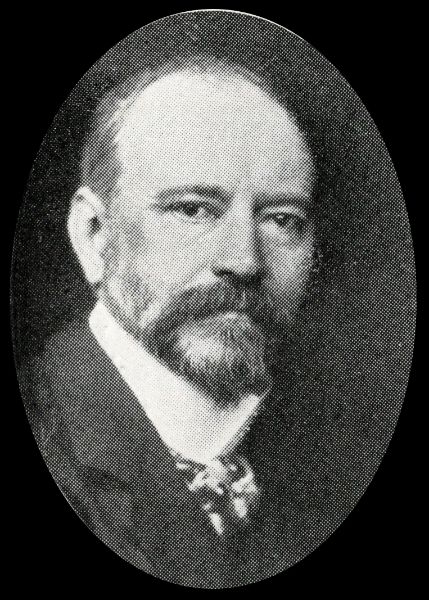
Samuel Earnshaw Howell (1847-1928)
No pew for his servants but they were not forgotten.
Howell and Co., originally a steel and file maker in the Wicker, was founded in 1853. He lived at 14 Gladstone Rd. The Hawley Collection website describes the development of the family firm:
‘One of the partners, John Bennett Howell (1818-1904), launched his own business. By 1880, it had two locations: Brook Hill Steel Works, Brook Lane (which dealt in steels and tools); and Sheffield Tube Works, Wincobank (which specialised in tubes for locomotives and steam engines). J. B. Howell’s son – Samuel Earnshaw Howell (1847-1928) – joined his father in 1870. Samuel was Master Cutler in 1888, and became a JP, Conservative town councillor, and president of the Sheffield Chamber of Commerce.
The problem of corrosion in steam tubes meant that Samuel became keenly interested in rustless steels. After stainless steel’s discovery in 1913, Samuel Howell became ‘an early convert to stainless ... [and] … was one of those who contended that an efficient cutting edge could be obtained with stainless knives’ (Sheffield Daily Telegraph, 16 April 1928).
Samuel E. Howell died on 15 April 1928 at Sheffield Royal Hospital, after he was knocked down by a tramcar at Nether Green terminus (Sheffield Independent, 16 April 1928). The funeral service was at Ranmoor, followed by cremation at City Road. He left £86,914.’
Few were more generous to their servants than Samuel Earnshaw Howell.
Mary Grover with map designed by Sarah Beardsmore
14 April 2025
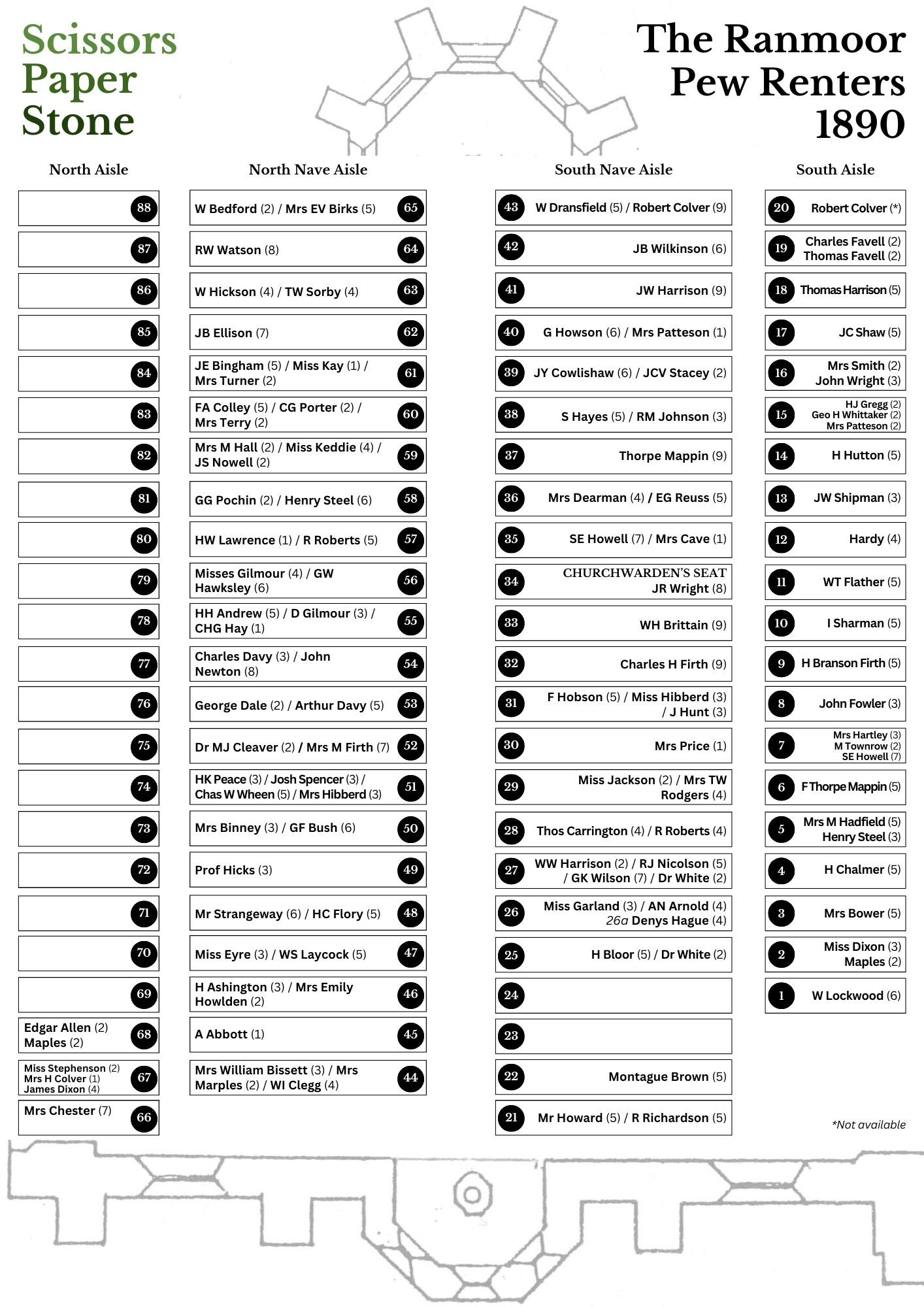
Blog 19: Ranmoor's lost Church (Part 3) -‘An Ornament to the Neighbourhood’
7th April 2025
Download PDF
Here Val Hewson looks at what happened after fire destroyed the beautiful church John Newton Mappin had given to Ranmoor.
When the church of St John the Evangelist was consecrated in April 1879, the weather had been dull, and it was icy when fire swept through the church in January 1887. On 28 July, just seven months after the disaster, the weather was ‘thoroughly summer-like’ for the ceremony to lay the foundation stone of a new church. On that Thursday afternoon, ‘an imposing gathering’ of parishioners, clergymen and guests came out to watch Mrs Charles Henry Firth lay the stone. Ranmoor was still a fairly new suburb in the late 1880s, and the grand church donated by John Newton Mappin was a focus for the community. The fire had been a shock, and people wanted to see the new St John’s. How would it compare? Would it be as beautiful, as richly decorated, as worthy of Ranmoor as the first church had been?
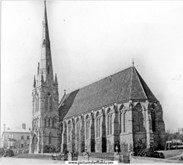 The first Church
The first Church
The foundation stone, all two tons of it, is set into the church’s southern wall, well above the ground, at the point where the chancel meets the nave. A ‘spacious platform plentifully bedecked with bunting’ was erected, with room for the dozen or so people involved in the ceremony. There must have been steps up, since Marianne Firth, presumably tightly corseted in the tailored costume and bustle of the day, would hardly have scaled a ladder. The clergymen, in cassocks and surplices, might also have been grateful for steps. The choir stood before the platform, and the guests clustered all around.
As the ceremony started, the vicar’s son, three-year-old James Tweedie, ‘presented Mrs Firth with a handsome bouquet’. The choir, ‘with hearty assistance from the spectators’, sang a specially composed hymn. The Gospel was read and then Rev Tweedie spoke about the new church. He explained, to a round of applause, that it would be bigger than the old, to accommodate Ranmoor’s expanding population, but there would be
as much as possible in the new building to remind them of the old, and to show that it was still the Church of St. John the Evangelist which they owed to the liberality of the late Mr. John Newton Mappin.
The architect Thomas Flockton then announced that, as was the tradition, various documents had been sealed in a bottle and placed beneath the foundation stone. There were copies of the day’s Sheffield newspapers, a history of the church written by Rev Tweedie and a record of the ceremony. This last read:
The stone above this, being the corner stone of the Church of St. John the Evangelist, was laid by Mrs. Charles Henry Firth, of Riverdale, on Thursday, July 28, 1887. Archibald George Tweedie, MA, vicar; Robert Colver and Hamer Chalmer, wardens. Architects, Flockton and Gibbs; builders, William Bissett and Sons. The church which was built upon this site in the year 1878 was so far destroyed by fire on Sunday. January 2, 1887, as to necessitate the complete rebuilding of all parts except the tower and spire.
John Yeomans Cowlishaw presented a ‘beautiful silver trowel, ivory handled’ to Mrs Firth. It was fitting that he, a nephew of John Newton Mappin, should play a role. He said that he could not help but think of his uncle, who had died in 1883. The inscription on the trowel read:
Presented to Mrs C H Firth on the occasion of her laying the foundation stone of the Church of St. John the Evangelist, Ranmoor July 28th, 1887.
Marianne Firth, who performed her task ‘in a very graceful manner’, announced: ‘I lay this foundation stone in the name of the Great Jehovah, the Holy, Holy, Holy, undivided Trinity, Father, Son, and Holy Ghost, Three Persons but One God, Blessed for Evermore.’ She then looked to see if the stone was plumb and added, ‘I pronounce this stone to be well and truly laid.’ The spectators applauded again and the churchwardens, Robert Colver and Hamer Chalmer, proposed a ‘hearty vote of thanks’. ‘
The National Anthem was sung [and] the bells in the tower rang out a merry peal.’
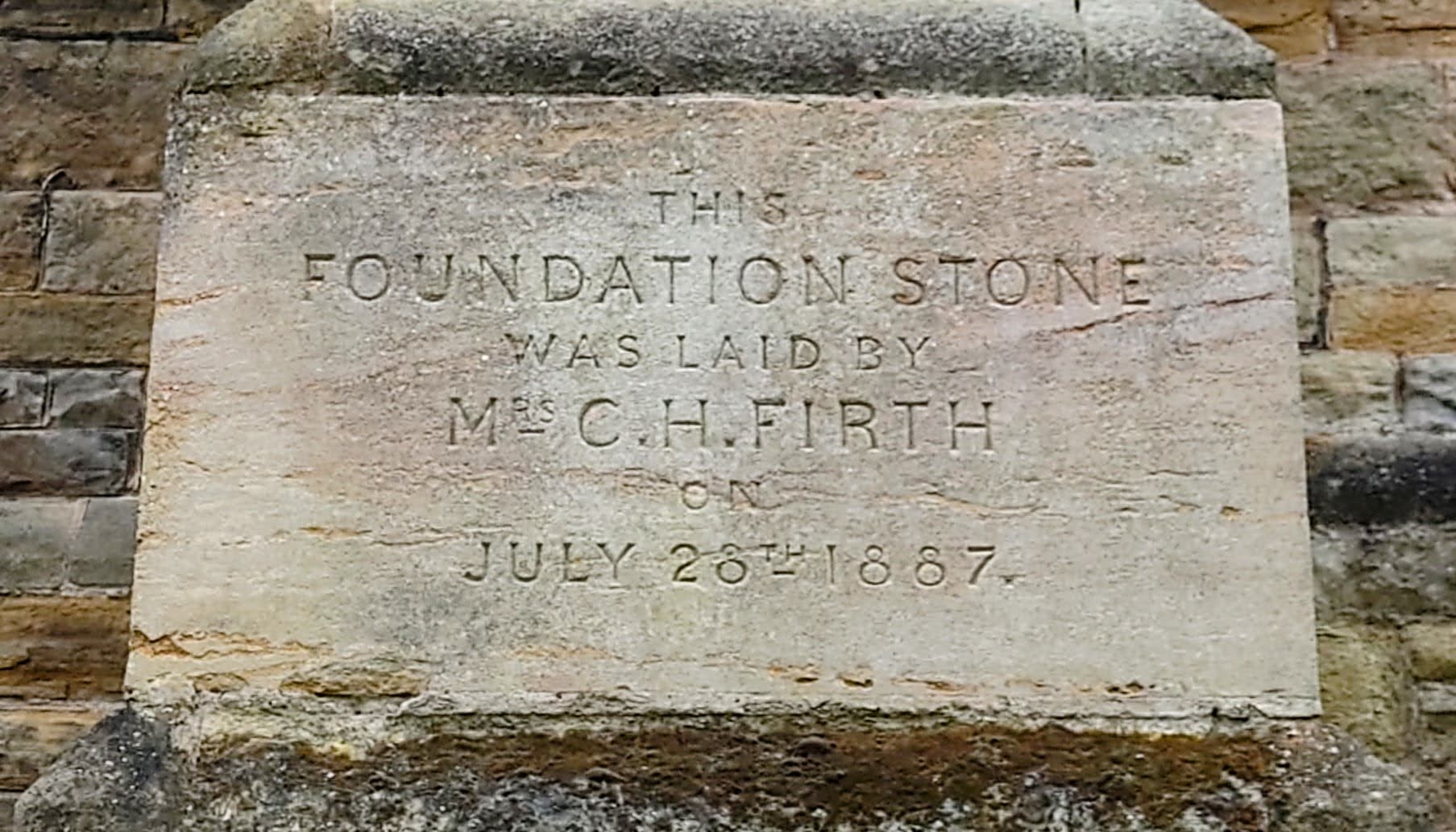 The foundation stone
The foundation stone
Why was Marianne Firth chosen for the honour of laying the stone? Her husband explained that his wife ‘took very great interest in the church and the parish generally’ when he – not she! – acknowledged the vote of thanks. No doubt this was so. Charles Henry and Marianne worshipped regularly at St John’s, and he had presented the organ for the first church in 1879. But there was probably more to it. In terms of business, wealth and philanthropy, the Firths were after all Ranmoor royalty. On this occasion, Charles Henry and Marianne were joined by the Edward Firths and the Branson Firths, Charles Henry’s brother and eldest son respectively.
The next day’s Sheffield Telegraph elaborated on Mr Tweedie’s description of the new church:
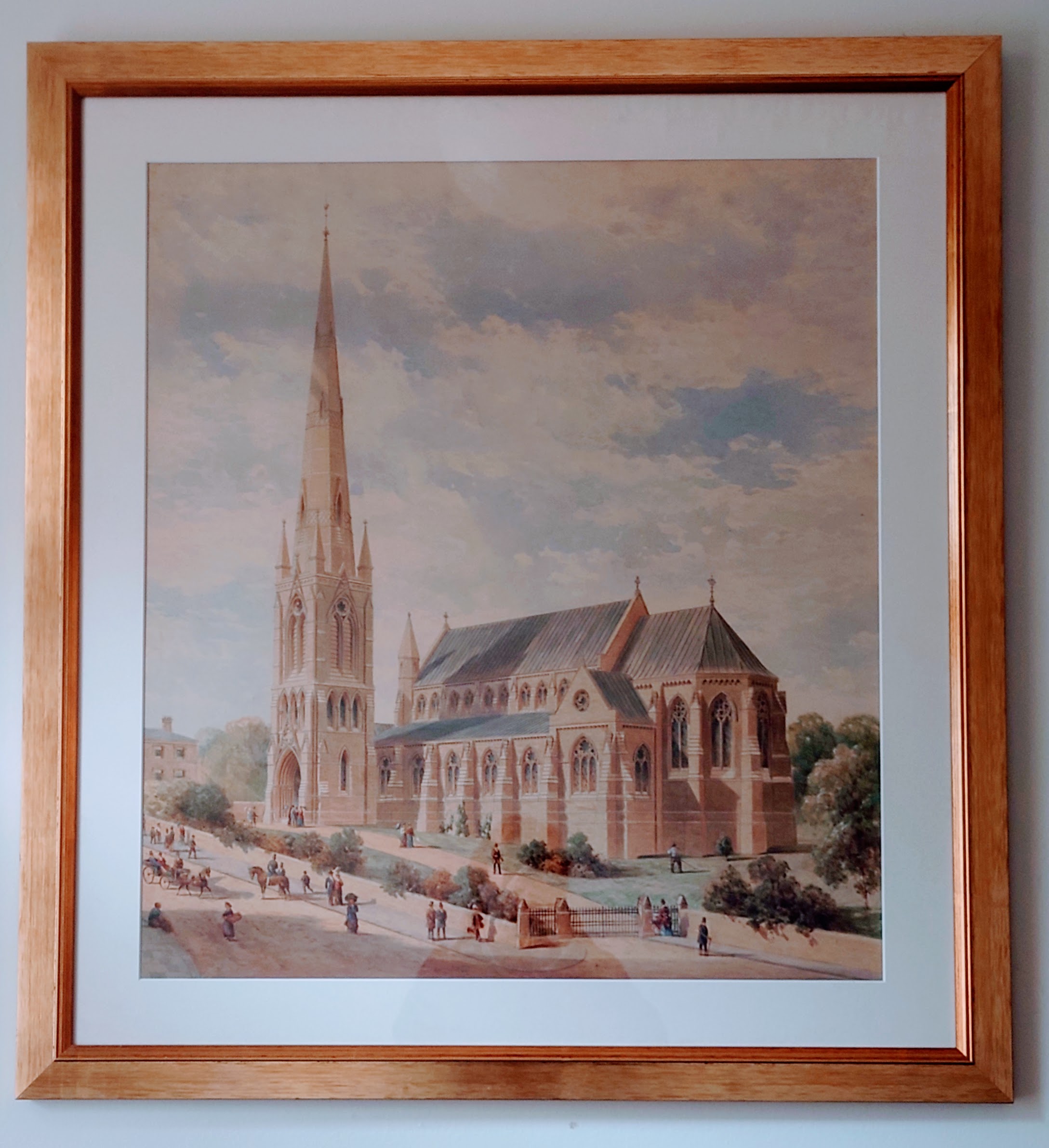
The new church - from a print hanging in the entrance of the Ranmoor Parish Centre
… nave, north and south aisles, ante church or corridor at the west end with baptistry, chancel with chapel on the south side and organ chamber on the north, and vestries. The tower, with spire, which was uninjured by the fire, will form the principal entrance as before, and there will be two other doors for exit, one near the west end and the other near the east end. The style of the building will be geometrical English of a severe and bold type … The chancel will be semi-octagonal in form at its eastern end. The interior of the church will not be open to the roof as has been lately been the fashion in churches, but will be ceiled over at about the level of the eaves, thus leaving a space in the roof … which will contribute materially to the warmth … a series of open arches forming a triforium, which will add very much to the internal effect. Behind these arches … will be hot water pipes … so avoiding the draughts which are frequently caused … The number of sittings is 759, being an increase of 240 over those formerly provided.
The new church was designed by Edward Mitchel Gibbs, in partnership with Thomas Flockton, and was being built by William Bissett and Sons. Both were then among Sheffield’s most sought-after contractors, and so their involvement in a prestigious project like St John’s was to be expected. In fact, they all had in a sense a personal interest. Edward Gibbs had been the architect for the first church, which he had watched burn down. William Bissett and his wife lived near St John’s, at Rock Mount on Fulwood Road. Flockton, Gibbs and William Bissett’s sons, William junior and Lawrence, were all at the ceremony, no doubt to make sure everything went to plan. On that sunny afternoon in 1887, they must all have felt confident in the future. Was not St John’s going well? Had their celebrated Mappin Art Gallery not been officially opened just the day before? Flockton and Gibbs did of course win further renown, but it was different for the Bissetts. After William senior died in 1889, the business went bankrupt (with its losses apparently including £1,800 on St John’s). Lawrence and William absconded with company funds, never to be seen again in Sheffield, and their brother John, who knew nothing of their peculation, was left to cope alone.
But back to St John’s. The first service in the new church was held on Sunday 9 September 1888 – apparently later than had been hoped but there had been delays due to bad weather. There was of course a large congregation that Sunday morning, probably including most of the people who had watched Marianne Firth lay the foundation stone fifteen months earlier. ‘The beauty of the church and its noble proportions were greatly admired; and Messrs Flockton and Gibbs, its architects, who were at the morning service, were warmly congratulated by many.’
It remained only for the finances to be finalised. Archdeacon Blakeney, who preached the sermon, said, with some humour but hinting at earlier dissension:
… an ornament to the neighbourhood, and which will be in harmony with the palatial residences which surround it. I know that some people felt that a less pretentious and less expensive structure would do. Well, it might have done, but then you would not have felt the same interest in it, or taken the same delight … Everything about the church is good, is substantial, is handsome … I feel satisfied that there is not a person connected with the church who would now wish to see the work that has been accomplished done in a less costly manner.
According to the churchwardens, the new church cost £13,700. They had £9,400 insurance money for the old church. It is difficult to follow the trail 140 years later, but it seems that, thanks to the efforts of the churchwardens and vicar, the remaining £4,000 or so was raised through donations from parishioners and others. The newspapers reported, for example, that at the first service the collection was around £300. By the early months of 1889, the debt was all cleared, and the congregation could, in Archdeacon Blakeney’s words, ‘really call the church [their] own'. St John’s was, the vicar claimed, ‘the handsomest modern church in the West Riding of Yorkshire’.
Val Hewson
7 April 2025
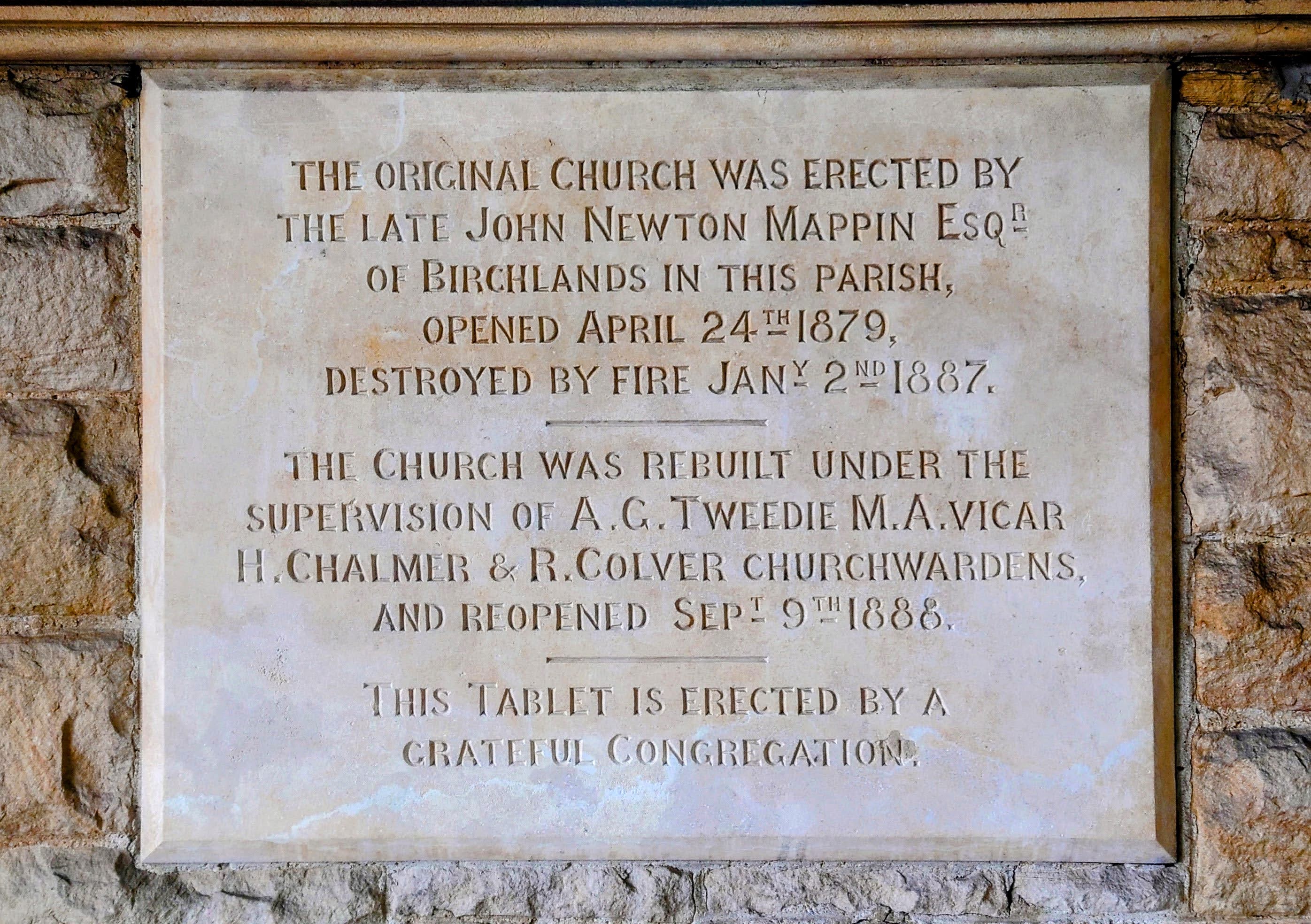 The plaque in the church porch, thanking Mr Tweedie, Mr Chalmer and Mr Colver.
The plaque in the church porch, thanking Mr Tweedie, Mr Chalmer and Mr Colver.
Note: The many quotations above come from various Sheffield newspapers from July 1888 to April 1889. I’ve not included exact references as I think they break up the text, but if anyone is interested, please email val383@btinternet.com. The vicar’s history of the church, although not long, is too much to include above, but again do email if you would like to see it.
Blog 18: Ranmoor's lost Church (Part 2)
13th February 2025
Download PDF
‘Today its place knows it no more’
Val Hewson wrote in January (Blog 16) about the first St John’s, given by John Newton Mappin to Ranmoor in 1879. It was once described as ‘the Church of the wealthy’.* Its furnishings were elegant: a pulpit of bronze and wood, a font of Ancaster stone and marble, Brussels and velvet pile carpeting, Minton floor tiles and more. But just seven years after the consecration all this was lost.
The Church of St. John the Evangelist … was wreathed in flames from the chancel to the western gable, from the organ chamber to the southern porch … as the fierce heat burnt away the timber, the loosened tiles dropped into the interior, and through the roof protruded tongues of fire … The interior was one seething mass, which outlined the architectural features of the building … very soon the great volumes of black smoke, lit here and there by lurid gleams from the nave, told to Ranmoor that its church was doomed.**
The alarm was given by the caretaker Thomas Leighton around 9.30 on Sunday morning. It was 2 January, the first Sunday of 1887, and there was a severe frost, making roads and paths treacherous. In the big houses around the church, servants would have been serving breakfast, and masters and mistresses eating eggs, bacon, kidneys, kedgeree, toast and marmalade. Poorer people would not have eaten so well but were probably looking forward to their Sunday rest. Some would already have been getting ready for church and others feeling a little sorry for themselves after New Year celebrations.
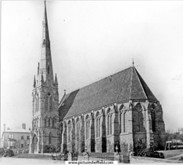
St John's Before the fire (Picture Sheffield Ref s02612)
Leighton, ‘anxious that the church should be warm’,* had kept a fire burning in the furnace all night. This was the custom in winter. The caretaker, about whom we know only that he was living in Upper Ranmoor Road, had started work at about 5am, to get everything ready for Sunday services. Down in the cellar he ‘”fired up,” got the furnace at a good heat, and at eight o’clock left everything apparently safe’.** He spent half an hour setting out the communion service in the church and went home for breakfast around 8.30am. When he came back almost an hour later, it was to the smell of burning wood and smoke ‘creeping through the roof of the organ chamber’.** He hurried through the vestry into the church.
The flames were bursting out all about the top of the organ pipes, creeping inch by inch lower, whilst forks of fire shot up against the arching, and curled upwards into the roof of the church.**
Leighton kept his head. He ran down to the Ranmoor Inn from where a messenger rode off at a gallop to the police station in Spooner Road, Broomhill. Here at 9.50am a call was made to the ‘Fire Office’ in Rockingham Street. The horse-drawn fire engine raced the two miles uphill to the church, arriving at 10.10am. Inevitably some spectators complained of a slow response, but the Telegraph dismissed this: ‘… certainly not justifiable, for Superintendent Pound was present twenty minutes after receiving the call, which is capital time on a frosty road from the fire engine station’.** The small ‘hose cart’ kept by the Broomhill police had arrived just before and started drawing water from a nearby hydrant.
Meanwhile Thomas Leighton had run up Ranmoor Park Road, to the vicarage, shouting ‘Mr Tweedie, the church is on fire.’** The churchwardens, Hamer Chalmer and Robert Colver, came hurrying along. The industrialist John Bingham and his son Albert, who lived across from the church at West Lea – now the parish centre – came out too.
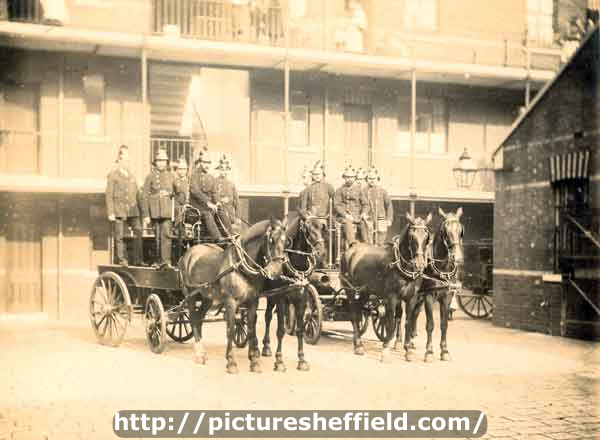
City of Sheffield Fire Brigade at their Rockingham Street Station (Picture Sheffield Ref: u11211)
The vicar succeeded in getting into the vestry, and peeped through into the church. The east end was then almost in total darkness. There was such a dense volume of smoke … Looking towards the west Mr. Tweedie could make out the familiar objects of his church, but only dimly. To enter the church and save any of its contents was out of the question; all Mr Tweedie, Mr Bingham and the other gentlemen who gathered round the doors could do was to carry off some of the furniture of the vestry, together with the books and registers from the safe, the alms dishes, and the portion of the communion service not set out on the altar.**
Meanwhile, Thomas Leighton bravely made his way to the gas meter to ‘turn the tap off. He was nearly choked by the smoke’, but was successful and ‘locked the gas chamber behind him’.**
As the men watched, One by one the windows were blown out with a sound like small artillery, the memorial windows going in the common ruin. Then the roof began to fall as the smaller beams burnt out. The large west window fell outwards with a great crash, and behind it came a great volume of smoke …**
While there were reports of parishioners arriving for the service, unaware of the disaster, word seemed to have spread quickly. Given the church’s location, this is no surprise:
Soon the roof fell in, and the nave was a vast furnace, the flames and smoke from which were seen from the hills of Ecclesall, Sharrow and Crookes, and the village of Fulwood.*
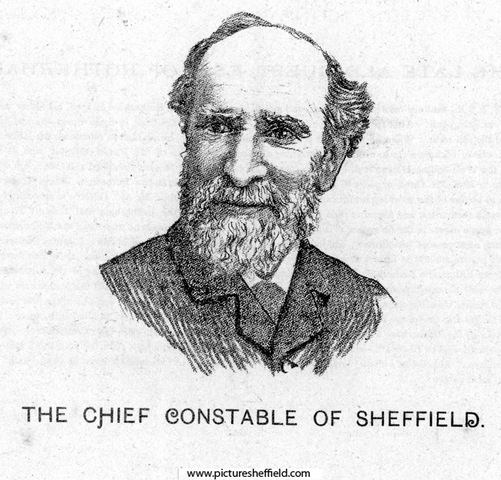
Chief Constable John Jackson (Picture Sheffield Ref s08336)
People were gathering, including ‘a great number of influential citizens and inhabitants of the district’.** The Chief Constable, John Jackson, on his way to St Mark’s Church, came instead to Ranmoor, and Inspector William Toulson of Broomhill had to manage not only the hose cart but also crowds. Everyone was affected by the ‘sorrowful scene’** but none more so perhaps than Edward Mitchel Gibbs, who had designed the church, and John Yeomans Cowlishaw and Frederick Thorpe Mappin, the nephews of John Newton Mappin.
As soon as he arrived, Superintendent Pound realised that the nave and the chancel were beyond saving. There was a chance, he felt, for the tower and spire, which were slightly apart from the church, and so he directed water there. To the bystanders it must all have been terrifying, and Frederick Mappin ‘felt it his duty to caution the firemen to be careful in their work’.**
The entrance porch looking towards the Ranmoor Inn was played upon until it was cool enough to be entered, after which the belfry door was broken open, and the steps, being luckily of stone, ascent was possible into the belfry. Superintendent Pound went aloft [and ordered up] a length of hose … from this vantage ground water was poured around, and with the outside stream proved sufficient to stay the fury of the flames in this direction.**
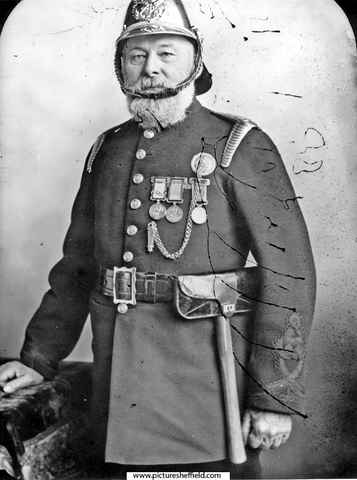
Superintendent John Pound (Picture Sheffield Ref s08453)
Pound’s actions worked. The tower and the peal of eight bells were saved.
The church was all but destroyed within a couple of hours. There remained ‘a few charred rafters’, fragments of stained glass, ‘huge timbers’ from the roof crushing the pews, scraps of paper from prayer books and sheet music, bits of leather from book bindings. ‘Here and there a figure in bronze was picked out of the pile’ and ‘from the walls hung gas pipes twisted and torn into all shapes’.**
Around 4pm, when it must have been getting dark, there was an inspection. Mr Tweedie the vicar, Mr Chalmer and Mr Colver the church wardens, Mr Gibbs the architect, Mr Chambers the builder, and Mr Pound the fireman met up. They examined the organ chamber and vestry, under which was the furnace room. It was fairly obvious – Mr Pound, an experienced fireman, was certain – that the fire had started there but they could not agree how. The flue for the furnace ran up the wall between the vestry and the organ chamber. On the organ side there were nine-inch fire bricks, which should have been enough to prevent fire crossing. Forty feet above the ground, they found a hole in the bricks ‘at a point where it is easy to conjecture that the beam supporting the organ roof would rest’.** Mr Pound climbed up and declared: ‘The timber runs into the flue. It has burnt right through.’** Mr Chambers rejected this and Mr Gibbs, who also climbed up, agreed, judging that there was ‘at least three inches of space between the flue and the end of the beam’.** He felt that the furnace must have been unusually hot to cause the fire.
John Newton Mappin, who died in 1883, did not see the destruction of ‘his’ church. He would surely have been heartened by two things. There was the courage shown by the men fighting the fire - professionals and Ranmoor residents alike. And there was the immediate intention to rebuild.
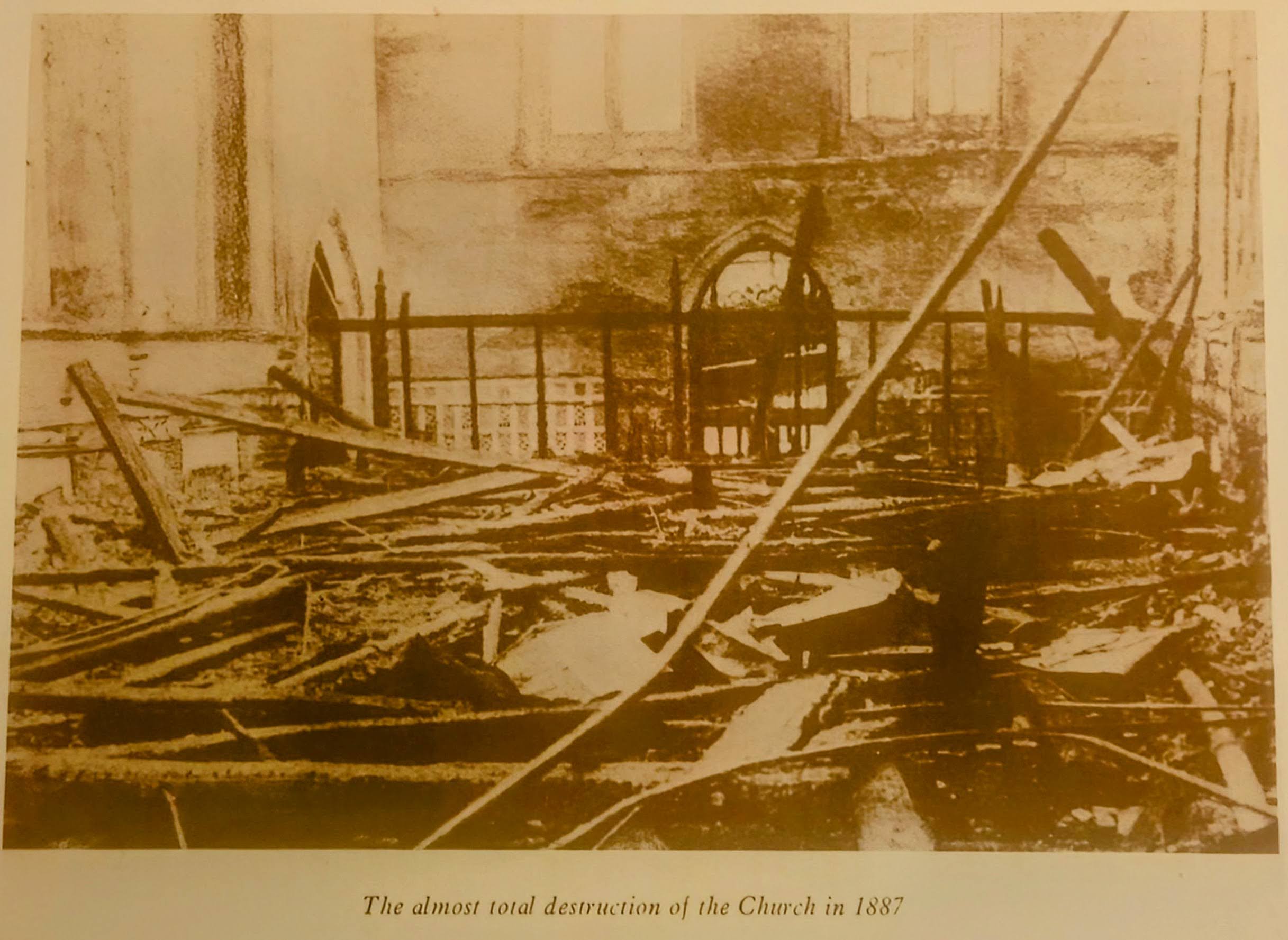
The interior of the church, looking to the west end (from The First Hundred Years)
The Telegraph said:
Weeping over the ruins will not build up the walls. … It has gone, and to-day its place knows it no more.**
The church was insured for £9,400 and the full amount was paid out on 8 January. The Vicar and the church wardens wrote an open letter of thanks to Mr Ross of Alliance Insurance on 8 January:
Dear sir,—Will you convey to your directors our warm appreciation of the prompt manner in which they have investigated and discharged our claim in connection with the recent fire at Ranmoor Church. We wish also to express our thanks to you and Mr Selfe for the kind and courteous manner in which you have met us in this matter.****
On 15 January, just two weeks after the fire, the architects Flockton and Gibbs were instructed to design Ranmoor’s new church.
The story will continue shortly.
Val Hewson
17 February 2025
Sources:
* The First Hundred Years (St John the Evangelist, 1979)
** Sheffield Daily Telegraph, Monday 3 January 1887, p.3
*** Sheffield Daily Telegraph, Monday 3 January 1887, p.2
**** Sheffield Daily Telegraph - Thursday 13 January 1887, p.3
Blog 17: Pew 19: The Favell Brothers
3rd February 2025
Download PDF
On March 22nd Mary Grover and I will be introducing you to the huge range of people who sat in the pews of Ranmoor’s second church, built in 1889. The Scissor Makers and Bookmakers in the title of our talk will all make their appearance in these pages but the brothers in Pew 19 who rented four sittings between them were neither scissor makers nor bookies. The family had connections with many different Sheffield trades and professions.
The place of the Favells in the pew hierarchy is interesting. The wealthy Colver family had nine sittings at the very front of church in a central aisle. Robert Colver also paid for nine sittings in a side aisle in Pew 20, most likely for servants and dependents. It was behind the Colver B team that the two Favells sat, with two sittings each. Yet the Favells were an illustrious Sheffield family: several were medical men and there was an archdeacon in their ranks. Thomas was born in 1831, and Charles in 1833. Their father was William Favell, a surgeon and general practitioner, and their mother was Elizabeth Priest from Huddersfield.
Initially Charles and Thomas Favell led similar lives but their circumstances at death were very different. Neither Thomas nor Charles followed their father’s profession. They and their relatives seem to have been well integrated into the social life of Sheffield’s middle classes. In 1859, they were both members of the Sheffield Football Club along with their cousin John Ness Dransfield. In addition, they were both long serving members of the Sheffield Book Society: Thomas from 1863 to 1896 and Charles from 1862-1901. This was a circulating book group established in 1806. Their grandfather John Favell, also a surgeon, was an early member, joining in 1817. Since that time there had always been a member of the Favell family in the Society, no fewer than five between 1870 and 1890.
Thomas attended first Sheffield Collegiate School, and then Sheffield School of Art. He wanted to be an artist but went into trade and took over a wine and spirit business from T. Danby in George St. However, he maintained his interest in art - frequently contributing paintings to the exhibitions of the Sheffield School of Art, displaying his paintings at home and in his offices, and sitting on the Council of the School of Art.
Thomas was an active philanthropist and member of many Sheffield societies. He served on the Ecclesall Board of Guardians and was made senior overseer of the poor in 1894. He was also a longstanding member of the Sheffield Club which had played a huge part in the rebuilding of St John’s. Curiously, he was appointed Spanish Vice-Consul in Sheffield, though that was probably linked to his import of Spanish wines and sherries.
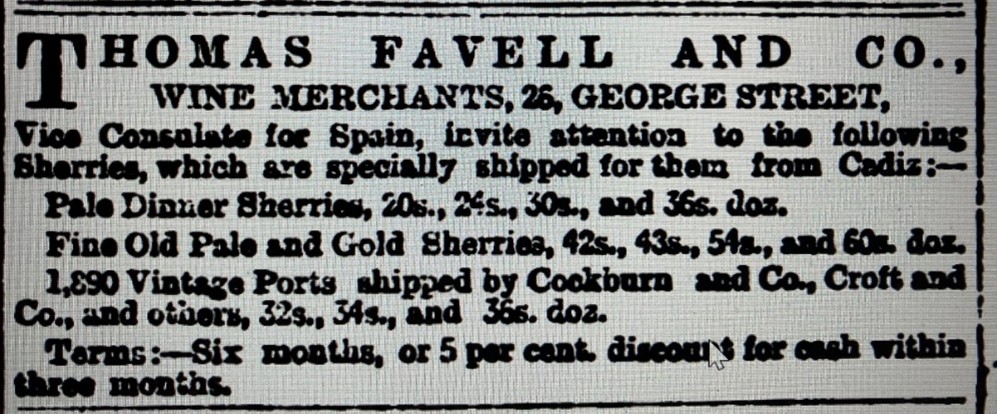
Sheffield Daily Telegraph:29th September 1894 p.1
Initially he and his wife Eliza Caroline lived at Woodburn House, 7 Brocco Bank but in 1887 he sold it, and moved to Sunnyside 248 Fulwood Rd.
Thomas’s wife died shortly before him. They had no surviving children; a son, Thomas Aubrey, was born in 1864 but sadly died in 1867.
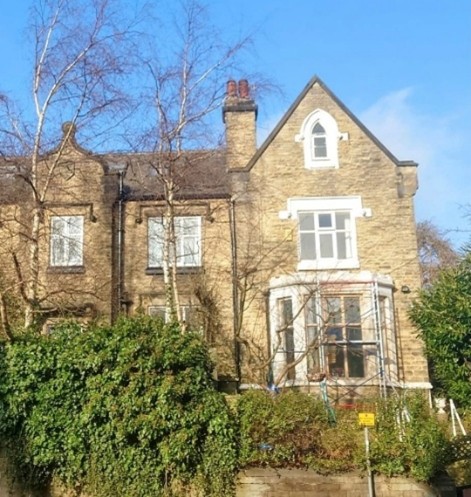
248 Fulwood Road
Charles’ early career looked as though it might develop in the same direction as that of many of his pew neighbours, for example W H Brittain in Pew 33. Brittain and Charles Favell were both silver smiths and silver plate manufacturers. Initially in partnership with Nathaniel Irving, Favell and Irving traded as Creswick and Co. Charles then went into business with another brother, Rupert. In the 1871 Census he is recorded as living at 247 Glossop Road, employing 28 men, 5 boys and 5 women in his business. This partnership was dissolved in 1879 and in 1887 he established Charles Favell and Co.
In 1860 Charles had married Ellen Swift. They had four children: Gertrude, William, Isabel and Charles Edward. In 1900 Charles Edward, working for the British South Africa Company, married Evelyn Ada Birrell, twin daughter of James Birrell of Scotland, in Cape Town by special licence.
However, by then Charles seems to have fallen on hard times. He was recorded as taking out a Deed of Arrangement in 1900 - a way to avoid bankruptcy. He was owing money with liabilities of £1,278 11s 8d but his estimated net assets were only £520. In the 1901 Census he was living with his unmarried daughter Isabel, in three rooms at 4 Park Place Worksop which was also a boarding house, a far cry from 35 Elmore Road, Broomhill where he lived in 1881.
Charles seemed to have been living in Park Place since at least 1896 when his brother Thomas died. On the probate record Charles’ address was in Worksop. His wife Ellen died in 1899 and was buried in Worksop Priory. Interestingly, his occupation is recorded as “wine agent on own account” – perhaps he was trying his hand at the business which had served his brother well!
It is interesting to speculate what forced such a change in fortune: bad investments, an economic downturn, a change in personal circumstances or those of his children?
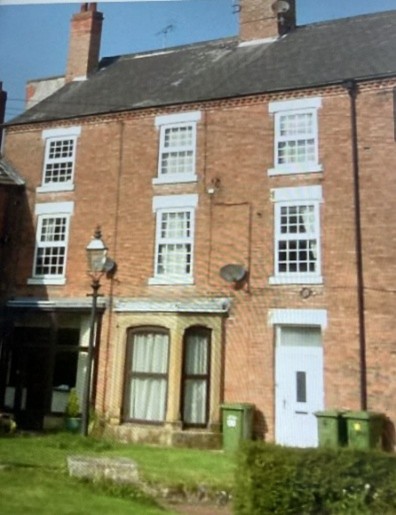
4 Park Place Worksop
Also why move to Worksop? One link could be deduced from the fortunes of his daughter Isabel after her father’s death. She was unmarried and the options for a middle-class single woman of meagre fortunes were limited. In the 1911 Census, Isabel was recorded as working as a lady’s companion to Dora Norris, wife of Arthur James Norris, wine and spirit merchant of Banstead, Surrey. Dora Norris was the daughter of Thomas J. Flockton of Sheffield and Woodleigh, Worksop. Thomas Flockton was the partner in the architect firm of Flockton and Gibbs; he was also a stalwart member of the Sheffield Book Society from 1855 to 1899. He and Charles were regular members of the Committee which met in their homes, including Thomas Flockton’s house at Worksop. Perhaps he was able to help Charles in his time of need.
The different fortunes of these two brothers can be seen in their wills: when he died in 1896, Thomas left £4481 12s 4d, the equivalent of £416,785 in 2025. Charles, on the other hand, left only £30, equivalent to £2,578.
The fortunes of the Favell brothers illustrate just how important social networks were to survival when a family fell on hard times. We would love to find a portrait or photograph of any members of this fascinating family. Do contact us if you have anything to share.
Susan Roe
3 February 2025
Blog 16: Ranmoor’s Lost Church (Part One)
21st January 2025
Download PDF
Most of us will rarely, if ever, think of how the elegant St John’s Church we see above Fulwood Road is not the original church, the one consecrated in 1879. That church, the first St John’s, was destroyed by fire in 1887. In the first of three articles, local historian Val Hewson explores Ranmoor’s lost church.
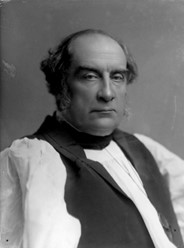
Archbishop William Thomson by Bassano (public domain)
At 11 am on Thursday 24 April 1879, under a dull sky, the Archbishop of York, William Thomson (1819-1890), came to Sheffield to consecrate Ranmoor’s new church. It was a great occasion. ‘At the time the service commenced every available seat was occupied’ (Sheffield Independent).* Archbishop Thomson seemed to have brought most of his local clergymen with him – the Sheffield Telegraph names 42 and finishes its list with ‘&c’. Grandees from Oakbrook, Thornbury, Storth Oaks, Riverdale and the other big houses in Ranmoor came to meet the clergy. John Newton Mappin (1800–1883), who had paid for the church, was there, of course, along with his nephews, John Yeomans Cowlishaw and Frederick Thorpe Mappin. The Firths were represented by the great industrialist himself, Mark Firth, and his brother, Charles Henry Firth. There were at least six men - Mark Firth, Frederick Mappin, Abram Brooksbank, John E Bingham, William H Brittain and John B Jackson – who served as Mayor of Sheffield; and three of them – Messrs Firth, Brittain and Bingham – were also elected Master Cutler. The wives, mothers, daughters and sisters of all these men would have been present too, parading in their fashionable best, but of course they didn’t rate a mention in the newspapers.
The architectural historian Nikolaus Pevsner described ‘our’ St John’s as 'opulent outside and inside'. In its Grade II* listing, English Heritage notes: the Gothic Revival style; the sculptural work of Frank Tory; the bell tower and spire; the ‘ornate ashlar and marble font’; the ‘square traceried oak pulpit’; and much more.
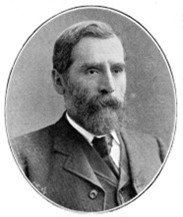
Architect Edward Mitchel Gibbs (1847-1935) (Picture Sheffield. Ref: y08517)
Of all this splendour, designed by the architect Edward Mitchel Gibbs, then just 32 years of age, only the bell tower and its spire were part of the first St John’s. Everything else comes from Gibbs’ 1887 plans for the second church (or alteration and restoration since). What then was Gibbs’ original design? Was it as opulent, as elegant, as the church we know?
Our best information comes from the newspaper coverage of 1879. The Yorkshire Post and Leeds Intelligencer (Friday 25 April 1879, p. 4) commented: ‘Without profuse decoration, the church is one of the prettiest in Sheffield.’ There was a hint of criticism – a Leeds newspaper, after all – in its ‘The building has a sloping roof, and looks narrow from the outside’. But it redeems itself: ‘the interior is very pleasing’. And in fact the Independent was worried too:
… The immense height of the spire, and the very sloping roof of the church, at first convey the impression that the church itself is somewhat stunted. This, however, soon passes away …
On the whole Sheffield’s press was admiring. There is so much detail that you suspect the architect took reporters round and checked their notes afterwards. The Telegraph’s man, who carefully noted the overall cost of about £15,000 (almost £1m today), was impressed from the outset:
… on ground some feet higher than the Ranmoor-road, [the church] presents an imposing appearance viewed from all parts of the locality. … The main entrance is beneath the tower, and forms one of the features of the building. Carriages are able to drive to this door, and can return down Ranmoor Park-road without turning round. The spire is 190 feet high above the church floor, and 220 feet above the footpath in Ranmoor-road, being the highest in Sheffield.
It’s much the same today: our church sits above the road, spire piercing the sky. Cars can drive in one gate and out the other. The grounds, not large, are grassed over. In 1879, they must have been more elaborate, as landscaping ‘was entrusted to Mr. R. Marnock’. Robert Marnock (1800–1889) was a leading garden designer, who worked on Sheffield’s Botanical Gardens and the General Cemetery. St John’s must have been a simple commission, but his involvement indicates how much John Newton Mappin and his neighbours wanted to make a mark for their affluent suburb.
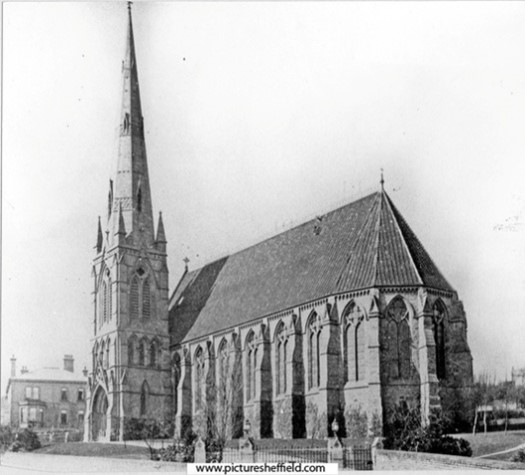
St John’s in 1879 (from The First Hundred Years 1879-1979, © St John's Church)
The interior of the church was architecturally striking:
The style of architecture is early Gothic. The plan has been so designed that there are no pillars to obstruct the sight, the whole edifice being covered by one roof. The features of the interior are the elaborate open timbered roof, the lofty windows, and the arrangements of the chancel
… The internal dimensions are 130 feet long, 38 feet wide, and 53 feet high. The east end is apsidal … (Telegraph)
The effect of the open roof would have been heightened by the ‘numerous and large’ windows of clear glass (although the Independent thought it was ‘tinted’). The hope was, the Telegraph said, that ‘they may some day be fitted in with stained glass’.
The Telegraph enthused about the rich furnishing by expert craftsmen. (Here is more evidence of Ranmoor pride.)
The decorations of the walls and reredos are only intended to be temporary until the building is properly seasoned. This work has been executed by Mr. Puttrell from the architect’s designs.
James Puttrell was a local master painter and decorator. The church had room for ‘559 adults’, whose ‘pews are covered with Brussels carpets, and footstools to match. The seats are cushioned in crimson’. The pulpit was ‘upholstered in crimson velvet, with velvet pile carpet on the floor and pulpit steps’, while the aisles were ‘covered with Napier matting, with a plain centre and effective border’. The floor tiles were Minton and the roof tiles from the local Broomhall Company. Newton, Chambers, Sheffield-based and one of the biggest firms in the country, supplied the heating and metalwork.
Just as John Newton Mappin paid for the building, and James W Harrison gave the land, so many of the important local families donated treasures to the church.
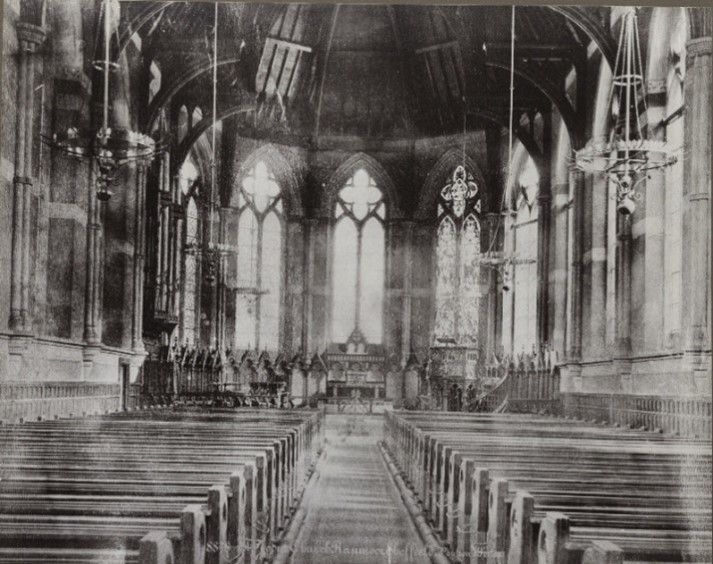
The interior of the 1879 church (from The First Hundred Years 1879-1979, © St John's Church). Here are the large windows, the timbered roof, the carpeting, the pulpit and the lectern.
The pulpit is very elaborate, the work of Mr. Charles Green, from the design of the architect. Wood and bronze are combined in the design, and the effect harmonious, warm, and becomingly appropriate to the appointments. … Mr. J. Y. Cowlishaw presented the pulpit, at a cost of about £400. The font, the gift of Mr. W. H. Brittain, is of Ancaster stone, with marble columns. Mr. J. B. Jackson has provided the lectern … The communion plate is of silver, gilt and oxidised, and has been presented by Mr. J. E. Bingham. Mr. Herbert Hutton has given the collecting plates and alms dish; Mrs. J. B. Ellison the communion table cloth, and Mr. Alfred Dearman the clergy service books. (Telegraph)
The Independent thought the pulpit ‘perhaps the most beautiful work of art in the church’ and ‘altogether unique’:
… of Italian walnut, with bronze enrichments and ornaments, the work of Mr. C. Green. Octagonal in form, it is supported by eight, fluted bronze pillars, with decorated caps and bases; and there is quite a wealth of panels, figures, and ornaments in the same metal.
The organ and bells impressed by their scale.
The bells are eight in number, and weigh three tons 10 cwt, the tenor bell being 15 cwt. They were cast by Mr. James Barwell, of Birmingham, and have been fitted up on the most improved principle by Messrs. Shaw and Sons, of Bradford, under the superintendence of Mr. J. R. Cordingley, of that town. The bells are the gift of Mr. W. Smith, of Springfield House, Fulwood. (Telegraph)
The bells, the Independent said, ‘are worked by an ingeniously constructed machine … by which one man can effectively manage the whole peal’.
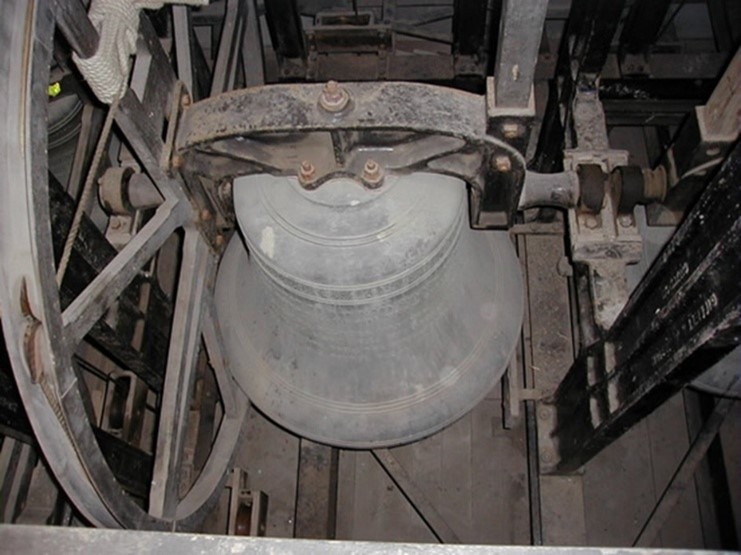
The tenor bell (© St. John's Ranmoor Bellringers)
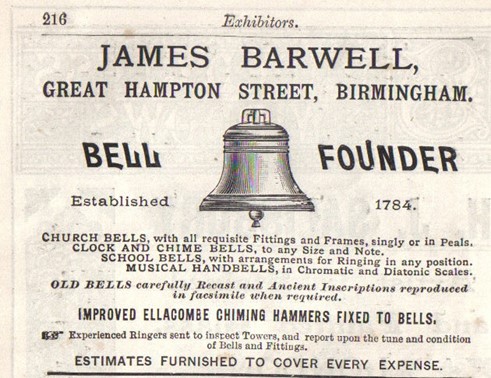
An advertisement for James Barwell from the Illustrated Guide
to the Church Congress (1897) (public domain, via Wikimedia Commons)
The organ, given by Charles Henry Firth, was the work of a local firm, Brindley and Foster. The Telegraph included a detailed specification, listing the many stops like ‘lieblich gedact’, ‘flauto traverso’, ‘vox angelica’ and ‘quint bass’. The congregation had the chance to enjoy its music, as hymns and canticles were sung ‘under the leadership of Mr. T. Tallis Trimnell, Mus. Bac., who presided at the organ’ (Telegraph). The splendidly-named Thomas Tallis Trimnell was the organist at Sheffield Parish Church and a noted composer.
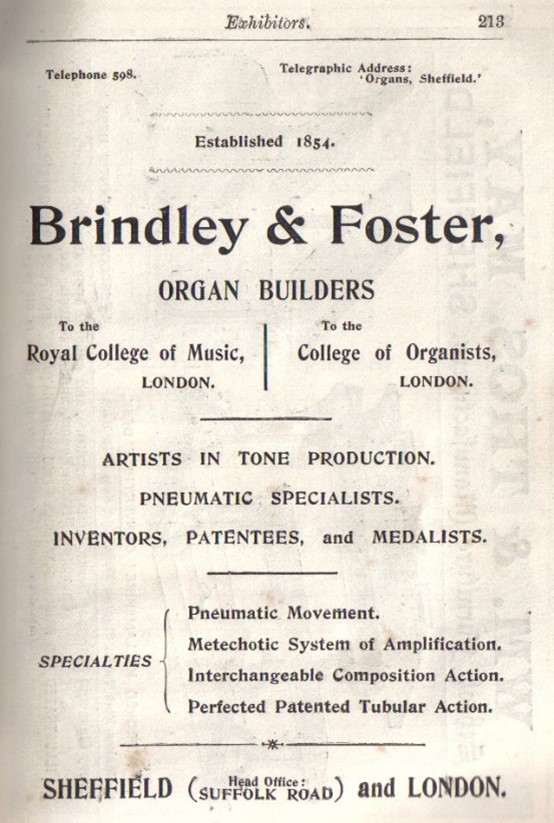
Advertisement for Brindley and Foster from the Illustrated Guide to the Church Congress (1897) (public domain)
The consecration itself was a simple and, in a sense, legal ceremony.
The petition for consecration was presented to the Archbishop by Mr. Newton Mappin. His Grace, having received it, ordered it be read … Mr. Thomas presented the conveyance of the site of the church, the deed of patronage, &c, which were received by the Archbishop, who, sitting in his chair, read the sentence of consecration, which he subsequently signed, and ordered it to be enrolled and preserved amongst the muniments in the registry. (Telegraph)
Before his sermon, Archbishop Thomson took time to praise John Newton Mappin:
I know that this is no mere gift of money which could be well spared. Much thought and care and anxiety have gone along with the gift … [Mr Mappin’s] liberal hand, his thinking head, his daily watchful mind, have altogether brought this house to its completeness. (Telegraph)
John Newton Mappin’s St John’s, as we know, was not long complete. But it certainly appears to have been as beautiful and splendid as our St John’s.
Val Hewson
20 January 2025
* All the quotations above, unless noted otherwise, come from the Sheffield Daily Telegraph (Friday 25 April 1879, p. 3) or the Sheffield Independent (Friday 25 April 1879, p. 3).
Blog 15: Scissors Paper Stone 2025: The Year Ahead
6th January 2025
Download the PDF
When we look at the portrait of this Sheffield household, it brings home the fact that for every wealthy householder there are a crew of men and women who makes his lifestyle possible. Picture Sheffield think this is a portrait of George Senior and his dependents, who lived in Northumberland Avenue, probably in the first decade of the twentieth century when a man of his station (a steel manufacturer) would have had both a car and a carriage. It is most unusual to be able to discover such complete cast of home-makers.
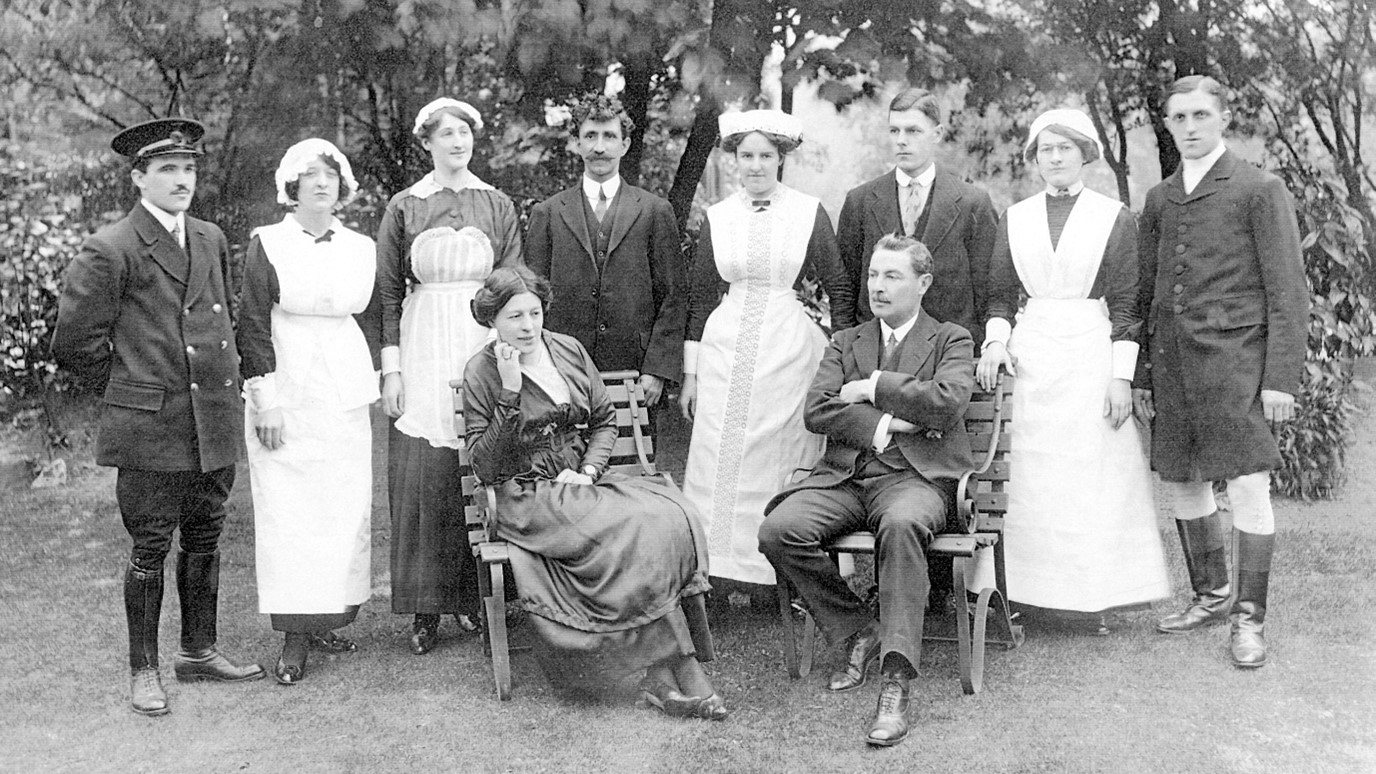
Picture Sheffield – ref: u02070, © Carol Burgess
We can identify George alongside his wife but many questions remain unanswered. I presumed that the hand above the master’s shoulder was that of the young man who might be his son but in fact it is the hand of a woman, surely a senior servant with her assured air and elegant apron. And who is the young man behind Mrs Senior, his hair luxuriant and curly? A suit slightly too crumpled to be worn by a son? A gardener in Sunday best or a junior groom? From their uniforms we can guess the identities of some of the staff circling the family: the chauffeur, a groom, housekeeper, nanny and ‘tweenie’ (always the youngest of the female staff who ran up and down between floors at the bidding of the housekeeper in the basement). The maid on the left with the rather frothy apron and bib might be a nursemaid, her costume not business-like enough for a kitchen. But the closer one looks the more questions are raised. Answers welcome.
The marriage registers of St John’s in the late nineteenth century record that 85% of the weddings were between men and women who were not wealthy, but who served the needs of families who were: grooms, gardeners, carpenters, shopkeepers, dressmakers. They were men and women with a wide range of skills.
Last year, the Scissors Paper Stone team explored the lives of the people who created the fabric of our church: stone masons, donors, artists and craftsmen. In 2025 an ever-growing team of researchers are going to find out what they can about the men and women who supported the domestic and social life of those men and women who rented pew seats at St John’s. We are starting with two invaluable lists: one of all the men and women who could afford to rent a sitting from 1889-1891 and one of all the marriages in the first decade of the church’s life.
We were extremely fortunate in 2024 to draw on the expertise of many distinguished local historians. In 2025 even more have volunteered their time and talents. You will see from our calendar that our events will take various forms: a walking talk round the Ranmoor shops, a display of the kinds of cookery books used in Ranmoor’s mansions, talks by leading experts in the history of this area and a two-week exhibition in which local artists respond to the social mix that made up our shifting and varied community. Dan Eaton and I are offering history workshops to history students and primary school children. We will all seek to understand the way different kinds of groups related to others of a different status: craftsmen to wealthy manufacturers, seamstresses to embroiderers, housekeepers to mistresses of the house.
If you would like to share your own family’s history with the project do get in touch with me. I am also looking for volunteers to welcome visitors to the church during the art exhibition in June and to provide refreshments. Cake always has the power to make us welcome in a church which, however beautiful, can even in summer be sometimes dark and cold.
Every two weeks our team will share our findings in the blog posts which you can find on the church website. Type in ‘Scissors Paper Stone St John’s Ranmoor’ and you will reach us, or you can scan the QR code to be taken straight there. We are delighted to begin 2025 with a sequence of blogs from the noted Sheffield cultural historian, Val Hewson. Our next blog will be her introduction to the people involved in the building and consecration of ‘Ranmoor’s lost church’ in 1879. Enjoy!
Mary Grover
6th January 2025
Blog 14 - Artistry in Stone, Wood and Bronze: the carvings of architectural sculptor, Frank Tory, and his two sons, with particular reference to St John’s, Ranmoor
11th December 2024
Download the PDF
As part of the Scissors Paper Stone project, Sylvia Dunkley recently gave a talk on Frank Tory and his sons who were responsible for the carving in St John’s. The article below is a summary of it.
Those readers who know the inside of St John’s Church may have at some point admired the very fine stone carving. Much of this is the work of architectural sculptor, Frank Tory (1848-1938), who was responsible for carving the capitals (head feature of a column), the corbels (projecting block supporting something above) and the magnificent reredos (screen behind the altar). It is said that if stone carvers from other parts of the country were in Sheffield they would always ask to see Tory’s work at St John’s.
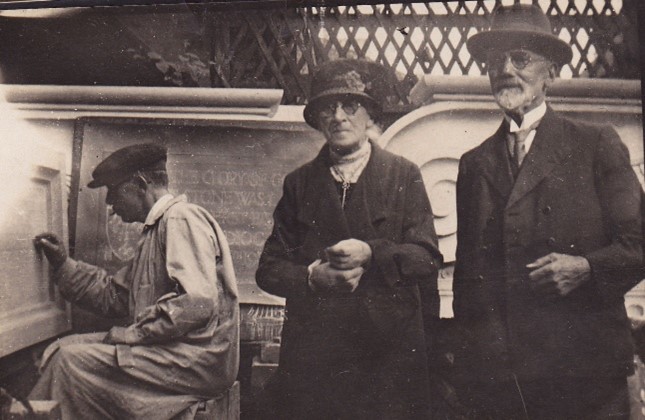
Frank and Harriott Tory
Frank Tory’s ancestors were Huguenots from France. He grew up in Kent and studied at the Lambeth School of Art. He came to Sheffield as one of the team of stone carvers who worked on the Corn Exchange which was being built for the Duke of Norfolk at the end of the 1870s. It seems Tory was asked to stay in Sheffield because the architect for the Corn Exchange was so impressed with his work. Tory brought his family to the city and had his first workshop in a small, crowded court known as Sans Paviour roughly where the City Hall is today.
Examples of Tory’s carving can be seen all over the city on ecclesiastical, commercial and public buildings. Some of his first commissions were for prominent office buildings in the city centre. Two of these are on High Street: Parade Chambers (1884) for a firm of local stationers with its portraits of Chaucer and Caxton, its gargoyles and its mythical beasts, and the sadly neglected Cairns Chambers (1896) with its fine statue of the 1st Earl Cairns, Lord Chancellor during Disraeli’s ministries and its portrait heads of Edward, Prince of Wales, and Princess Alexandra. Another building Tory worked on was Carmel House (1892) at the corner of Fargate and Norfolk Row which was built for the Young Men’s Christian Association. It is covered with religious carvings: the symbols of the four evangelists, a sequence of ten arched panels, six depicting the six days of creation and the other four the progress of Divine law. There are also shields bearing the arms or signs of the twelve Apostles.
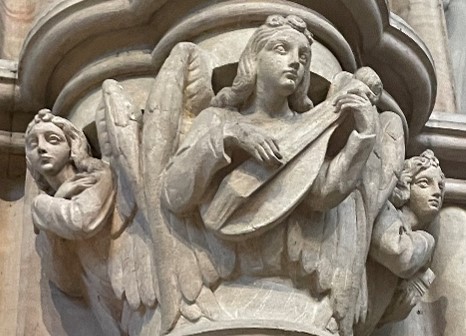
Carving on the south side of the chancel arch.
Tory was particularly in demand for his ecclesiastical carvings, both in stone and in wood. In St Matthew’s in Carver Street, the oak font and pulpit are both his work as is the very striking gilded altar surround with its angels at the top and its niched figures on either side. There are newspaper reports of Tory being commissioned to work in churches across South Yorkshire and further afield in towns like Preston. He also undertook commissions for external carving such as the majestic stone pillars that were designed to hold the gates to the churchyard of the Parish Church of St Peter and St Paul (now Sheffield Cathedral) which are still there today.
The architect designs for the new St John’s church after the original building was mainly destroyed in a disastrous fire in January 1887 can still be seen in Sheffield Archives. They show that Frank Tory was closely involved in the designs for the work he was responsible for carrying out, whilst the very comprehensive 1990 account by the NADFAS Recording Group of the internal fixtures and fittings in the Church gives us detailed descriptions of Tory’s work. The capitals on the columns in the nave, each one different, are densely carved with foliage as are many of the corbels. The corbels in the Chancery arch are particularly fine. The corbel to the north side of the chancel arch has an elaborately carved base surmounted by the Agnus Dei (Lamb of God) with the banner of victory and two praying angels either side. The corbel to the south side has an equally elaborate carved base and above this are three angels. The one to the left has folded arms, the one in the centre is playing the mandolin and the one to the right holds pan pipes. The stone and marble reredos, depicting the Last Supper which is carved in alabaster, has a canopy with crocketed gables above it and the figures of St Peter and St Paul on either side. The coloured marble shafts are particularly striking. Frank Tory was also responsible for the carving of the original choir stalls in dark oak.
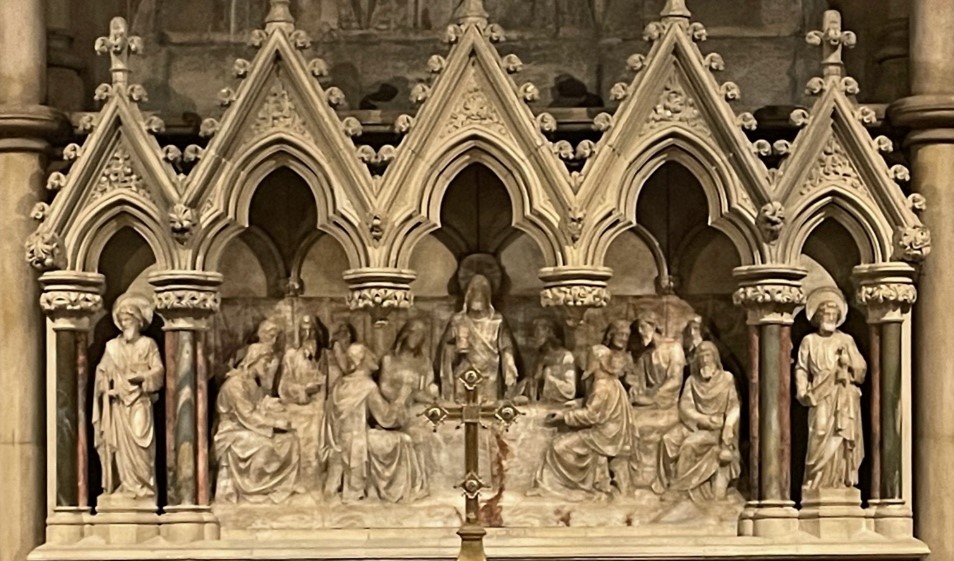
The intricately carved reredos.
He and his wife had twin sons, Alfred Herbert and William Frank (always known as Frank) who were born in 1881. Both sons attended the Sheffield School of Art whilst apprenticed to their father and together the three of them formed the firm of Frank Tory & Sons which was located on Ecclesall Road where the Porterbrook public house now stands. Alfred and Frank jnr. were commissioned to carve the Chancel and Lady Chapel screens for St John’s, both of which have now been removed. Like their father, their work can be seen all over Sheffield and they undertook commissions in many towns and cities such as Leeds where they briefly had an office, Hull, Birmingham and even Brighton. The firm closed down about 1960.
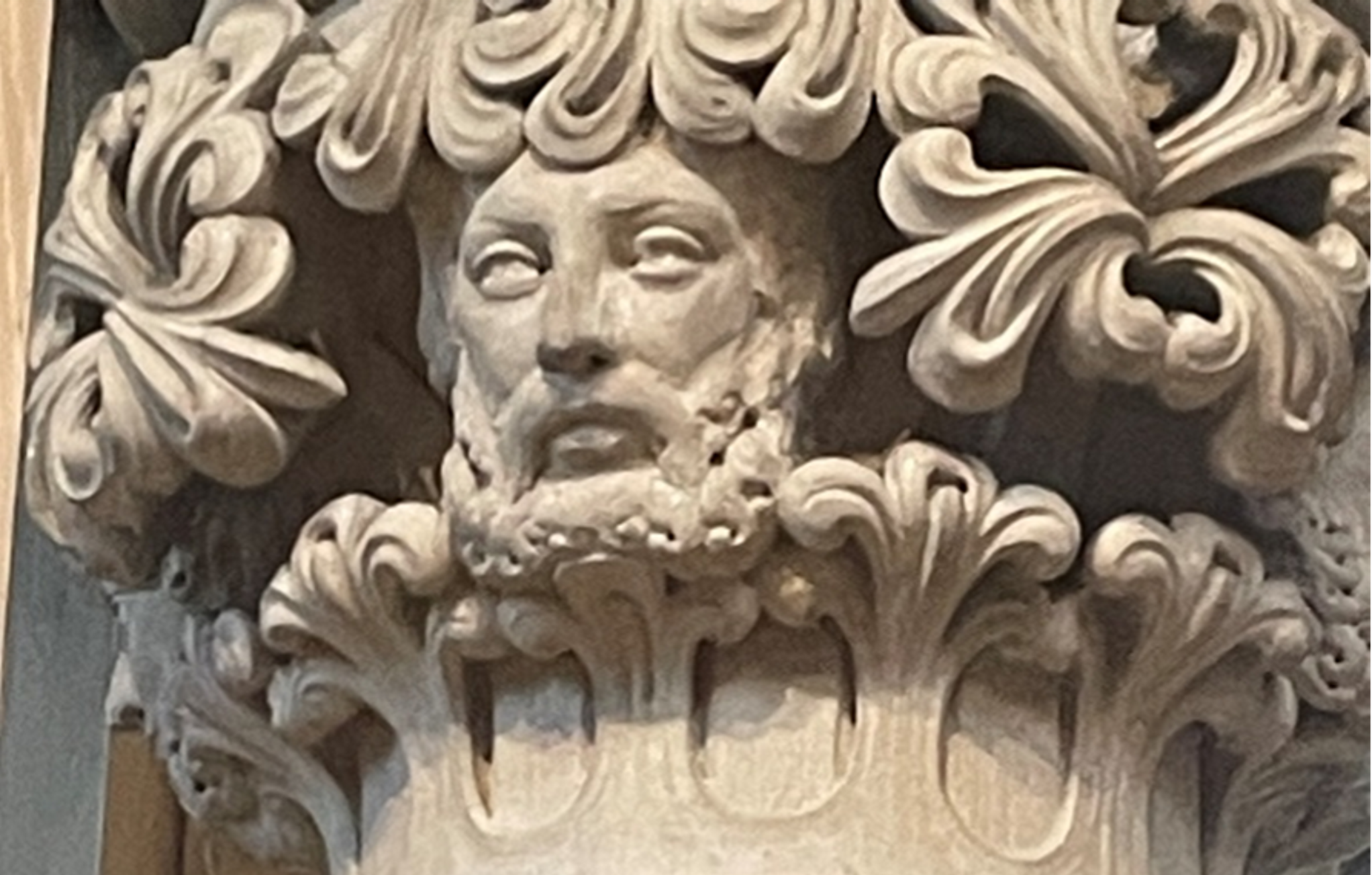
Capital in the chancel with a face
Tory’s carving in St John’s is of an exceptionally high quality. As the 2004 Pevsner Architectural Guide to Sheffield records, “His decorative sculpture throughout the church is one of his finest achievements, matching the depth and finish of the medieval work that inspired it and displaying artistry and craftsmanship in every leaf, flower and figure.” The story of Frank Tory and his two sons is an important part of the history of Sheffield’s built heritage from the nineteenth and first half of the twentieth centuries.
Sylvia Dunkley
November 2024
Blog 13 - The Stonemasons who Built St John’s
14th October 2024
Download the PDF
As part of the Scissors Paper Stone project, Val Hewson and Sue Row recently gave a talk on the stonemasons who may have built St John’s church. It was inspired by the masons’ marks discovered in the triforium by Mark Gregory, one of the church wardens. Here Sue gives a summary of it.
Tracking down the individuals who made these marks was not easy; very often we had only the initials, sometimes with a date. The census records were an obvious source of information but were not always as helpful as we had hoped. Not only was the information scarce, it was often unreliable.
One mark was W. Thornton, not too difficult, one would have thought. I discovered a Watson Thornton in the 1861 census. He was born in 1842 so was the right age for working on the church in the 1880s. According to the transcript of the census, Watson, his father and brother were all stone masons, but unfortunately, when I checked the original census document, all three were recorded as steel melters!
There was one mark, WBP, which was more promising, having three initials to work with.
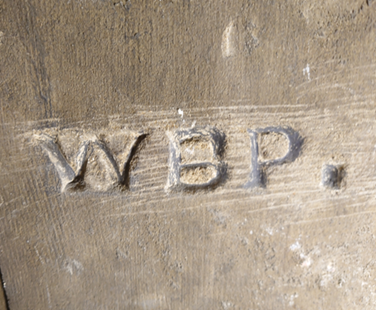
We are confident he was William Baildon Palmer, a stone mason who is recorded as living in Brightside in the 1891 census. Though a long journey with his tools, he could have found temporary lodgings nearer his work as many itinerant masons did. We discovered quite a lot about Palmer. He was born in Nottingham in around 1862. His father was a coachman at Knowle Manor, a Grade II* listed manor house in the West Midlands. He died in Brightside on 3 July 1904 of phthisis at the age of 42. According to the Operative Stonemasons Union, his family was entitled to £12 in benefit.
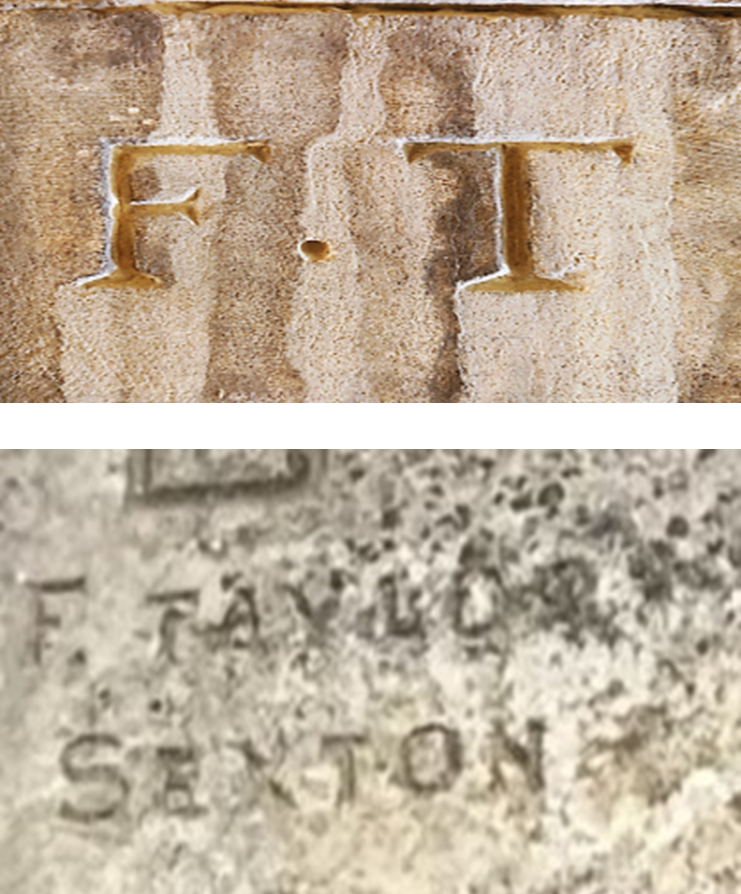
We don’t know for certain who FT was. My personal favourite is Farewell Taylor who was from Dore, which was a long walk from St John’s. At some stage he was made sexton of Dore church and there is evidence of his work as a monumental mason in the church yard.
He died in 1932 and is buried in Dore church yard in the same grave as Sarah Keeton who died in 1927. This was a mystery as I knew he had never married. However, after further investigation the problem was solved: a widow, she was his housekeeper.
One possibility for IW is Isaac Wardley. He lived in Woodseats which seems a fair distance from St John’s but workers often walked what seem to us long distances to and from work. Also, by the 1890s there were horse drawn trams so he could have used them. His son, Isaac, was also a mason. The mark was made in chalk, not incised, so could well have been done by the younger Isaac who was only 14 in 1892.
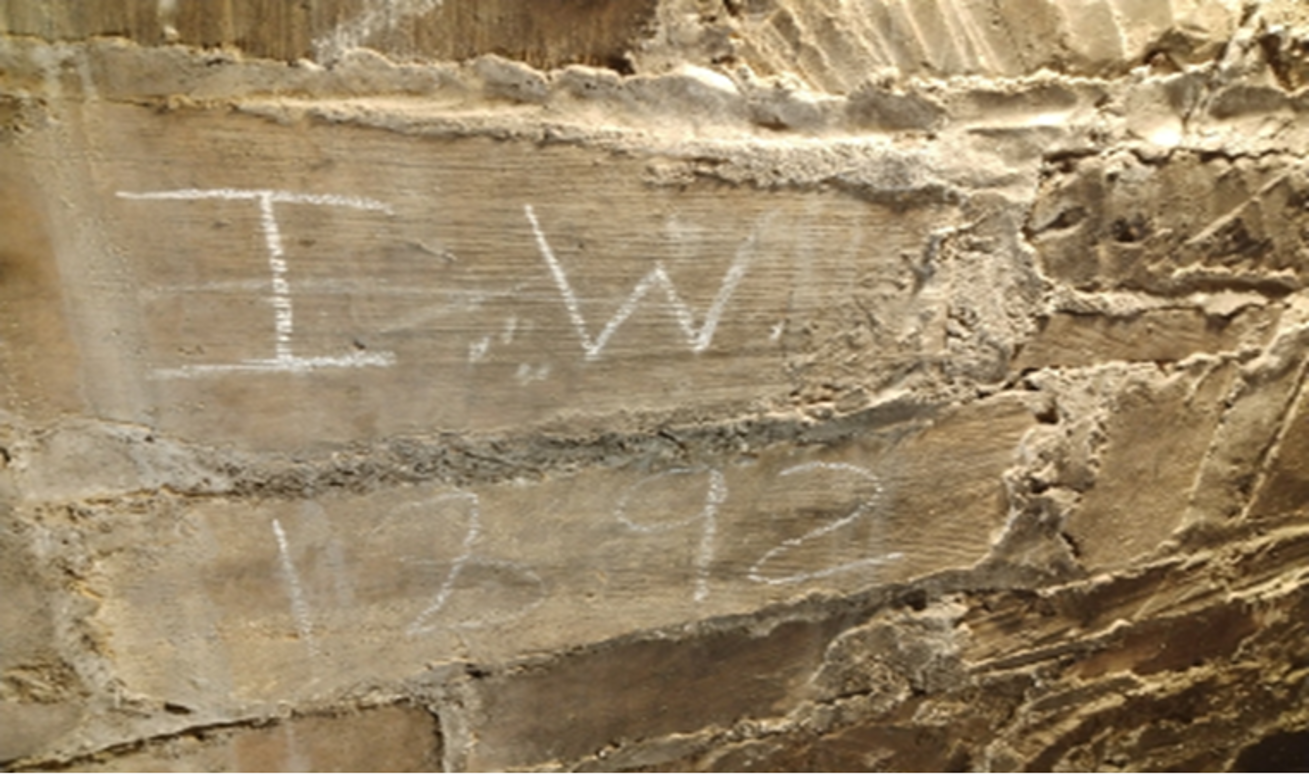 IW1892
IW1892
We also investigated the stone masons who lived near to the church who, though not indicated by the marks, may well have worked there. One such family was the Hancocks. Samuel Hancock senior, born in 1835, lived in Fulwood and was a sexton at Fulwood Church. Samuel Hancock junior, born 1860, was also a mason and became a builder and monumental mason.
In 1901 Pendeen Rd at Nethergreen was a hotbed of masons: 7 in total including Samuel Hancock, builder and marble mason, at number one, is brother Arthur, also a mason and master builder, at number two.
Newspapers were another valuable source of information. Master builders and monumental masons took out advertisements and court cases were reported. According to a report in the Evening Telegraph of February 1895, Samuel Hancock junior was sued by Frank Cuthbert for £6.10s when his pony was killed falling into the quarry off Armthorpe Road worked by Hancock.
Although the information with which we were working was fragmentary and not as conclusive as we had hoped, it was fascinating to try to recover the stories of the masons who may have worked on the church, the type of working men who rarely make it into the history books.
Susan Roe
11 October 2024
Blog 12 - The Stones of St John’s - A geological assessment
28th August 2024
Download the PDF
The geologist Scott Engering gave a fascinating talk as part of the Scissors Paper Stone project setting out what we know about the geology of the stones used to make St John’s. Here is a summary of it.
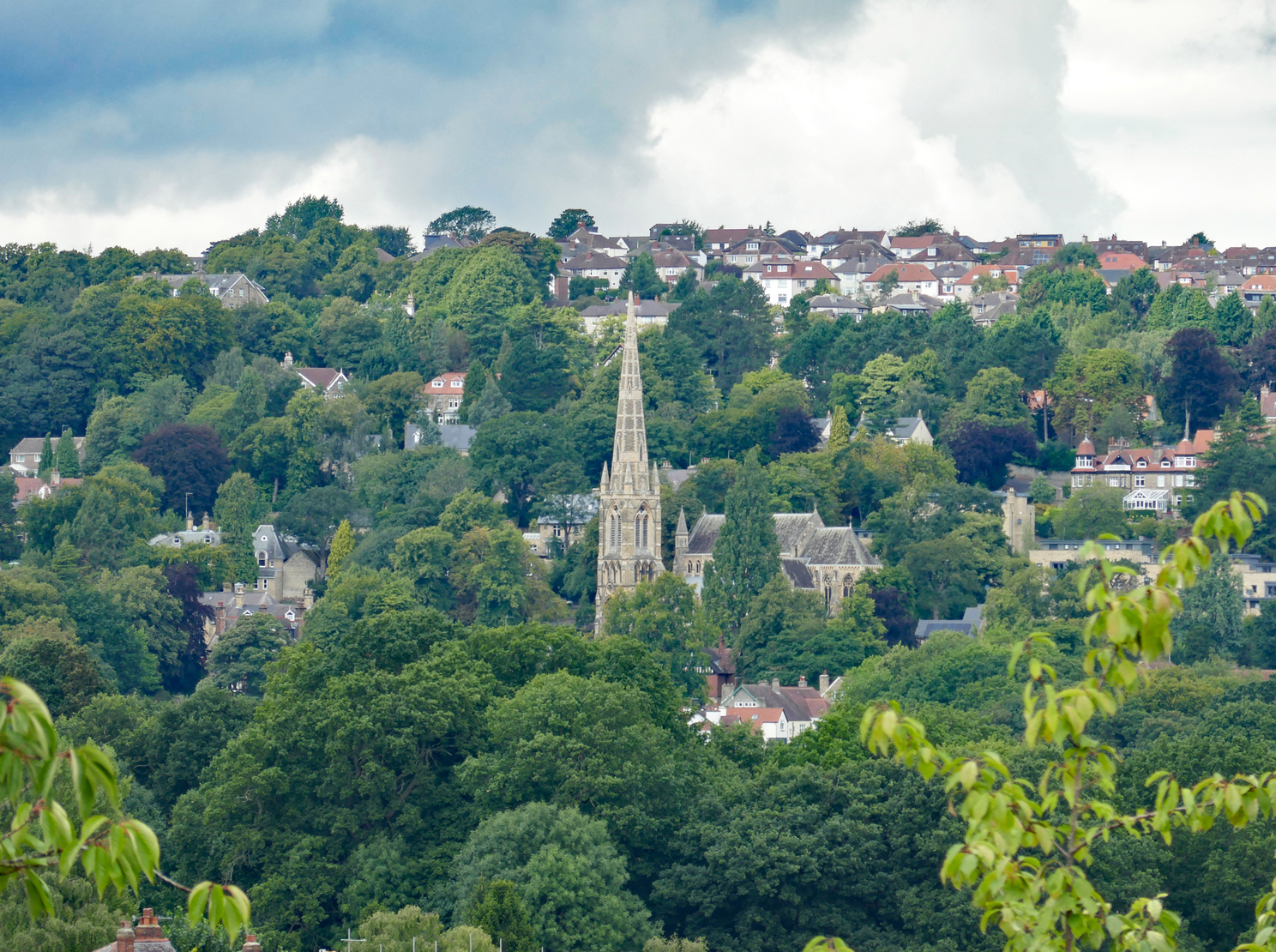
The City of Sheffield is not best known for its historic architecture but, when exploring the Porter Valley, I have seen St. John’s church from many viewpoints and I think that it is one Sheffield’s most distinctive landmarks, particularly with its very tall spire.
As a geologist with expertise in building stones, looking at it closely for the first time, I was very surprised to discover that the dressings to the exterior and the stone for the interior are made of Ancaster limestone from Lincolnshire – which has a very good reputation as a building stone – but the walling of the exterior is built with an inferior quality sandstone.
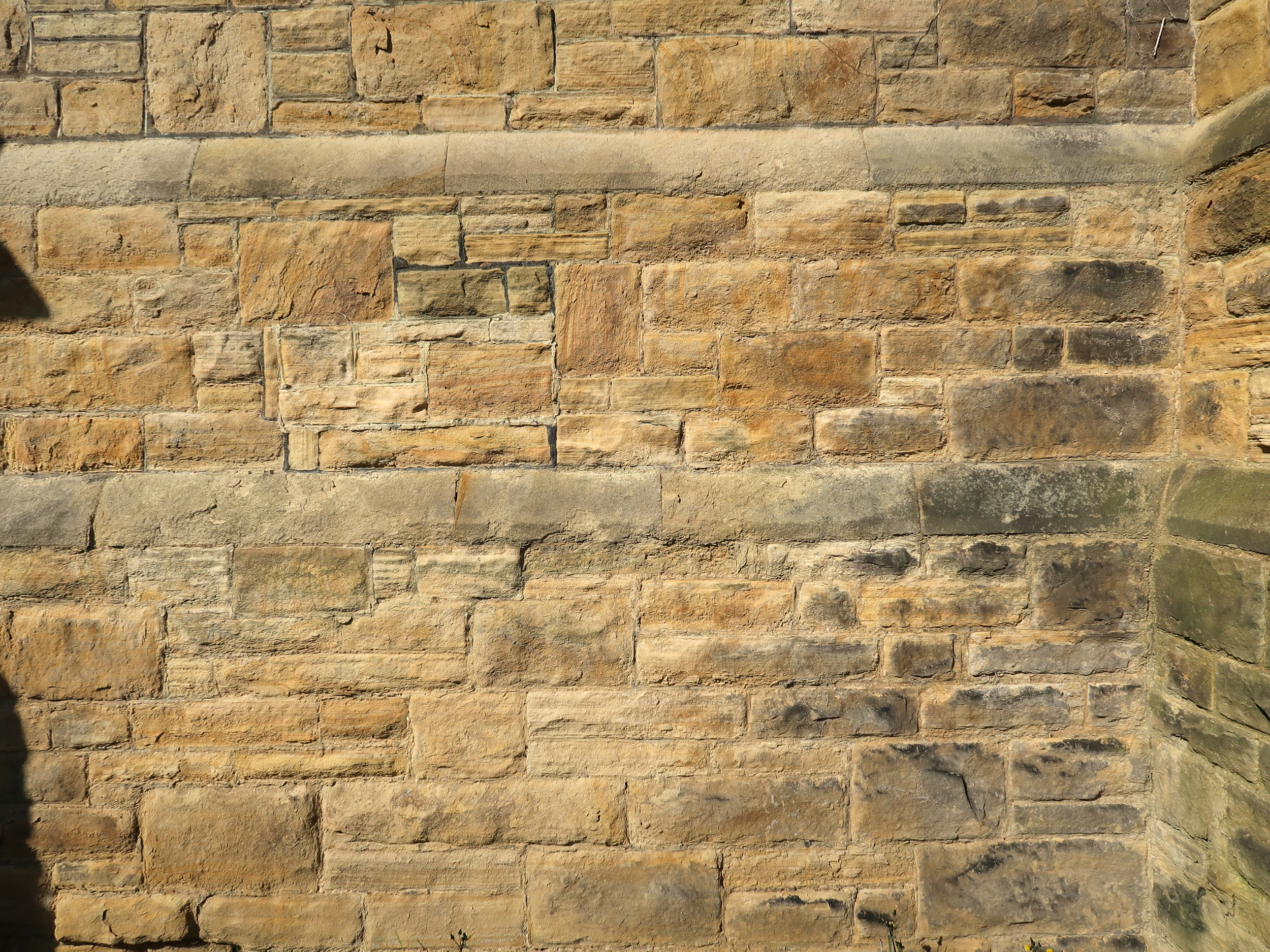
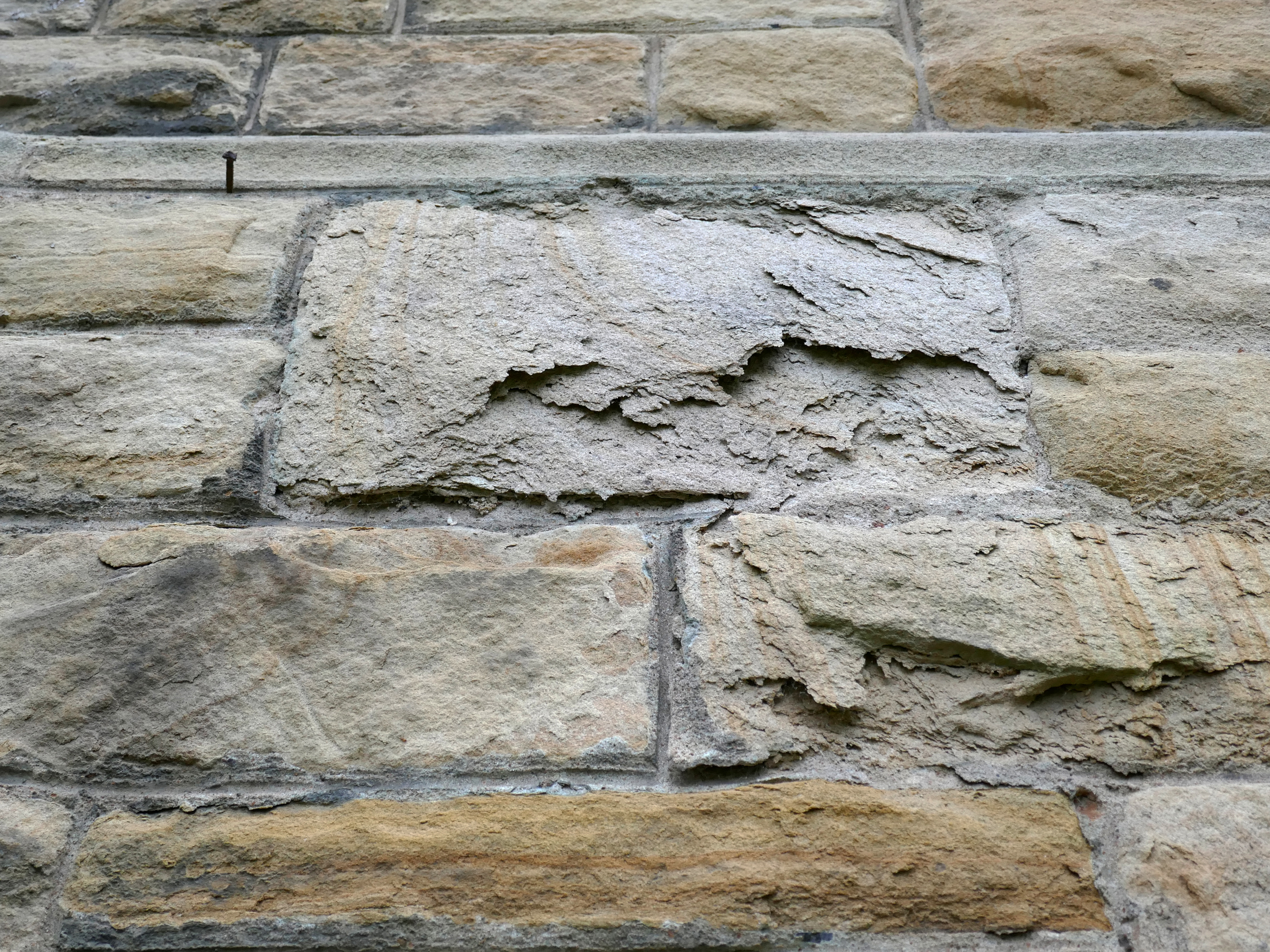
When the original church was built in 1879 by E. M. Gibbs and then rebuilt in 1888, high quality medium grained sandstones from Derbyshire and West Yorkshire had been widely used in very many of Sheffield’s prestigious buildings.Unlike West Yorkshire, which still produces top quality sandstone that is widely exported to the rest of the UK, Sheffield has only quarried sandstone for local use; however, the fabric of the many buildings that are contemporaneous with St. John’s church are generally still in very good condition.
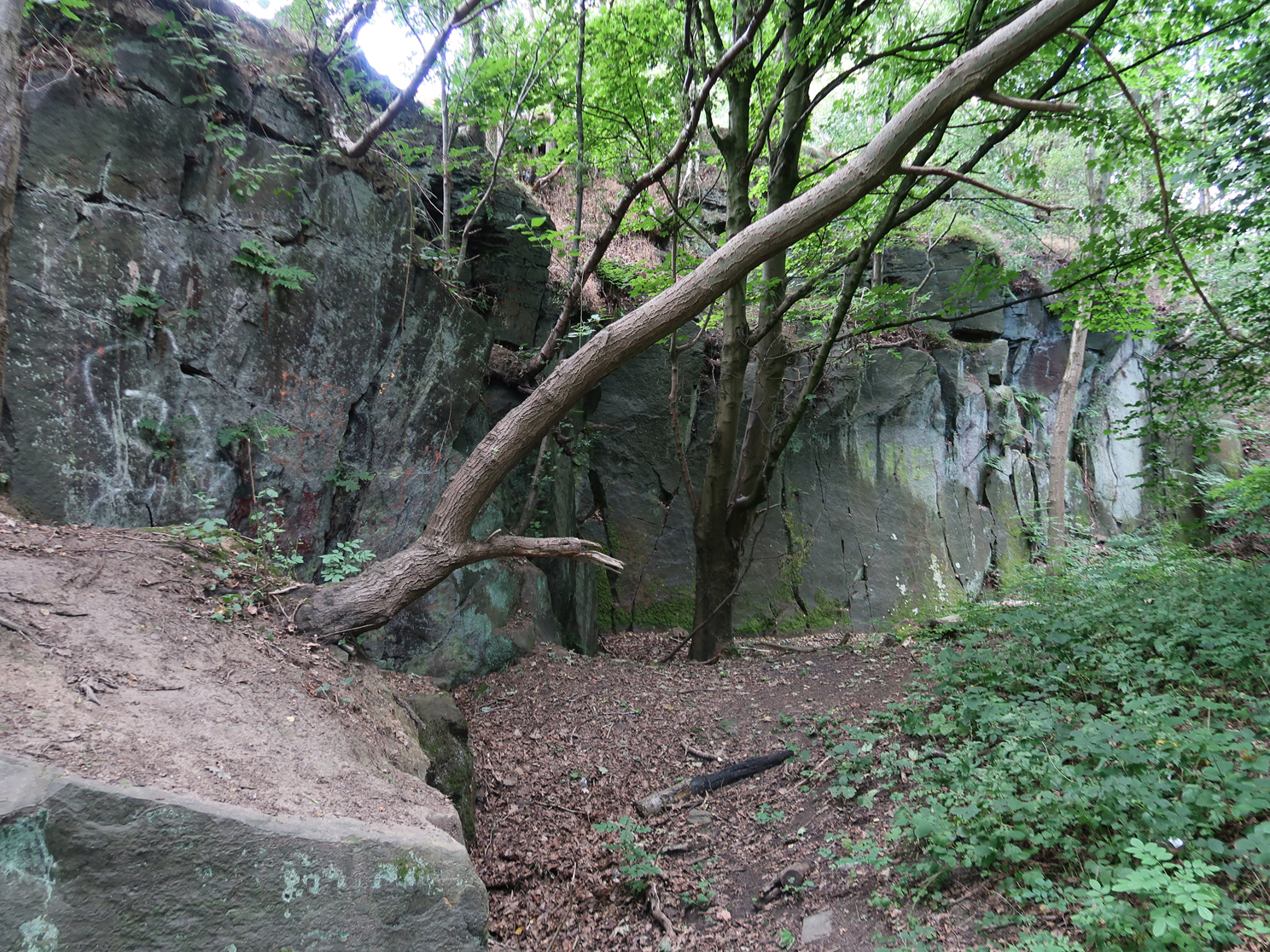 According to newspaper cuttings, the sandstone is from Oughtibridge, where most of the quarries have been sited on the Loxley Edge Rock, a sandstone formation that tends to be very coarse grained in this part of Sheffield. At the time when the church was first built, the Haggs Stones quarry was by far the largest quarry working this formation and samples previously collected from the quarry are a reasonable match, but this is far from conclusive.
According to newspaper cuttings, the sandstone is from Oughtibridge, where most of the quarries have been sited on the Loxley Edge Rock, a sandstone formation that tends to be very coarse grained in this part of Sheffield. At the time when the church was first built, the Haggs Stones quarry was by far the largest quarry working this formation and samples previously collected from the quarry are a reasonable match, but this is far from conclusive.
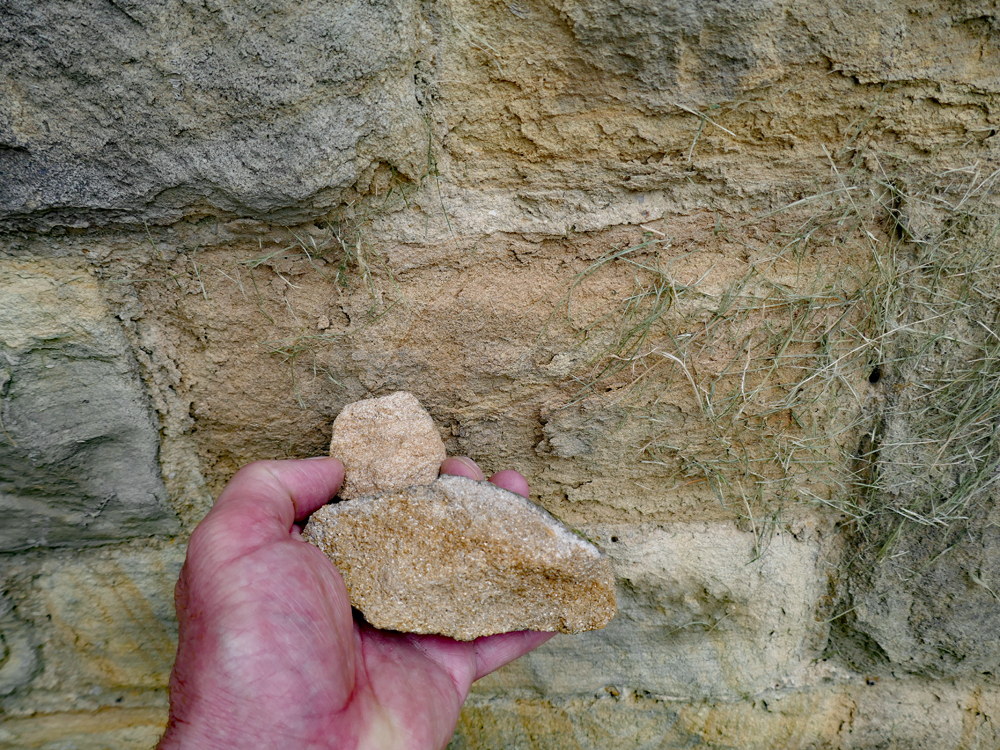 The mixture of limestone and sandstone has been considered to be the cause of the advanced state of decay of the sandstone masonry in the spire, which is usually associated with very high levels of atmospheric pollution. In industrial areas, acid rain reacts with limestone to form calcium sulphate, a highly soluble salt that dissolves, runs down the masonry and recrystallises within the pores of the sandstone.
The mixture of limestone and sandstone has been considered to be the cause of the advanced state of decay of the sandstone masonry in the spire, which is usually associated with very high levels of atmospheric pollution. In industrial areas, acid rain reacts with limestone to form calcium sulphate, a highly soluble salt that dissolves, runs down the masonry and recrystallises within the pores of the sandstone.
For the interior of the church, which is in the Early English Gothic style and has the dimensions and features of a small cathedral, Ancaster limestone has been used throughout and, looking closely, a pink tinge to the stone is often seen. The exquisite carved stonework is by the eminent architectural sculptor Frank Tory, who had already demonstrated that he was very capable of producing very intricate carving in gritstone, as seen at the old gates to Sheffield Cathedral and the adjoining Parade Chambers.
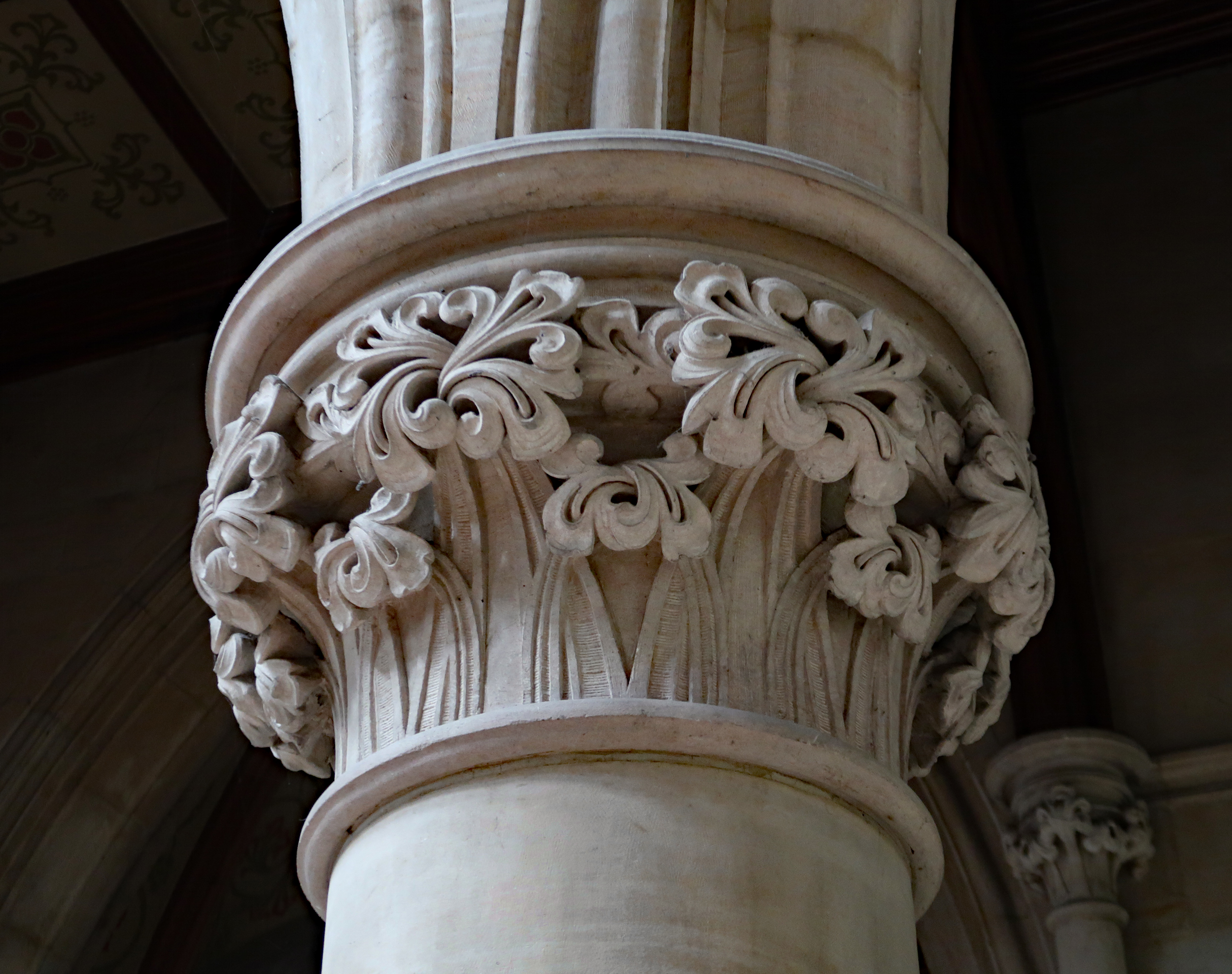
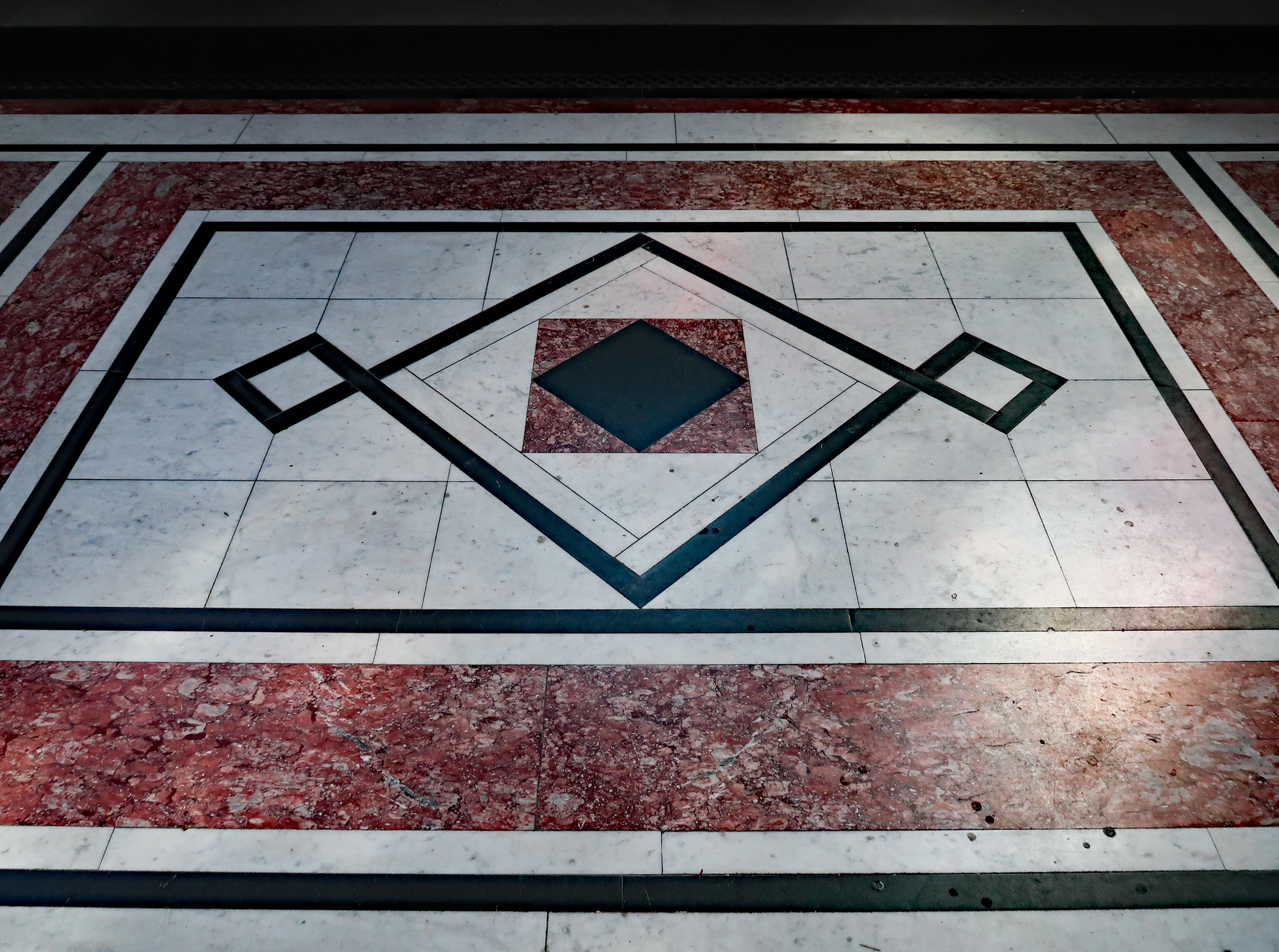

Various decorative stones have been used for flooring in the chancel, choir and south chapel. The white marble is from Carrara in Italy, used together with what looks like Cork Red Marble, an iron stained Carboniferous limestone from Co. Cork in the Republic of Ireland. During the reordering of 1991, the chancel was extended and a different red marble was used for this and for restoration of the south chapel floor.
In many later Victorian churches, polished black Carboniferous limestone was widely used, along with Carrara marble, for chequerboard pattern flooring, with Co. Galway and Co. Kilkenny in the Republic of Ireland and Belgium being major suppliers. These are not easy to distinguish, but one of these has been used as edging and inlays in the chancel floor.
The reredos was also carved by Frank Tory and is made with English alabaster and Caen stone from Normandy in France, which is rarely used in the north of England and was first used after the Norman Conquest in 1066 – with Canterbury Cathedral and the White Tower at the Tower of London being notable examples of its use.
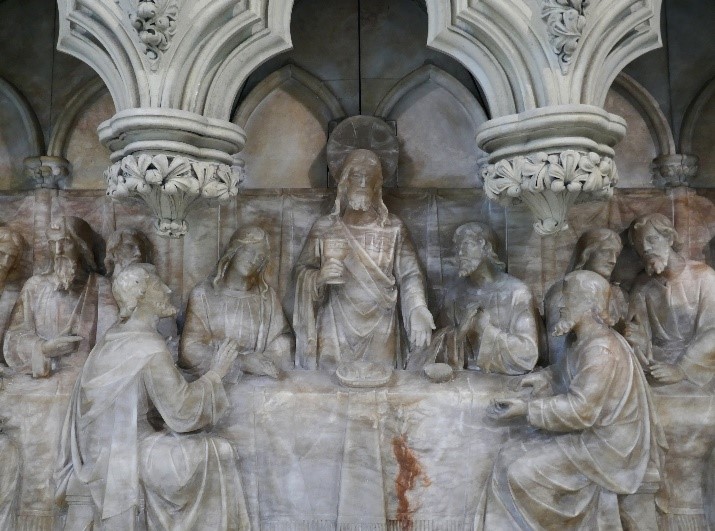
For the columns to the reredos, red marble has also been used along with a green to grey marble, possibly a variety of Connemara Marble from Co. Galway, which was often used in conjunction with Cork Red Marble and Kilkenny limestone by Victorian architects.
The pulpit is made of Caen stone and Ancaster limestone, with columns of red marble similar to that used for the chancel and a polished black limestone, which contain fossils like those found in the Kilkenny limestone, has been used for the moulded band, plinth and steps.
Finally, the font in the baptistery is also made of Caen stone, with columns made from green and reddened varieties of the metamorphic rock serpentinite, which look like those that have long been quarried in the area around Genoa in Italy.
It is fascinating to see how many different areas of the country, and indeed of Europe, have contributed to the beauty of St John’s.
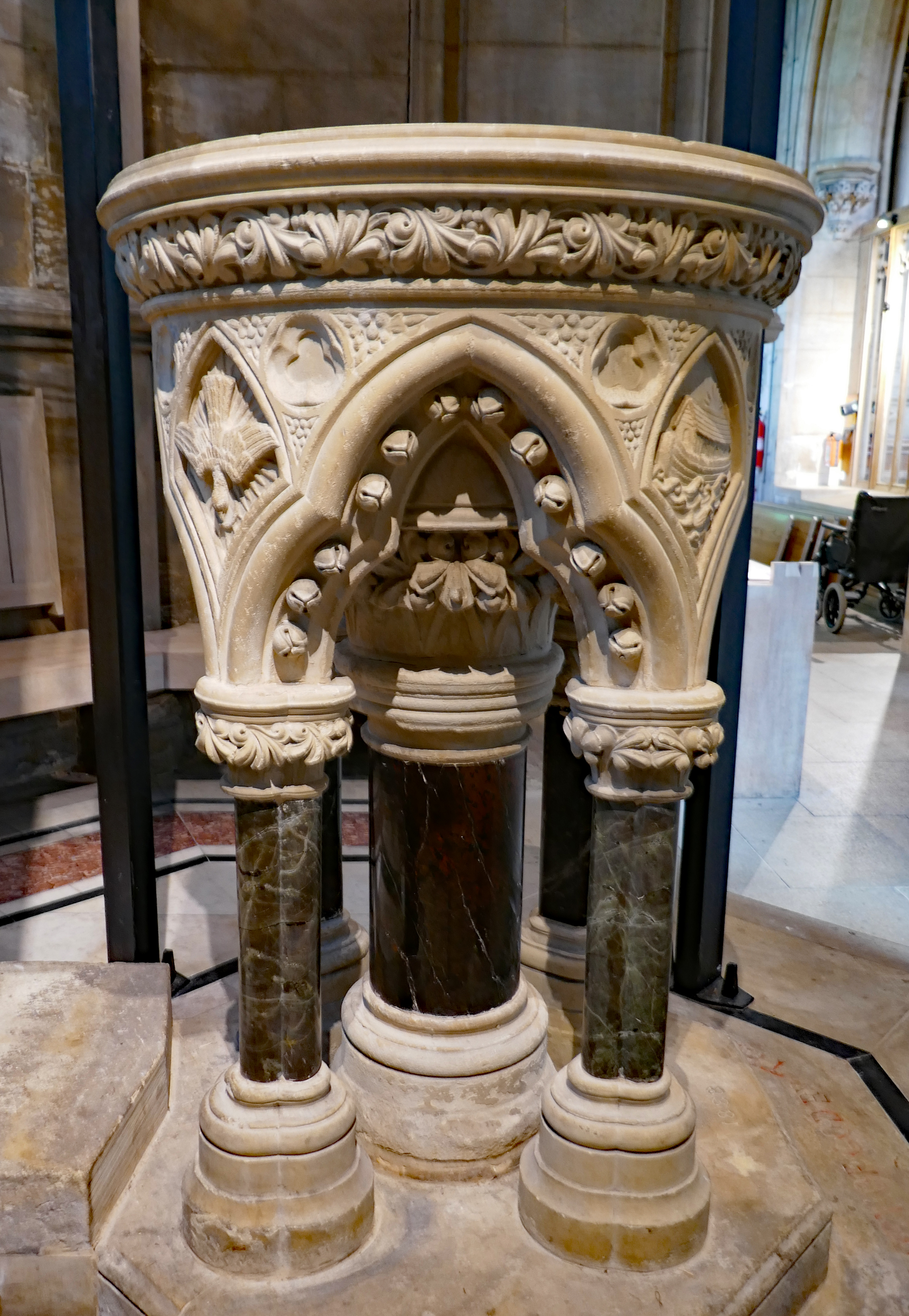
Scott Engering
26 August 2024
Blog 11- ‘Just be careful’: Following the footsteps of the stone masons
23rd July 2024
Download as a PDF
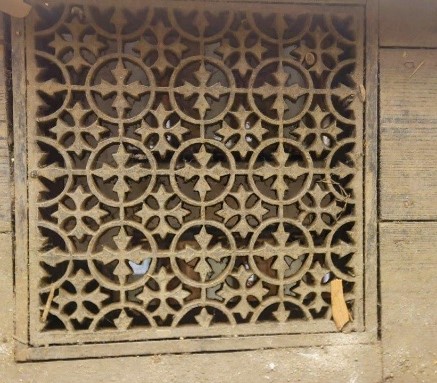
‘Just be careful not to step on the grills’, says Mark Gregory with the confidence of a man who knows what he is doing. Mark is a Church Warden at St John's and part of his job is to look after what you might call the 'back church', the parts that parishioners don't see or even know much about. On Sunday 14 July the part in question is the triforium, a narrow passage high above the nave, and Mark is giving us a tour. The grills he warns us about are metal, square, punched with a pattern of crosses and circles, set every few feet in the floorboards and letting in light from the nave.
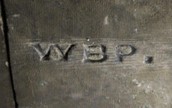
Why are we in the triforium? The answer is that we are researching our talk on Job Stone and the other stone masons who perhaps built St John’s (see below for details). Our usual beat is the Sheffield archives and local studies library. We also spend hours online, scrutinising Ancestry, the British Newspaper Archive and the like. We meet up in cafes a lot, to share our latest discoveries and discuss difficult enquiries. But we are always up for a challenge - in this case, literally up. Mark discovered the initials and symbols left by the stone masons in the triforium and has shared his photographs with us. We want to see the marks for ourselves. We want to examine them for details photographs just don’t show – for example, how deeply the marks are incised into the stone. We want to get a sense of how and where the stone masons worked.
The triforium, we learn, is a passage between the lower and upper nave of a church and bounded by windows overlooking the lower nave. It is built over the side aisles, helping to support the structure of the church. The nave includes the central area where the congregation assembles, and just under the roof, the clerestory with its set of windows. The triforium is sometimes wide - a gallery from where people may view services; or it may be narrow – a walkway used by workmen for access and construction. In St John’s the triforium is narrow, built over the left and right aisles, with a connecting passage above the vestibule and font at the back of the church. It was never meant to be a public space. To reach it, Mark unlocks a small door in the vestibule, revealing a spiral stone staircase. Up and up we go. The triforium is narrow, cramped, low, dusty, with sharp corners. There are lights at intervals, and as we scramble along, we are conscious of the bright nave on the one side, and on the other, a dim crawlspace beyond the triforium, where we glimpse huge beams and stones. It is disorientating. ‘Just be careful not to step on the grills.’
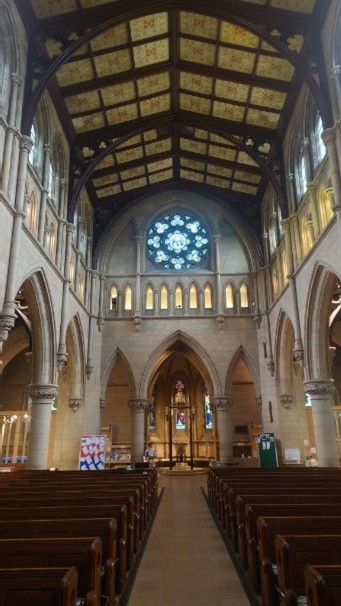
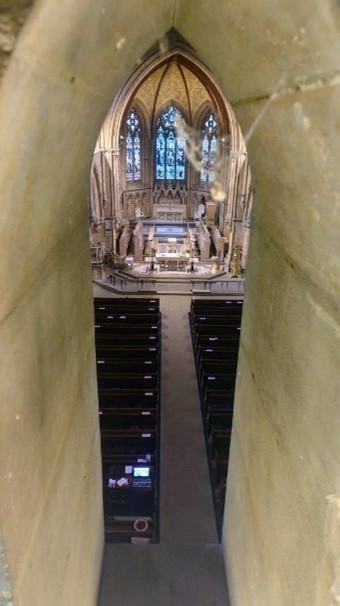

With Mark’s help, we inspect the marks, which are found all along the triforium. Some are clearly modern, like ‘P Leslie’, an electrician who left a neat note of name and job in 1991. Did P Leslie perhaps see the other marks and decide to leave a permanent reminder? Most of the marks are clearly much older. The carvings are black with the ingrained dust of the years. For the most part they are serif capitals, skilfully and deeply incised into the stone. They look solidly Victorian. Some are less skilfully (or more hurriedly?) rendered, but still clear. The symbols – a jug, a flower and two crosses – are delicate and attractive. For all the differences in skill and style, all the marks suggest purpose and determination. The triforium is not a comfortable place. When the church was under construction, it must have been dark and confined, dusty, busy and even dangerous. This is not casual vandalism. For W Thornton, WBP and the others to invest time and effort in leaving their mark, it must have been important to them.

Like most historians, we relish the hunt for answers and are pleased with our progress in identifying the stone masons of St John’s. But in a different sense we now feel we know who these men were. Walking the triforium – scrambling over obstacles, bumping our heads and stumbling more than once - has given us a strong sense of the Victorian stone masons, their craftsmanship, their strength, their will and endurance. These men deserve our admiration.
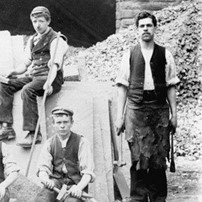
Sue Roe and Val Hewson
22 July 2024
Many thanks to Mark Gregory for his patience and support. The images above were taken by Mark, Sue Roe and Val Hewson.
Val and Sue’s talk, ‘The life of Job Stone and other stone masons of Ranmoor’, will take place in St John’s on Saturday 7 September, at 5.30pm. It is free and part of St John’s contribution to the Heritage Open Days festival.
Blog 10 - The masons in action
This week’s blog will lead you directly to the video of the masons’ marks which Mark Gregory found in the triforium above the south aisle earlier this year. He didn’t stumble on them by accident but suspected that they might be there.
I didn’t expect him to find them because our Church is Victorian. I knew that in Tudor times each ‘banker’ stonemason involved in carving or preparing stone before it was ‘fixed’ would have had his own individual mark. In 1598 the Master of Works for James VI of Scotland decreed that a mason would only to be admitted into the masons’ guild if he had registered his own individual mark. The banker masons would be paid by measure. The individual marks would be tallied with those incised on the stones and determine how much the mason would be paid.
I don’t believe this system of determining pay existed in the nineteenth century so the initials, symbols and names found by Mark were carved for another purpose. Thanks to our choirmen, Brendan Sloan and James Stone the marks found have been filmed and gathered together in a two minute video.
I would very much like your thoughts on the reasons why these masons (most of them in 1888 on the building of the second church) wanted to make their marks in this far away and usually hidden part of the church. If you could help us track down their identities we would welcome your contributions.
I hugely appreciate the help of Mark, Brendan and James in creating this video and look forward to seeing you at the talk about what our researchers, Sue Roe and Val Hewson, have discovered about these unsung and highly skilled craftsmen. Their talk ‘The Life of Job Stone and other stone masons of Ranmoor’ will be given at 5.30 on Saturday 7 September as part of the Heritage Open days. Admission is free.
To see the video please click here.
Blog 9 - Our Spire
Saturday 8th June
Download as a pdf
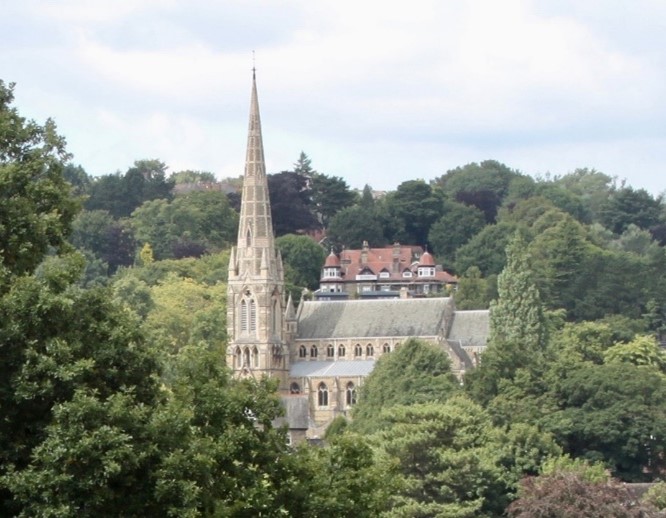
One of the mysteries of our church is that if you are running past it for the 120 bus or striding towards Attilio’s for a mid-day sandwich, it is easy to miss the imposing building altogether. It can seem tucked away from everyday life on a little hillock and surrounded on three sides by trees. Yet, from the hills and valleys on the west of Sheffield, miles or half a mile from the church, it is clearly visible. It rises above the Victorian and Edwardian suburbs and the treelined streets and is, even for those who have nothing to do with the church, a defining component of a landscape which seems unchanging and much-loved.
It is the spire that makes its mark on the city of Sheffield, not the rest of the building. Yet, as we now know, it is the spire that is the building’s greatest weakness.
The only part of the first church to survive the fire of 1888, its survival seems to suggest the spire’s permanence but where fire failed, chemistry succeeded. The fatal combination of limestone and sandstone in the spire meant that over the last 150 years the materials that it is made of have caused it to disintegrate.
Limestone should never be placed above sandstone on the outside of a building. When wet, limestone gradually leaches calcium carbonate. When this seeps into sandstone it gradually crystallises causing the sandstone to burst apart.
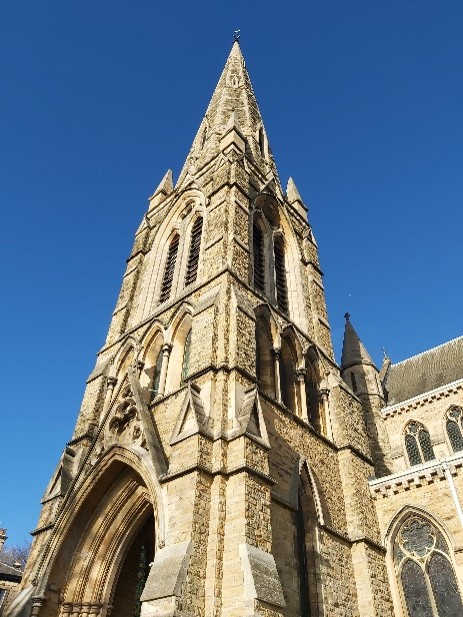 So why did our architect, Edward Mitchel Gibbs, use this combination? It is possible he was following the lead of that great founder of Victorian Early Gothic, George Gilbert Scott. Thirty years earlier , in the 1850s, Gilbert Scott designed what is said to have been his favourite creation: All Souls, Haley Hill in Halifax. Gibbs worked in Leeds and Sheffield and Flockton, who took him into his Sheffield architectural practice, had trained under Gilbert Scott. Was it this chain of influence that inspired many of our church’s early Gothic features: the slender columns, the relatively simply tracery and, above all, the delight in what is sometimes called structural polychromy. This is the use of different coloured stones to emphasise certain structural features in a building. Our spire looks like a copy of Scott’s creation in Halifax which suffered even more disastrously from the mix of limestone and sandstone. The problems faced by the guardians of All Souls were so great that it is no longer a functioning church but preserved, for its beauty, by the Churches Conservation Trust.
So why did our architect, Edward Mitchel Gibbs, use this combination? It is possible he was following the lead of that great founder of Victorian Early Gothic, George Gilbert Scott. Thirty years earlier , in the 1850s, Gilbert Scott designed what is said to have been his favourite creation: All Souls, Haley Hill in Halifax. Gibbs worked in Leeds and Sheffield and Flockton, who took him into his Sheffield architectural practice, had trained under Gilbert Scott. Was it this chain of influence that inspired many of our church’s early Gothic features: the slender columns, the relatively simply tracery and, above all, the delight in what is sometimes called structural polychromy. This is the use of different coloured stones to emphasise certain structural features in a building. Our spire looks like a copy of Scott’s creation in Halifax which suffered even more disastrously from the mix of limestone and sandstone. The problems faced by the guardians of All Souls were so great that it is no longer a functioning church but preserved, for its beauty, by the Churches Conservation Trust.
Yet, when we look up at our spire we can see why the architects of both All Souls and St John’s were seduced by the interlacing of different coloured stone. Limestone is less crumbly than sandstone – more Cheddar than Lancashire. This means that the shapes cut from it can be sharply defined. Looking up at our spire we can see that the whiter blocks of limestone etch the spire’s shape against the sky. In between the network of limestone lies the yellowy infilling of sandstone which lightens the whole effect and gives the construction that sense of lift-off - one of the great thrills of looking upwards at it from close by.
I found a visitor one day, doing just that – standing outside the church, craning his neck to look at the spire beyond the inverted umbrella of scaffolding that now prevents church goers from being struck by lumps of sandstone. He introduced himself as Roderick Hughes. He had himself been a chorister at St John’s in the mid twentieth century. He revealed that he had a close family connection with the spire. His great grandfather had put the cockerel and the weathervane at its topmost point. Roderick, both a musician and an engineer, had come from a family of builders. His ancestor had come from Harrogate to seek work in Sheffield just as the building boom on the west side of Sheffield was gathering pace. It was a source of family pride that his nerve and his skills had contributed to this well-known local landmark.
 I shared Roderick’s family history with a group of children who were waiting patiently while their parents were rehearsing for a concert. The music being sung was in celebration of the man who paid for the spire and first church to be built: John Newton Mappin. While their parents were singing, Sally Booker and I took Sam, Arthur, Iris, Toby and Polly out on to the green in front of church. It was one of the few nearly sunny afternoons this spring. Sally had provided binoculars for us to look at the spire to see if we could find the golden cockerel that should be spinning around in the wind and that Roderick’s relative had placed there.
I shared Roderick’s family history with a group of children who were waiting patiently while their parents were rehearsing for a concert. The music being sung was in celebration of the man who paid for the spire and first church to be built: John Newton Mappin. While their parents were singing, Sally Booker and I took Sam, Arthur, Iris, Toby and Polly out on to the green in front of church. It was one of the few nearly sunny afternoons this spring. Sally had provided binoculars for us to look at the spire to see if we could find the golden cockerel that should be spinning around in the wind and that Roderick’s relative had placed there.
Though there was a light breeze there were no flashes of gold as the cockerel spun round – we hope that in the church’s restoration we will be able to restore his plumage. But we could see the weather vane change position and Gibbs’ creation of white limestone and golden sandstone shone. Against the fast-moving little clouds the whole spire seemed to spin upwards.
I am grateful to Iris for capturing that afternoon when the spire seemed invincible and to Polly for helping us all to look carefully at patterns of white and gold that define and destroy it.
 These first six months of the Scissors Paper Stone project have caused many of us to look more carefully at the building in which we worship. It is my hope that all this looking will help increase our understanding of the way our church was built and can be preserved. The geologist Scott Engering will be talking to us on Saturday July 6th about the nature of the many kinds of stone that Gibbs used to create St John’s. Only such understanding will help us save our church from collapse or from being conserved simply as an empty monument to times past.
These first six months of the Scissors Paper Stone project have caused many of us to look more carefully at the building in which we worship. It is my hope that all this looking will help increase our understanding of the way our church was built and can be preserved. The geologist Scott Engering will be talking to us on Saturday July 6th about the nature of the many kinds of stone that Gibbs used to create St John’s. Only such understanding will help us save our church from collapse or from being conserved simply as an empty monument to times past.
Mary Grover
6 June 2024
Blog 8 - Who Was John Newton Mappin?
Part 3
Tuesday 21st May
Download as a pdf
In my final blog I want to show how John Newton Mappin’s generosity in life - towards the church and in civic philanthropy - continued after his death, and permanently altered the cultural landscape of Sheffield. But first, how did Mappin accrue the wealth to fund his benevolence? We know that by 1837, when he was 34, Mappin described himself as a ‘common brewer’. After his death in 1883 his Rotherham and Doncaster breweries were said to be producing around 100 quarters of malt. Dave Pickersgill of Sheffield CAMRA has kindly clarified what this implies - he says that according to this figure Mappin was producing around 115,200 pints a week. This supplied the 30-odd pubs he owned and leased, and perhaps others too. It was evidently a thriving concern.
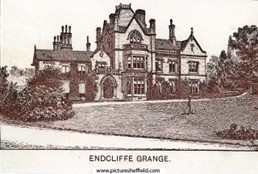
Endlcliffe Grange - With permission of Picture Sheffield
As well as amassing a probably substantial income from his brewery Mappin was a huge promoter of the railways, from north to south, east to west, from early in his working life. He was, for example, Director of the Manchester Sheffield and Midland Railway company, and others, was active on the committees for the Direct Western Railway, and many others, and had lucrative shares in many other booming railway enterprises. Presumably, he saw that the railways were necessary for moving the goods, livestock and people that were essential for his and other businesses, and invested in them. He also had at some points in his career stocks and shares in the Sheffield United Gas Light Company, the Sheffield and Hallamshire Bank, Sheffield General Cemetery, Crystal Palace Company, Joseph Rodgers and Son Ltd, one of the most eminent Sheffield cutlery companies, Newton, Chambers and Co Ltd, iron founders, and Tickhill Gas Light Coal and Coke Co. Ltd. The fruits of canny investment must have made up a substantial proportion of his wealth.
I will now look at Mappin’s will, which is revealing - of his lifestyle, his priorities, even his affections. As a document which details the possessions of a man of his class it is telling - here are his musical instruments and his Erard pianoforte, from the London workshop of the piano maker to her Majesty Queen Victoria. You can see an advertisement for an Erard piano in the 11 October 1873 edition of the ‘Sheffield Daily Telegraph’ on sale at Stacey's Pianoforte shop in the High Street. Also, his books and bookcases, his horse, his landau, his silverware, his wines, his armour, sculptures, bronzes, statues and objets de vertu, watercolours, drawings and engravings, hot house plants, jewels and trinkets etc. and much else are mentioned and disposed of.
Most people towards the end of the nineteenth century died leaving nothing, or debt; Mappin was one of the minority who amassed a fortune and left a will. Compared with his neighbours, most of whom were connected with steel and metal manufacturing, his fortune was relatively modest - only about £10 million at today’s values. Edward Vickers, for example, who built Tapton Hall left about £22 million in today’s values, and Thomas Jessop of Endcliffe Grange left about £88 million in today’s values.
Unlike most such families Mappin had no children. But his affections and loyalties are evident behind the dry words of the will. He left his wealth to a cutler friend, his nephews and their families, nieces, his Lady Housekeeper (so long as she did not marry), trusted servants and faithful employees, and the vicar at St John’s (so long as he performed his duties to the satisfaction of the will’s trustees). He left £1000 each (about £120,000 in today’s values) to Sheffield General Infirmary, the Sheffield Public Hospital and Dispensary, the Boys Charity School (or Bluecoat School) in Sheffield, the Orphanage (or Cherrytree) at Totley near Sheffield, the Rotherham Public Hospital and Dispensary, and the Scripture Readers Society in Sheffield.
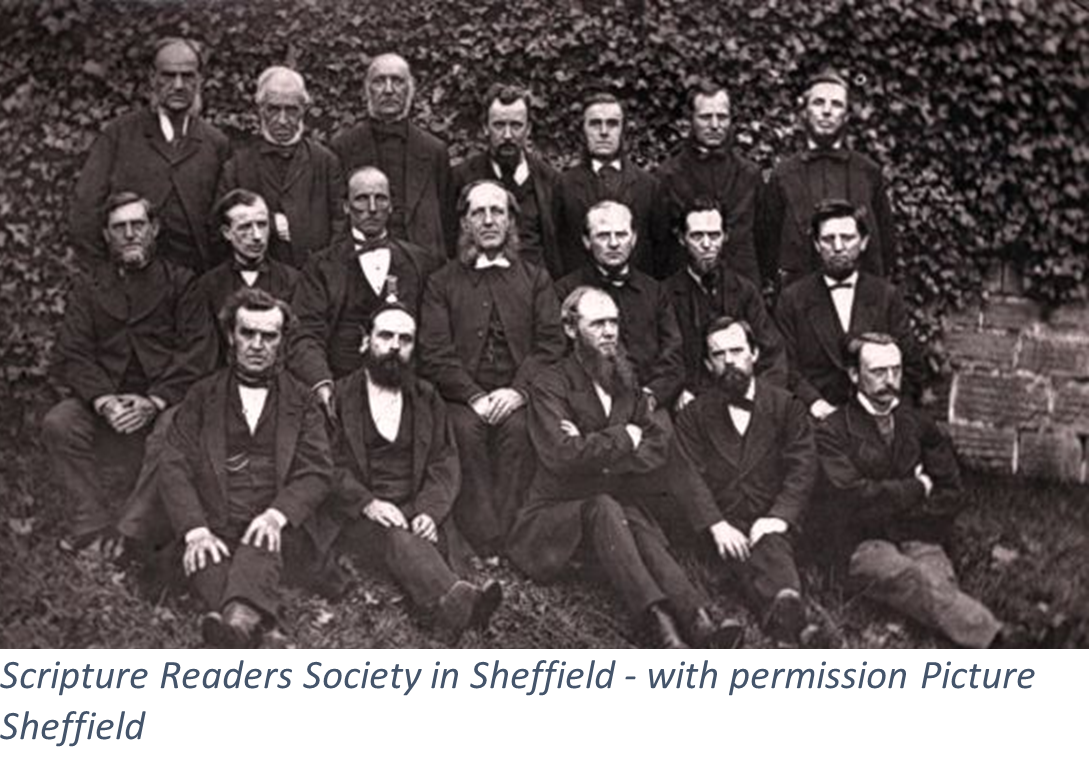
But then comes the extraordinary bequest of Mappin’s collection of 153 paintings to the city of Sheffield and of £15,000 (around £1,750,000) to build a gallery to house them, ‘in perpetuity and without any charge’.
Why did Mappin collect art? Within the highly status conscious Victorian society collecting art was an activity which allowed wealthy business men, such as Mappin, to establish themselves as a middle class elite. Mappin’s art collection was well known before he died and he loaned pictures to the Sheffield School of Art’s annual Conversazione, and to galleries elsewhere. He bought many paintings from the Royal Academy summer shows and from artists’ studios to make his collection. Collecting and showing pictures were markers of a particular social identity in Sheffield, just as in London.
However, there are also more personal reasons why Mappin might have collected paintings. A press report about the opening of the Mappin Art Gallery in July 1887 comments that he liked to get up between 4 and 5 a.m. as a younger man to paint in his leisure time. The same report suggests that his work as an engraver with his father taught him his appreciation for art. He certainly lived close to his collection - at his home Birchlands there were 42 pictures in the drawing room, 51 in the picture gallery, 18 in the dining room, and 23 in the breakfast room, with a few more unaccounted for.
The speech givers at the opening of the Mappin Art Gallery in July 1887 suggest a further motive for his art collecting and his magnanimous gesture of a gallery to house his pictures for the town of Sheffield.
Their view was that the collection was a thing of beauty, that the gallery was an engine of social good, and its donation to the town was to improve the lives of Sheffield’s working people. Also, that following Mappin, other public spirited entrepreneurs who made their money through the activities of the populace, should plough it back into the city they helped to build.
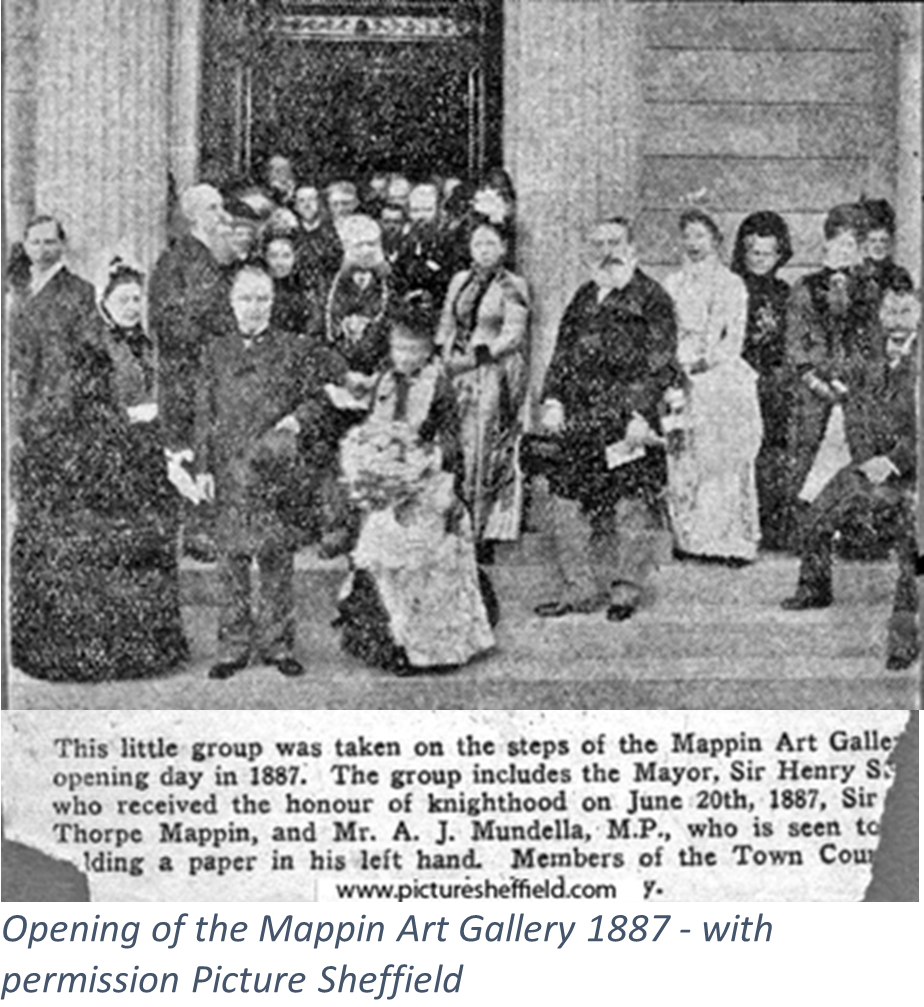
John Newton Mappin’s name is no longer much remembered, but his generous legacy can be traced in the ongoing spiritual and cultural life of the city.
Loveday Herridge
20 May 2024
Blog 7 - Who Was John Newton Mappin?
Part 2
Tuesday 8th May
Download as a PDF
First, the few personal details we know about Mappin. He was the youngest of 5 children of Joseph Mappin and his wife Hannah Newton. Joseph’s father had been a plater and cup maker, and Joseph continued in the family business, becoming a Freeman of Sheffield’s Company of Cutlers in 1787. By 1800 Joseph was an engraver and copper plate printer, and also made pearl buttons, spoons, and dessert knife handles using lustrous mother of pearl. He died of consumption in 1841, and at his funeral was said to have been ‘a man of strict integrity of conduct and kind and gentle manners’.
John Newton Mappin’s life is something of an enigma. Even his birth date is often mistaken - perhaps because throughout the nineteenth century there is a proliferation of Mappin brothers and nephews in changing business partnerships with similar names and close birthdates and a tendency to feud. But also perhaps the variations occur because he himself suppressed knowledge of it. The censuses from 1841 to his death, which give his age, imply a bewildering array of birthdates.
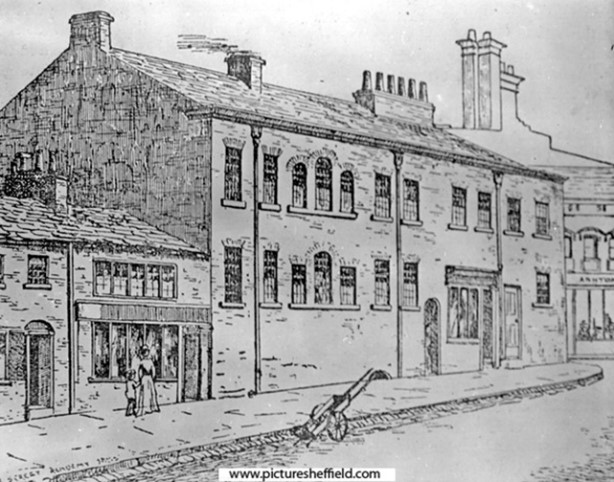 But the birth and baptism registers of the Howard Street Independent Church give his birthdate as 13 February 1803. He was educated at Sheffield’s prestigious and progressive Milk Street Academy, where its Quaker principal, J H Abraham, advertised a curriculum which included English Language, penmanship, arithmetic, merchants’ accounts, geography with the use of globes, French and drawing. A member of the Sheffield Literary and Philosophical Society, Abraham was among the first teachers in England to integrate modern science instruction into the curriculum. Luckily for his students, in his introduction to a book of boys’ and girls’ prize winning essays from the school, published in 1805, Abraham advocated offering pupils kindness and encouragement as a means to successful learning. The family names of the published students are those of Sheffield’s leading manufacturing and professional families, and their younger siblings would have been Mappin’s contemporaries at the school - for example, Thomas Jessop, later a great steel maker and philanthropist.
But the birth and baptism registers of the Howard Street Independent Church give his birthdate as 13 February 1803. He was educated at Sheffield’s prestigious and progressive Milk Street Academy, where its Quaker principal, J H Abraham, advertised a curriculum which included English Language, penmanship, arithmetic, merchants’ accounts, geography with the use of globes, French and drawing. A member of the Sheffield Literary and Philosophical Society, Abraham was among the first teachers in England to integrate modern science instruction into the curriculum. Luckily for his students, in his introduction to a book of boys’ and girls’ prize winning essays from the school, published in 1805, Abraham advocated offering pupils kindness and encouragement as a means to successful learning. The family names of the published students are those of Sheffield’s leading manufacturing and professional families, and their younger siblings would have been Mappin’s contemporaries at the school - for example, Thomas Jessop, later a great steel maker and philanthropist.
There is evidence that John Newton Mappin initially worked with his father and older brother as a pearl button maker at J Mappin and Son, up to at least 1838. However, by this time it also appears he had decided to take a different path from the rest of his metal working family. By 1837, as a ‘common brewer’ and with his business partner William Bradley, a ‘coach proprietor’, he was lessee of the Old Three Pigeons beerhouse, in Carver Street, Sheffield. Together they built the Soho Brewery on Ecclesall Road. By 1846 Mappin had dissolved his partnership with William Bradley, and was ready to take the step that would propel him into wealth and gentlemanly gravitas. He took the lease of the Masboro Old Brewery, Rotherham, and, through business acumen and energy, developed a successful brewery. As the 19th century progressed, developments in brewing encouraged, and were encouraged by, the application of science. Maybe Mappin’s early exposure to science lessons at school encouraged his interest in the complex process of beer making.
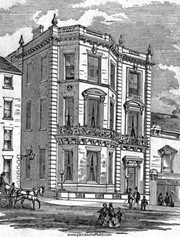 In a society where wealth was highly valued, brewing was one of the most lucrative of all the trades, but there was some ambivalence in Sheffield about the morality of the consumption of alcohol, which may have had an impact on Mappin. Around 1832 when he was 29 and not yet married (at 45 he married Mary Briddon, of Manchester), he seems to have adopted his infant nephews John Yeomans Cowlishaw and Joseph Cowlishaw whose parents had died (their mother was Mappin’s sister). Later, after Mappin had become an established brewer, it seems that the boys may have been placed in the custody of their aunt, Elizabeth Mappin, Mappin’s second sister. She, it is said, believed the boys were ill served being associated with the brewing industry.
In a society where wealth was highly valued, brewing was one of the most lucrative of all the trades, but there was some ambivalence in Sheffield about the morality of the consumption of alcohol, which may have had an impact on Mappin. Around 1832 when he was 29 and not yet married (at 45 he married Mary Briddon, of Manchester), he seems to have adopted his infant nephews John Yeomans Cowlishaw and Joseph Cowlishaw whose parents had died (their mother was Mappin’s sister). Later, after Mappin had become an established brewer, it seems that the boys may have been placed in the custody of their aunt, Elizabeth Mappin, Mappin’s second sister. She, it is said, believed the boys were ill served being associated with the brewing industry.
As well as raising the question of whether the relationship between Mappin and his sister was harmonious, her belief implies that the brewing trade might have been denigrated in parts of Sheffield society. Did Mappin feel he needed to compensate - perhaps through charitable giving - for his association with brewing? The Temperance Movement’s campaign against the evils of alcohol began in earnest in Sheffield in the 1830s. In fact, Mappin took no part in Sheffield’s temperance struggles, though he was Vice-Chairman of the Licensed Victuallers Protection and Benevolent Society, which aimed to provide a home in Sheffield for ‘decayed licensed Victualers, their widows and orphans’. At the 1846 victuallers’ annual Festival a speech-giver remarked that ‘time was when a licensed victualler was shut out from society as a man who dealt in poison and lived by drunkenness and debauchery’, but that this was not the case now. Was Mappin (who did not speak at the Festival) tainted by this reputation? Perhaps in some quarters, but it is difficult to believe he was not a generous man.
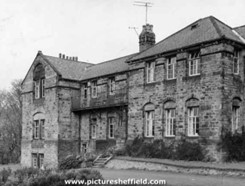
Cherrytree Orphanage - with permission Picture Sheffield
I described in my previous blog how Mappin was a benefactor to the church. But he was generous in many ways, and his status must have risen accordingly. For example, he was a subscriber to the ‘Sheffield Central Relief Committee for the general distress of the town’ which was formed to alleviate poverty. He also subscribed to the Sheffield Fund for the Relief of the Lancashire Distress, for those suffering during the depression in the textile industry in the north west in the 1860s. In 1866 he joined a committee to collect subscriptions - giving £100 himself (about £11,000 at today’s values) - for the bereaved families of Oaks Colliery in Barnsley, after explosions there killed 361 miners and rescuers. He gave an annuity to the Deakin Institute of £20 (about £2,200) for the relief of the poor. In a reminder of his generosity to his infant Cowlishaw nephews, he supported the Cherrytree Orphanage in Totley. He gave to the Public Dispensary and the General Infirmary, and was President and Vice-President of the Sheffield Public Hospital and Dispensary in 1861-71.
As a loyal wealthy Sheffield business man, keen to make Sheffield a memorable destination for the 1875 visit of the Prince and Princess of Wales, he contributed £250 (about £28,000) for the expenses associated with it. ARCHES He was chair of a reception committee, which erected triumphal arches on the route of the royal procession along Fulwood Road, quite close to the entrance to his house ‘Birchlands’ (demolished to make way for the Hallam Towers Hotel).
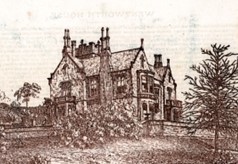 In a rare foray into public affairs he stood in 1856 as a Guardian for Ecclesall Bierlow, part of the arrangements for welfare under the Poor Law, but was not elected. He was a member of the Sheffield Club, one of the social institutions to which Sheffield gentlemen of influence and standing belonged. Here they could ‘meet on common ground for an exchange of opinion on subjects of common interest’, in its club house in the centre of town, which was said to mirror the comforts of the London Athenaeum or Reform Club. There were good opportunities for networking at the Club - in 1868 there were 8 substantial brewers among a total of around 200 members, who were ‘merchants and manufacturers’ and also professional men, such as solicitors. From the Club’s records we know that Mappin voted for the Liberal Party in 1841 and Tory thereafter.
In a rare foray into public affairs he stood in 1856 as a Guardian for Ecclesall Bierlow, part of the arrangements for welfare under the Poor Law, but was not elected. He was a member of the Sheffield Club, one of the social institutions to which Sheffield gentlemen of influence and standing belonged. Here they could ‘meet on common ground for an exchange of opinion on subjects of common interest’, in its club house in the centre of town, which was said to mirror the comforts of the London Athenaeum or Reform Club. There were good opportunities for networking at the Club - in 1868 there were 8 substantial brewers among a total of around 200 members, who were ‘merchants and manufacturers’ and also professional men, such as solicitors. From the Club’s records we know that Mappin voted for the Liberal Party in 1841 and Tory thereafter.
For my final blog I can report a little more about this shadowy character. Perhaps more than any other details, the choices and preferences of his Will tell us something about his personality. Next time, I’ll look at this, how he came by his wealth, and his remarkable generosity in disposing of his art collection.
Loveday Herridge
6 May 2024
Blog 6: Who Was John Newton Mappin?
Monday 29th April
Download blog as a PDF
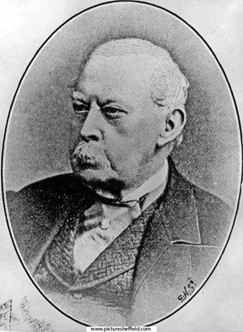
Who was John Newton Mappin, who donated £14,000 for the building of St John’s? A Google search for the Mappin name lists various Sheffield University buildings and Mappin Street in the centre of the town. These places are named to honour the philanthropy of Frederick Thorpe Mappin, John Newton’s nephew, who was a steelworks owner, local politician and later MP for Hallamshire. Mappin & Webb, the luxury silverware company, is also listed, an internationally known success story of Sheffield and London. This enterprise is the culmination of the complex business activities of various members of the Mappin family - but not of John Newton Mappin, who did begin his working life in the metalworking trade of his father, but later became a brewer. There is also a Google Tripadvisor entry for the Mappin Art Gallery, which dismally, and misleadingly, states that the location is permanently closed.
John Newton Mappin has slipped from modern view, but in his time he was described as one of Sheffield’s ‘best known’ men. As previous blogs have made clear, highly skilled craftsmen in the building trades created St John’s, and the cutler James William Harrison provided the land on which to build it. In this and two later blogs I’ll investigate the shadowy benefactor, John Newton Mappin, who gave around £14,000 or £1.5 million (in today’s values) so that the church could be built.
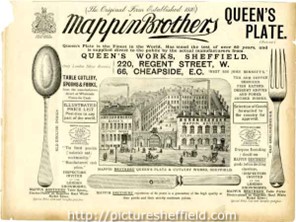
The building project was part of the Vicar of Sheffield’s Scheme of Church Extension of around 1877 to build an additional nine churches in Sheffield in five years. At a meeting reported in the Sheffield Independent of January 1877 the Archbishop of York said of Mappin that (he) ‘is a very practical person and almost as soon as I heard he was going to build this church he made his appearance with a roll of plans under his arm’. Whether or not Mappin intervened graciously in the work of E. M. Gibbs, St John’s architect, the building work progressed quickly. By May 1878 Mappin had held a ‘rearing dinner’ for the 100-strong workforce to celebrate the completion of the outer walls and roof (as reported in Mary Grover’s blog of 15 January 2024).
At the opening of St John’s in April 1879 at which Mappin was present, it was said that, ‘Much thought and care and anxiety have gone along with the gift ... every power of the giver was employed in it. His liberal hand, his thinking head, his daily watchful mind, have altogether brought this house to its completeness’. And after Mappin had died, at the laying of the foundation stone in 1887 for the new St John’s after the old one had been destroyed by fire, Archdeacon Blakeney said that his ‘great desire was to glorify god and do what was right in his day and generation’. Blakeney said he believed ‘that Mappin never did anything that gave him greater satisfaction than the building of the church’.
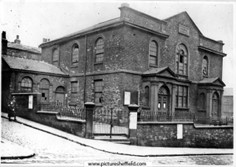
Mappin’s reputation as a good churchman is frequently mentioned in newspaper reports, and one of them says that he ‘wanted an evangelical not a ritualistic clergyman’ for St John’s. His interest in the evangelical may have come from early experiences at the Howard Street Independent Congregationalist Church, where his birthdate of 13 February 1803 is recorded, and where he was baptised, and from Mount Zion Chapel, where his nephew Frederick Thorpe Mappin maintained he 'had an association’ in his early years.
John Newton Mappin was a generous church benefactor in other ways. He was Churchwarden at the Parish Church 1854-58, now the Cathedral, a role which required both religious commitment and responsibility in practical matters and for keeping accounts. In 1857 he paid for the large stained glass window behind the high altar there, the first in coloured glass in the church. Alterations to the chancel required the old one, which was not coloured, and which he had also paid for, to be replaced. This was dedicated to James Montgomery who was much mourned at his death in 1854 as Sheffield’s renowned hymn writer and social reformer. It’s possible that Mappin knew Montgomery through mutual philanthropic interests. The window shows, as well as St Matthew, Moses, David, and St John, Mappin’s coat of arms, and the crest and motto of the Mappin family, together with the words ‘The gift of John Newton Mappin, churchwarden, 1857’. It was reported that Mappin, as ever a hands-on benefactor, ‘being anxious to secure first-rate talent, invited several artists in stained glass, six of whom sent in designs. Mr Mappin consulted some friends and selected Thomas Baillie and Co. of Wardour Street, London', a prominent company which had exhibited at the Great Exhibition in 1851.
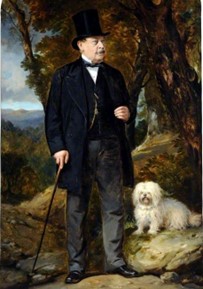
Mappin was also involved with the building of St Luke’s Church, more often called the Sale Memorial Church, in memory of Dr Sale, Vicar of Sheffield, who died in 1873. A meeting to organise this was held at the Cutlers Hall with many eminent gentlemen and churchmen attending. Mappin is mentioned in a newspaper report as a member of this committee, and as is so often the case in press accounts of his philanthropy, at the end of the report is a list of wealthy subscribers, a roll call of Sheffield’s eminent family names, with his name at the top of it, contributing £500 (about £52,500 at present values).
League tables of charitable giving like these appeared frequently in the press. They made it possible for readers to assess the relative wealth, piety and respectability of the subscribers who were listed in such detail. These characteristics were cherished by the Victorians, and helped secure the giver’s social status, ensuring that they were ‘well known’.
In my next two posts I’ll look at Mappin’s other acts of civic generosity and his work as a brewer, and make the case that he should be remembered for his role in the development of Sheffield’s cultural life.
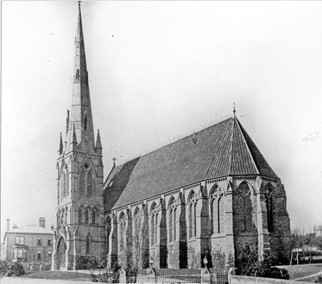
Loveday Herridge
22 April
2024
Blog 5 - Monday 25th March 2024
Where they sat: Cutler James William Harrison and his fellow metal manufacturers

Harrison Brothers & Howson, Sheffield marks entered c. 1849
The spire of St John’s can be seen across the Porter Valley and beyond. The two men who caused it to be built may have lived in mansions on the grandest of Sheffield’s arterial roads and altered the landscape of Ranmoor, but neither seems to have had much swagger about him.
Next month, on Saturday April 13th, Loveday Herridge will share her findings about the man who funded the church itself: the brewer John Newton Mappin. This week I would like to introduce the rather self-effacing but hugely enterprising cutler who gave the land on which the church was to be built: James William Harrison.
Harrison built his Ranmoor mansion, Tapton Grange, in 1867. Demolished in 1970, it stood on the hill behind the church, between the church and Moordale, now the Florentine Inn. Harrison was not only the donor of the church site, he was also one of many metal manufacturers whose money ensured the survival of the church community in the latter half of the nineteenth century.
Both Mappin and Harrison were childless. It is possible their huge generosity, both to the church and more widely, throughout the city, may have been influenced by this. Unlike Mappin, Harrison seems professionally, and possibly socially, to have been an insider. The houses around him belonged to cutlers and metal manufacturers like himself. Indeed, William Howson, the founder of the firm Harrison and Howson, built Tapton Park on the other side of Ranmoor Park Road from Tapton Grange. Both Harrison and William Howson’s son, George, were stalwarts of St John’s.
Thanks to a list of ‘Pew Rents 1889/91’ in the Ranmoor Society Archives it is clear that Ranmoor’s first vicars would not have been able to survive from day to day without the annual giving of local industrialists who had made their fortunes from the metal industries.
Covering church or chapel expenses by levying pew rents was a source of controversy throughout the nineteenth century. Once the creation of different church denominations had picked up pace in the eighteenth century, the imposition of church rates on local communities was understandably resisted by those who were not Anglicans. Another way had to be found to pay the stipend of a priest or minister. For many Anglicans, and some non-conformists, the way forward seemed to be to ‘rent’ pews to those who could afford to pay.
In 1879 one ‘sitting’ in the first church of St John’s cost £1 10s (a week’s wages for a skilled stonemason). 400 of this church’s 563 sittings were let, raising an annual £600 - an enormous sum.
The second church of 1888 attracted 118 parishioners who paid pew rents. These payments ensured that subscribers had a numbered pew for a designated number of family members and dependents. These numbers can still be found on our pew ends, including the one, halfway down the nave aisle for the church warden (there is also a handsome brass retainer for the warden’s staff).
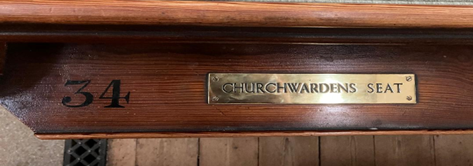
The names of many of these pew subscribers are still well known: for example the Edgar Allens of Clevedon House, the Binghams of West Lea, the Colvers (until 1882 of Rockmount in Fulwood Road), the Firths of Oakbrook, the Flathers of Endcliffe Vale Road, the Hadfields of Fairfield in Fulwood Road, and the Laycocks of Ranmoor Grange in Fulwood Road. Next year when I explore the social composition of Ranmoor Parish I will try to understand more about the ways these families’ social and church connections shaped the life of the church, the community of Ranmoor and had bearing on the interests of these industrialists and the wider community. The coming together on a Sunday (if indeed these families turned up to occupy the pews they rented) must have helped shape the social networks which in every age impinge on wealth creation and political influence.
The practice of erecting private pews which was in fact illegal dated from before the Reformation but gathered pace in the nineteenth century. Pews could be sublet or bequeathed. E R Wickham, in his superb history Church and People in an Industrial City demonstrates how much damage this system did to the way the Church of England was regarded in an industrial city like Sheffield where there was a strong egalitarian tradition.
Throughout the nineteenth century it was persuasively argued from within the Church of England that the system of pew rentals was deeply divisive and at odds with Christ’s teaching, for example that ‘The last shall be first and the first last’ (Matthew 19. 30). Whereas the wealthy in the parish were gathered at the front of the church, those who could not afford the sizeable cost of a sitting, let alone a pewful of sittings, were directed to the unnumbered pews to the rear and to the side of the main body of the nave. As the Archdeacon of Liverpool put it, in 1857, ‘the free sittings are put in the most uncomfortable positions, where the people feel degraded.’
It is difficult to imagine that our land donor used his status to impose. James William Harrison did not claim a place in the sun, paying for nine sittings in pew number 41 - the total number of pews being 68. By 1889, John Newton Mappin had died so we don’t know where he had been placed in the earlier church. His even wealthier and better-known nephew, Sir Frederick Thorpe Mappin Bart., had two sets of rentals, five sittings in pew 6 and nine in pew 37.
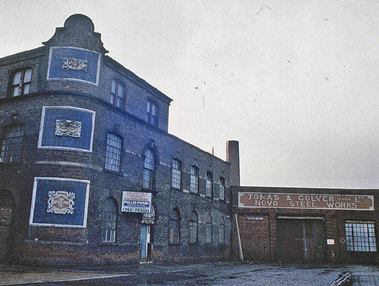
Jonas and Colver Continental and Novo Steel Works
https://www.mikehigginbottominterestingtimes.co.uk/2022/08/12/jonas-colver/
There are only three double bookings recorded. Mrs Patteson from Storth Lane had two sittings in pew 15 and one sitting in pew 40. Robert Colver’s rentals were more in the same order of magnitude as Thorpe Mappin’s.
Robert Colver was a senior partner in Jonas and Colver Steel Works in Attercliffe. Colver was an active member of St John’s and donated much to the church. His family history was a tragic one and the loss of two sons in the First World War moved him to donate commemorative windows in the side chapel.
The double booking of separate pews suggests that both the Colvers and Thorpe Mappins placed family grandees at the front whereas other dependents and employees would be in the rear pews. These senior servants therefore had opportunities for creating other, parallel, social networks.
I am grateful to Dan Eaton who pointed out that the sequence of heads above the nave pillars enact a similarly hierarchical view of society as that reflected in the seating of our nineteenth century congregation, with angels at the east end, followed by royal persons, then wealthy commoners as we move west. At the west end itself we find a motley crew of grotesques, a random king and mortals of an apparently lowly sort. Any suggestions of the organising principle here would be most welcome.
I would like to end this introduction to the industrialist donors with an extract from the obituary of James William Harrison. His life has many parallels with other contemporaries who became wealthy industrialists: the fact that he started his working life as an apprentice, his rootedness in his native city and his generosity to Sheffield’s charitable institutions. Perhaps the most striking difference is his reluctance to take on the prestigious role as Master Cutler.
The Obituary of James William Harrison 1816-1897 in the Sheffield Independent 2 March 1897
He was apprenticed when fourteen years of age to Messrs. Stuart and Smith, stove-grate manufacturers, who earned business at Roscoe Place. Before completing his term of apprenticeship he left and took a position at Messrs. Thomas Sanson and Sons, cutlers to Her Majesty, whose place of business was in Norfolk street. The partners in the firm at that time were Mr. George and Mr. Thomas. Mr. Harrison subsequently became a partner, and in the year 1847 the name of the firm was changed to Harrison Brothers and Howson, and it has been carried under the same style ever since.
The deceased displayed a remarkable business capacity, and his never-ceasing energy and close attention to his duties won for him the success afterwards enjoyed. On one occasion he journeyed to London with Mr. Jobson Smith, and was one of the few men in Sheffield who could say they had travelled to the Metropolis on a stage coach. He retired from the firm in 1875. He was extremely liberal in all charitable and deserving institutions. In recent years he gave the sum of £lOOO towards the building of an additional wing at the Infirmary, and also contributed largely to the erection of Ranmoor Church.
In politics he was Conservative, but he took no active part in the public life of the city. He filled, however, various private offices with dignity, but his quiet, unassuming disposition did not allow him to become a public man in the ordinary acceptation of the term. At one time he was a director of the Water Company, and for a time held a similar position in the firm Messrs. Thomas Jessop and Sons Limited. He was also a member of the Cutlers’ Company for a short period, but when it became his turn to be elected to the honourable office of Master Cutler he preferred to pay the fine, and subsequently left the company. At the time of his death he was director of the Gas Company, one of the Church Burgesses, a trustee of Ranmoor Church, a trustee of the Sheffield Savings Bank, and governor of the Girls’ Chantry School. He never married, and is the last of his family.
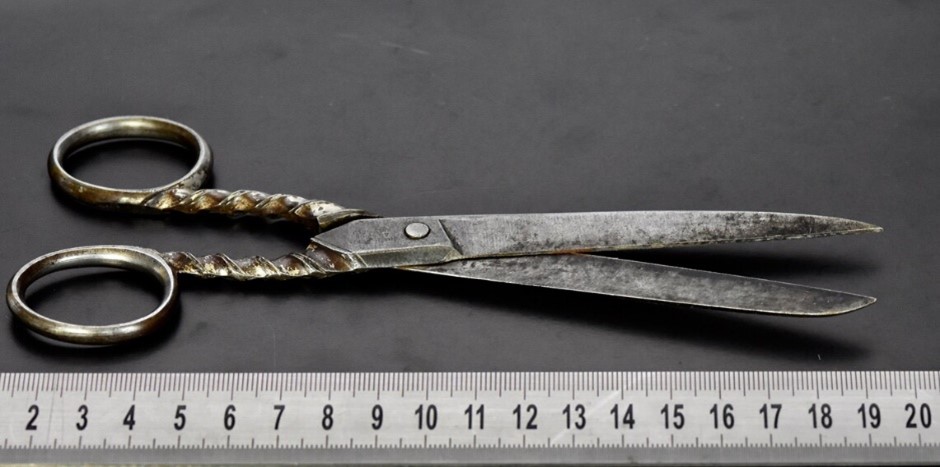
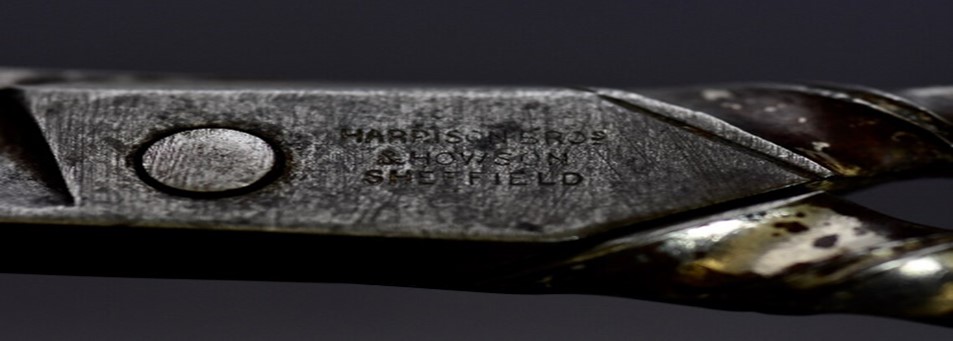
Advertisement from Etsy for a pair of scissors made by Harrison and Howson possibly from the 1900s
Blog 4 - Monday 4th March 2024
A Study in Stone
The stonemasons leaving their mark – usually their initials - on the fabric of St John’s can have had no idea that, almost 150 years later, those marks would be a focus for investigation. This is just the sort of thing local historians – keen sleuths all - love to tackle. Step forward, Sue Roe, Alan Crutch and churchwarden Mark Gregory.
It’s easy enough, as Mary Grover says, to gather information about the people who donate money or land to an undertaking like the building of St John’s. It’s much harder to identify the people who give their strength and skill, for example, cutting, dressing, carving and fixing stone. They are generally forgotten.
Mark Gregory found nine marks left by St John’s stonemason in the triforium, a gallery or passageway high up in the church. He had climbed up for the prosaic task of replacing light bulbs, but he came down bearing riches for Scissors, Paper, Stone. Six sets of initials, two with dates, one name and two symbols, all left by the men (it would have been men in the late 19th century) who put together the stones of St John’s. The two dates, 1888 and 1892, are a few years apart, which may indicate that the masons were not all part of the same crew. For the most part, the marks are serif capitals, carefully incised by men whose experience of carving letters is evident. Only one – W Thornton – had the time or confidence to leave his name in full. Perhaps ‘IW 1892’ had less time, for he wrote in chalk. One mason left, not initials, but a cross and another drew a jug. There is little chance of identifying either. Were they illiterate? Or did they choose to sign their work with symbols, and are those symbols in fact puns? The cross is similar in style to a St John’s (or Maltese) Cross. ‘Jug’ is a synonym for ‘pitcher’, and pitcher is a name for a pitching chisel, which a stonemason uses to trim stone.
You can see all the marks at the bottom of this blog.
How does a historian go about identifying people from so little information? There are no leather-bound ledgers, to list the craftsmen and labourers, carefully preserved by the church authorities or the contractors. The only clues lie in the marks themselves, and the only way to investigate is to match them with the records we do have: census and other official records available through sites like
Ancestry and
Find My Past; and local directories like Kelly’s (think of a Victorian Yellow Pages or the Phonebook). In this case we are very lucky also to have the
‘Friendly Society of Operative Stonemasons of England, Ireland and Wales’, founded in 1833. Its papers, including membership and claims for injury or death, are held at the University of Warwick, which was kind enough to isolate the Sheffield records for us.
The Sheffield Indexers, who transcribe and offer free access to local genealogical records, gave us the opportunity to make lists of local masons and other craftsmen. It can also be useful to check digitised newspapers like the
British Newspaper Archive.*
Identifying the masons is a work in progress. We are pretty sure that we now know who ‘WBP’ was. Working independently, Alan and Sue have uncovered a lot of information:
• William Baildon Palmer was born in Nottingham in around 1862
•
His father was a coachman at
Knowle Manor, a Grade II* listed manor house in Warwickshire
• In 1891 he was living with his wife Harriet at 278 Petre St in Brightside and is described as a stonemason
• He was still in Sheffield working as a stonemason in 1901, but by then he had four children. The family lived at 35 Rushby Road (near where the Northern General now is)
• He died on 3 July 1904 at the age of 42. The cause of death is reported as phthisis, that is, tuberculosis, which was common among stonemasons (unsurprisingly given their working conditions). According to the Operative Stonemasons, his family was entitled to £12 in benefit. His children were all aged under 12 at the time, and were to lose their mother two years later, in 1906.
How historians investigate depends on them. There are many resources online these days, and you can sit comfortably at your desk or curl up on the sofa, searching through census records etc. Satisfyingly quick and comprehensive as online research can be, there is something special about handling original documents at, say,
Sheffield Archives or the Local Studies Library. You wait impatiently for the archivist to retrieve the records and then you turn the fragile pages and peer at the faded ink. Suddenly you find what you are looking for or you make an unexpected connection. Or not.
However they did it, the masons at St John’s wanted to leave a record of their contribution, of their skill and effort. ‘I did this,’ their marks say, ‘I climbed up here and did my job.’ We owe it to them to uncover their identities.
Val Hewson
* Sheffield Libraries offers free access to Find My Past, Ancestry and the British Newspaper Archive.
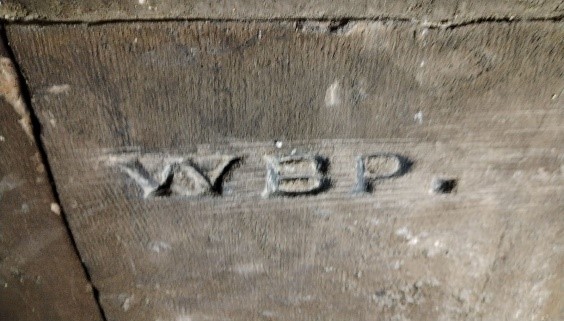
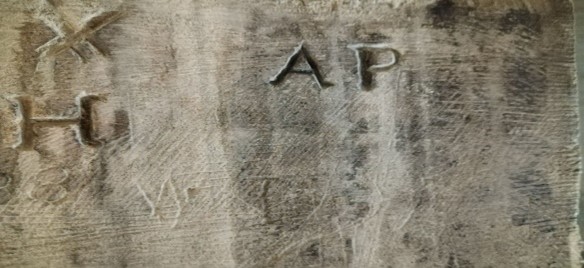
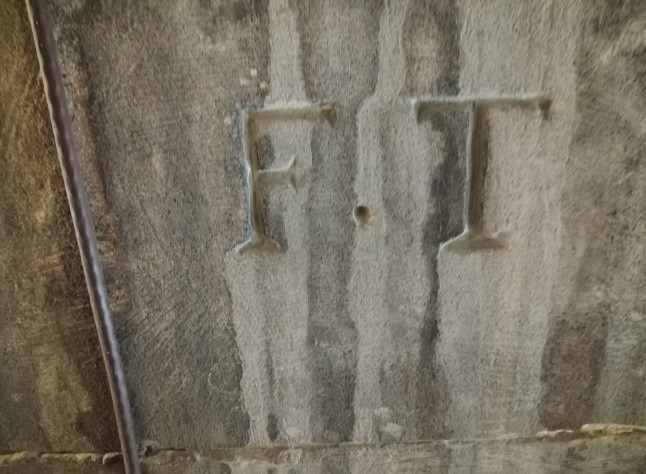
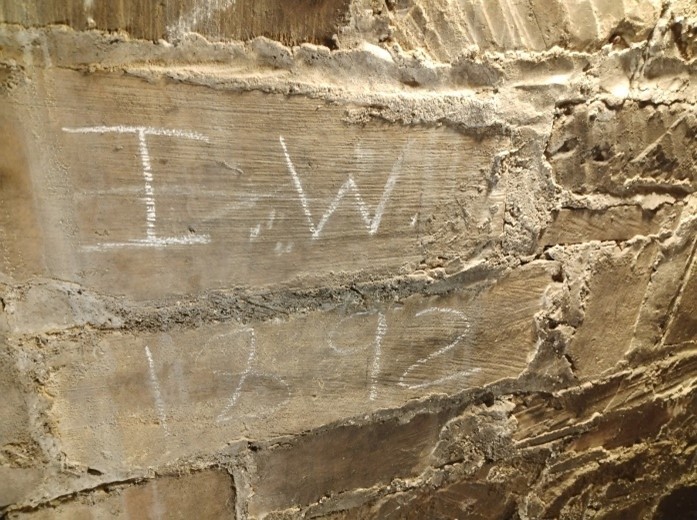

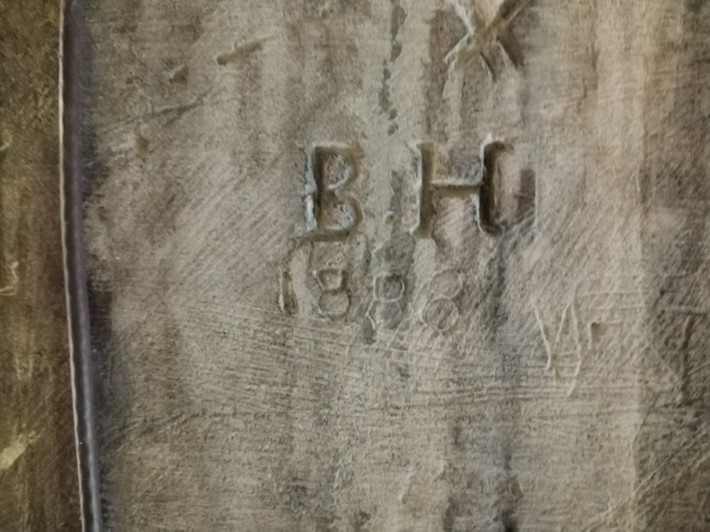
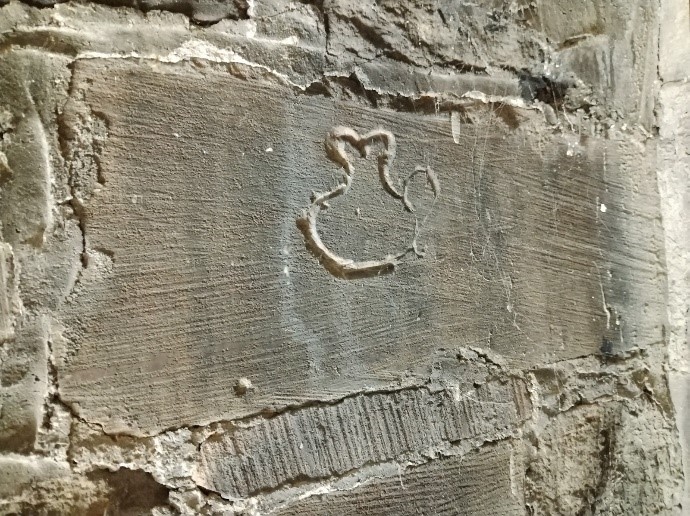
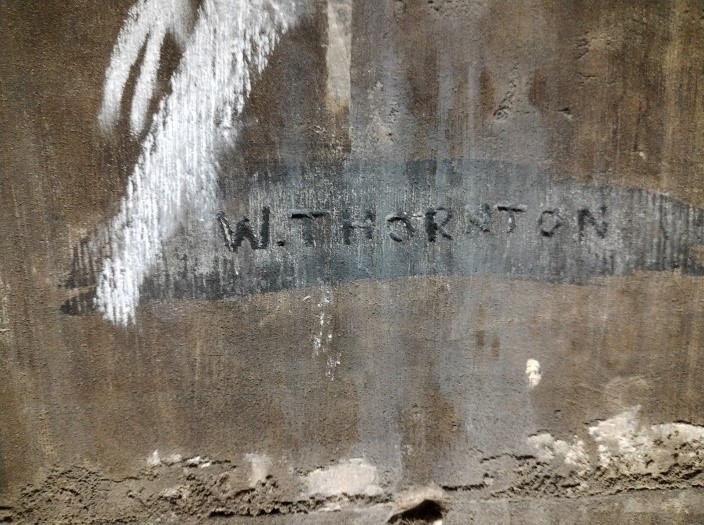
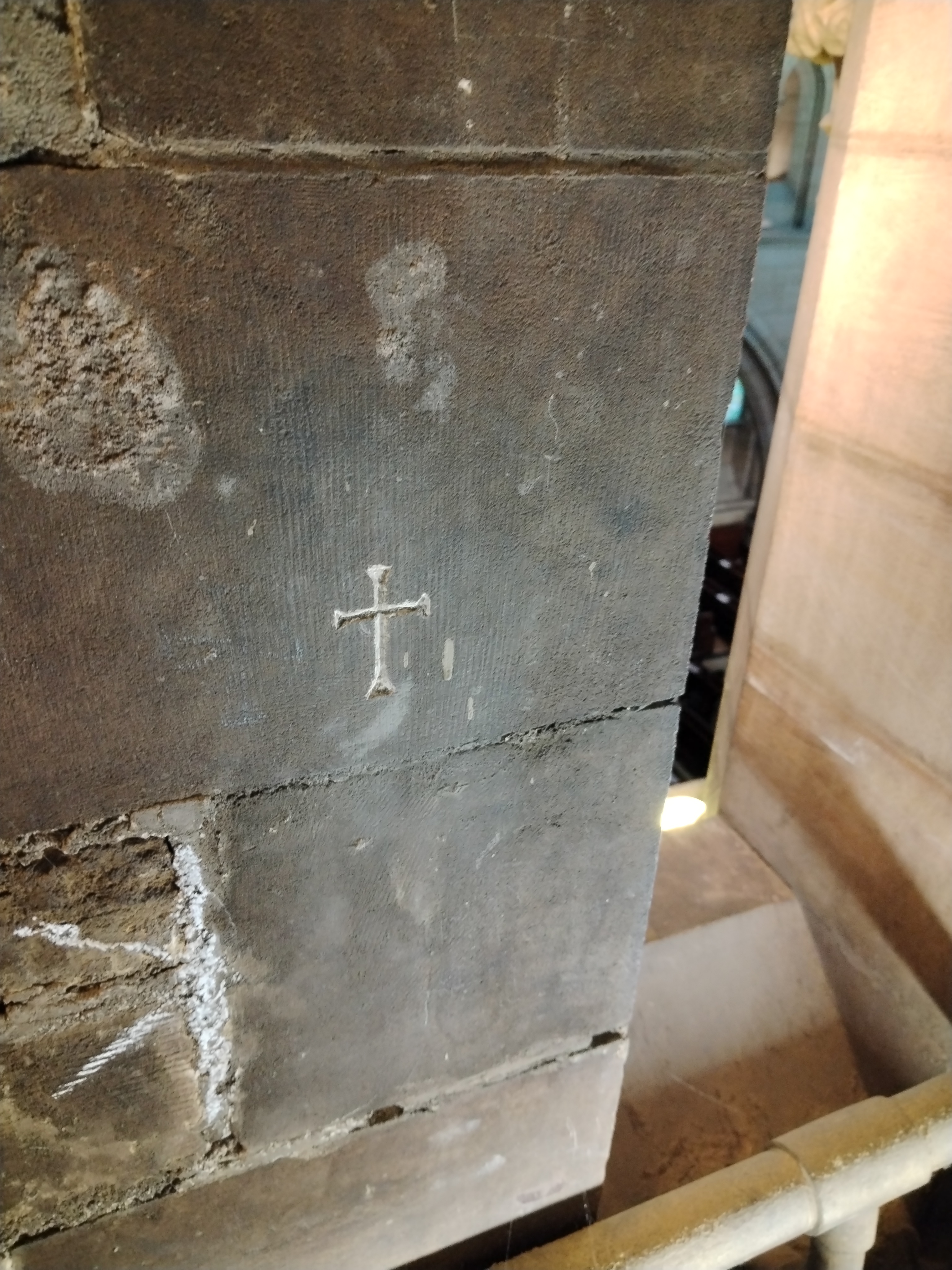 'Images collected by Mark Gregory'
'Images collected by Mark Gregory'
Blog 3 - Monday 19th February 2024
‘The Death of a Successful Stone Mason’:
The life and death of Job Stone 1840-1885
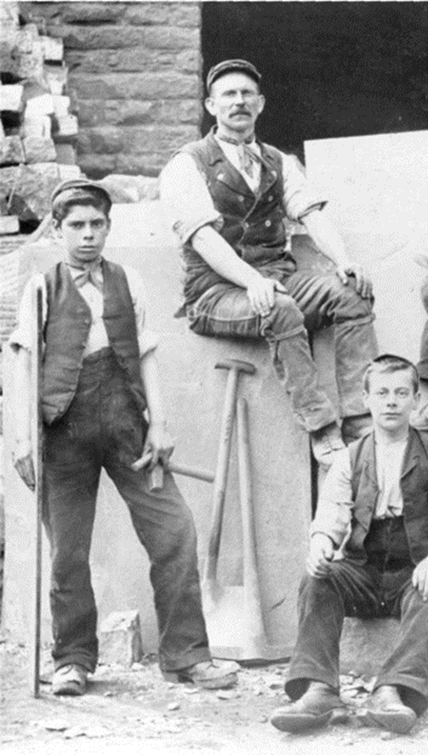 An unknown Master Mason and two apprentices in Sheffield 1851-1899: Picture Sheffield
An unknown Master Mason and two apprentices in Sheffield 1851-1899: Picture Sheffield
Though we have, as yet, no evidence that the aptly named Job Stone worked on St John’s, he might well have done. He was, as the newspaper notice of death put it, a ‘successful’ stonemason and he lived only a few hundred yards away from our church – at 43 Tapton Hill, in a terraced house, now demolished, to the right behind the first Tapton Congregational Church, then made of tin. He was from a family in Derbyshire and moved to Sheffield to improve his chances.
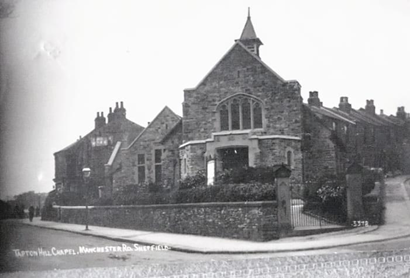 My thanks to Cãrólinã HR for this image from the early twentieth century
My thanks to Cãrólinã HR for this image from the early twentieth century
We have several newspaper references to him. In 1882 he was a building contractor as well as a master mason, advertising for transport to get bricks to a large site he was developing in Sandygate. Then throughout the second half of 1883 he places numerous advertisements seeking a tenant for a large property that he hopes to let in the neighbouring suburb of Broomhill. This was still the period of the Sheffield slump so perhaps his difficulties in letting this house reflect that. As Peter Warr comments, the developers in Ranmoor and the surrounding hills were not particularly successful. Yes, large mansions were built, but the area struggled to accommodate the more middling sort of resident of whom there were fewer than there were in Leeds or Manchester, because of the nature of our dominant industries.
Possibly discouraged by his hopes of making money as a property developer, Job Stone diversified again, setting up a business in the centre of town selling mortar. He still continued to be active in the building trade and in 1885 is mentioned in a long article in the Sheffield Daily Telegraph as a senior contractor for the building of a small orphanage, financed by the Church of England. The paper notes
‘The cost of the new cottage will be about £1,450. The contractors are Mr Job Stone, mason; Mr J Robertson, joiner; Mr C Chadwick, tiler; Mr J B Corie, plumber; Messrs Hodkin and Jones, plasterers. Mr J B Mitchell-Withers is the architect.’ June 1885
It is unusual to find a report of a building project at this period where the skilled craftsmen are named. But it is not uncommon in the local papers to find the stories of stone masons who have reached prominence in part because of their craft skills. The success stories to be found in the local papers are witness to the wide range of their abilities.
In 1885 the obituary of Mr Abraham Linacre describes the fortune he made in Australia from government contracts. He returned to Derbyshire to become an important philanthropist in Chesterfield.
In 1892 the obituary of Mr Glassby from Mexborough describes how he trained as a stone mason at the Norfolk Lace Marble Works, graduated from the Sheffield School of Art in 1857 then went on to create many of the sculptures to be found in Whitehall.
The most colourful of these successful masons was George Myers, 1803-1875, a ‘whitesmith’ from Hull who became the favoured builder of the famous architect Augustus Pugin. According to Pugin, Myers was ‘a rough diamond, but a real diamond’.
Were stone masons such as Job Stone more likely than those from other building trades (such as carpenters or slaters) to achieve success in other related areas? I suspect there were features of their trade that made this likely.
As we know, Sheffield had a wealth of skilled workers: in the metal and mining industries and in its building and brewing trades. It was, as the economic historian Sidney Pollard says ‘the biggest proletarian city’ in Britain. Metal and mining industries were sited in areas which geographically enclosed manual labourers in specific trades and separated them from other kinds of worker. This limited awareness of the range of different kinds of work. Social mobility was not easy from within these big industries. Setting up an independent business in such enterprises would have needed an unfeasible amount of capital.
The city’s stone workers on the other hand were scattered throughout the city. They had to move to find work. The itinerant and diverse nature of a stone mason’s work encouraged awareness of the range of social and economic opportunities potentially available. There was a significant amount to be invested in tools and possibly a stone-yard but not a huge outlay of capital. And their work, dangerous as it was, might well have contributed a degree of self-confidence which is necessary for the entrepreneur. The apparent permanence of stone, the discernment needed to differentiate its particular properties, the difficulties of extracting it and skill in shaping it must surely have contributed to a mason’s sense of worth and lent him the confidence to acquire other more lucrative skills. After all, evidence of his worth was enshrined in the buildings which surrounded him. As the mason says at the end of John Ormond’s poem ‘The Cathedral Builders’, ‘I bloody built that’.
The nature of a mason’s work also brought him into contact with architects and patrons who were people with some wealth. These social contacts must have increased the social confidence to develop a business, as Job Stone of Tapton Hill did.
Job Stone’s achieved modest success, a master mason employing five men, according to the 1881 Census. Then in August 1885, two months after he had achieved honourable mention as a contractor for the orphanage cottage in June, he died, at the age of just 44 leaving a wife and four children. His wife got a job in the workhouse and his children were housed there.
Warwick University holds what are called ‘The Obituaries’, lists of all those whose insurance with the Guild enabled their families to receive payment on their death – 25,000 of them between the years of 1832 and 1921. Most of the payments record the cause of death.
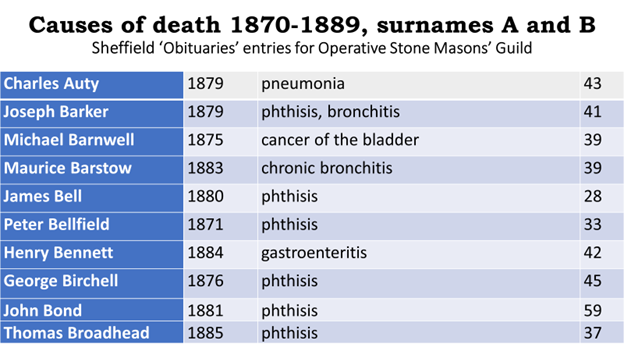
As you can see from these records, 8 out of the 10 Sheffield masons whose deaths are recorded here died of lung disease. Only one lived beyond the age of 45. Having skimmed the rest of the entries, this is a pattern that persists across the years and localities. Being a stonemason may have been a respected and relatively well-paid trade, offering chances for advancement, but it more or less ensured an early death. Job’s death certificate records he too died from lung disease caused by his trade: ‘stone masons consumption some years’.
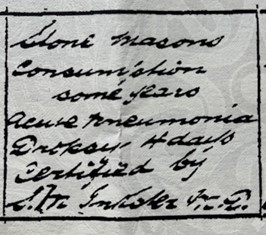
Unlike many beautiful buildings, our church may not have been paid for by the profits of active oppression but it was certainly built by men whose health was destroyed by the work they did on it. I wish we knew more about them and I trust that with your help and further research we will.
Val Hewson and Susan Roe are at work on finding records of these men’s lives. I believe that our church warden, Mark Gregory, has been exploring the higher reaches of our roof in search of the initials of masons who wished to leave their mark on their creation. I look forward to Mark’s dispatch.
Mary Grover
Blog 2 -‘Undercutting’: Where was our stone shaped?
Monday 29th January 2024
The size and elegance of St John’s church conceals the fact that it is built close into the bank behind it and on a remarkably small site. So small that we have no churchyard. This caused tensions between us and Fulwood Church who, when the church was built, were instructed by the Diocese of York to bury our dead.
So how was the stone to be worked in such cramped conditions? There would seem to be no space for a covered yard, essential if the stone were to be worked on site. Having a covered yard on site would also have been very expensive. The General Cemetery Company minutes notes on the 12th January 1838 that ‘£67 16s was expended in erection of stone mason’s workshop’. Fine if the workshop was to be used for centuries to come, but an expense difficult to justify for a relatively short-term project, even if there had been room. Such a sum would have paid the wages of a skilled stone mason for 231 days in 1838.
James Stone, a singer at St John’s and trained stone mason, concludes that most of our stone would have been worked off-site, according to detailed architect’s plans, and imported ready finished. Yet, only sixteen years before the first stone was laid, local stone masons had won a nationally significant victory to work stone on site.
Sheffield stone masons were nationally known for being strongly unionised and organised. Though, during this period, they never won their campaign for a nine-hour working day, in 1862 the masons did achieve this notable victory. The masons building Sir Mark Firth’s Oakbrook Hall (now Notre Dame School and just over the road from the church) succeeded, after a punishing strike, in ensuring that masons belonging to the Operative Stone Masons Guild would finish stone on site unless they agreed that it could be imported in its finished state from elsewhere. This was to prevent workers from other localities undercutting them and doing the work at a cheaper rate than the one negotiated with the immediate employer. The sandstone used to build much of the exterior of our church comes from Oughtibridge where labour was likely to be cheaper than it was in the newly developing suburbs of Ranmoor. So, it would have been cheaper for employers to bring it in ready finished from the Oughtibridge quarries where it was extracted.
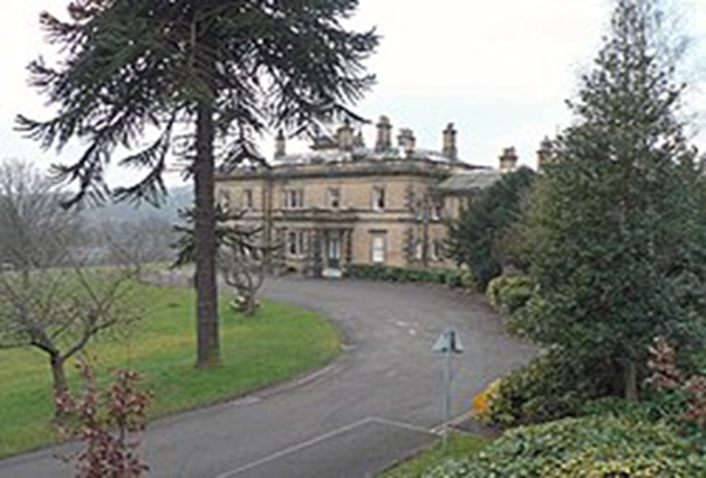 Oakbrook Hall, now Notre Dame School
Oakbrook Hall, now Notre Dame School
One of the reasons why the stone masons won this victory when many other trades were starved out of similar disputes was because of the strength of their union in the mid-nineteenth century. Payments to The Operative Stone Masons Guild insured a mason’s tools, paid for his funeral and supported his family after his death. In our quest for the masons who built our church Val Hewson and I have found these insurance records invaluable. Yet the only Sheffield mason who features in the local papers for his achievements rather than his mis-steps, is a master mason whose membership is not recorded by the Guild which was only open to the rank and file.
My next post will be about this successful master mason, Job Stone, who lived on the hill-side behind the church and whose life and death tells us much about the conditions under which a local mason had to work in the 1870s and ‘80s.
Mary Grover
Blog 1 - "The Rearing Dinner"
Monday 15th January 2024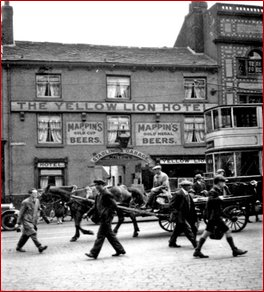
The ‘Rearing Dinner’
On May 1878, 11 months after starting work on our first church, the 100 workmen on the building team were celebrated. On the point of completing the outer walls and roof, they sat down to what was called ‘a rearing dinner’ at the Yellow Lion in Sheffield’s Haymarket. They were guests of John Newton Mappin, the donor of our church. Luckily an image of this pub has been preserved and on its frontage is blazoned the source of our donor’s wealth: ‘Mappin’s Gold Medal Beers’.
A rearing dinner dated from medieval times when a great hall would have been built around at least two timber arches. A mighty frame was constructed flat on the ground by the carpenters but it took the combined forces of all the workmen who had played a part in the construction of the building to raise or ‘to rear’ the structure from the horizontal to the vertical. No wonder celebrations were in order. You might enjoy Harrison Ford’s involvement in an Amish barn raising and the feast that followed in the 1980s’ film Witness (
https://youtu.be/dPLb_POsC7M?si=MCfKi7BVf2pZP1p6 ).
Mappin, with characteristic generosity, supplied the 100 masons, plasterers, carpenters, glaziers and labourers with a ‘repast’ so lavish that it was reported in the local papers.
At the end of the meal it was time to toast all those responsible for our building. Understandably, the health was drunk of our benefactor, Newton Mappin. But no toast is recorded to the men he paid to do the job: not even the foreman or master mason. It is this absence that has inspired us to launch the community history project which we call Scissors Paper Stone.
The names of those who created the fabric of a city are rarely recorded. If they make their way on to the pages of the local newspaper it will usually be because they were criminal or victim of an industrial accident. As my colleagues Val Hewson, Sue Roe and I delve through the range of records that might help us write their histories I bear in mind the words of that great historian of the building trades, Raymond Postgate:
Carpenters, masons and bricklayers have expressed the ideals and civilisation of their age as much and as well as writers, soldiers and statesmen.
The Builder’s History (The Labour Publishing Company 1923) page 2
Over the next six months I will keep you in touch with all that the Scissor Paper Stone project is uncovering about many aspects of our church’s history. On Saturday 6 September, at 5.30 pm, Val Hewson will be giving a talk about what we have discovered about the builders of our church. This Heritage Open Day event will be held in St John’s, at 5.30 on Saturday September. Do join us and contribute in any way you can to our investigations.
Mary Grover 14 January 2024